



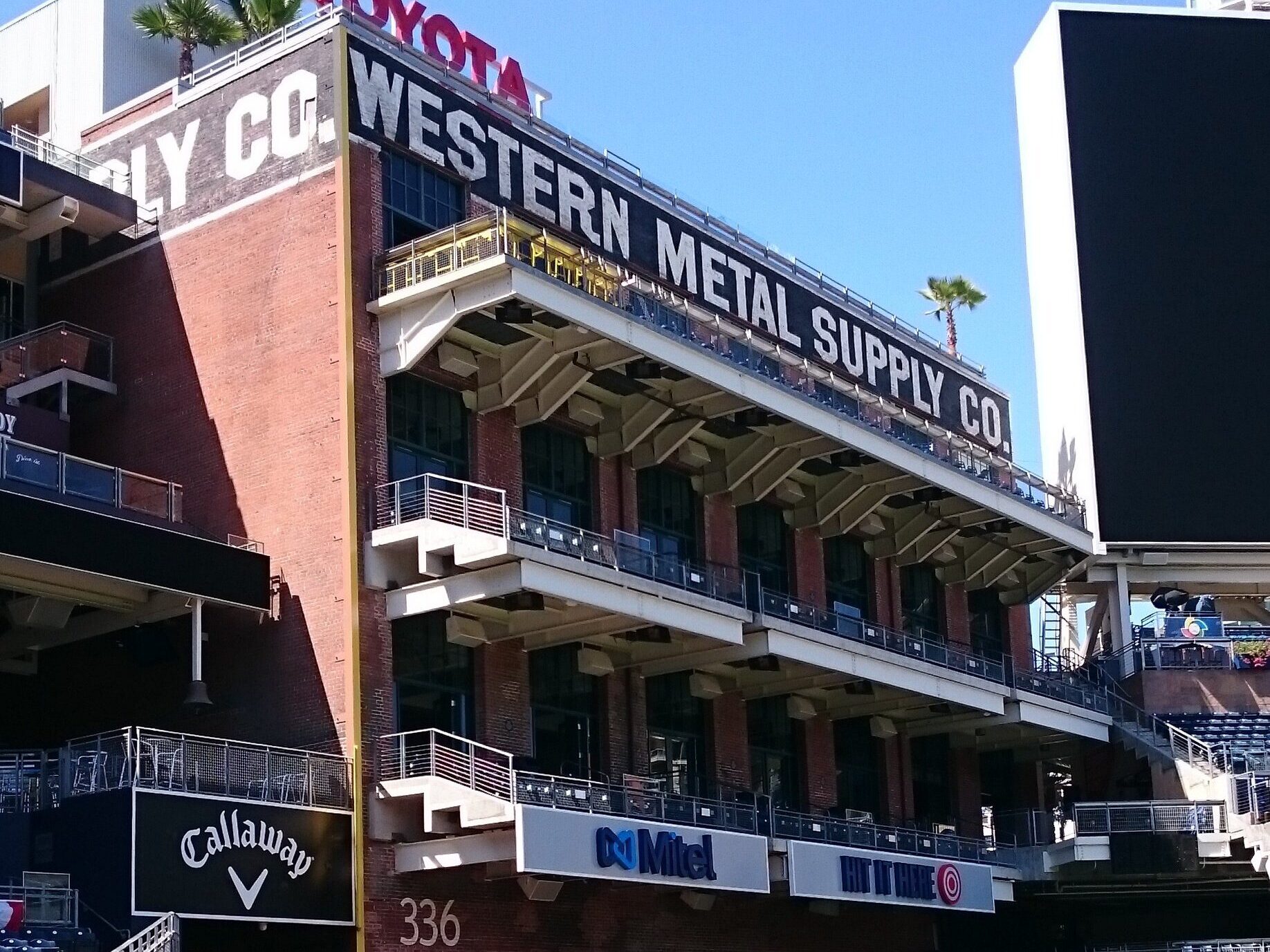

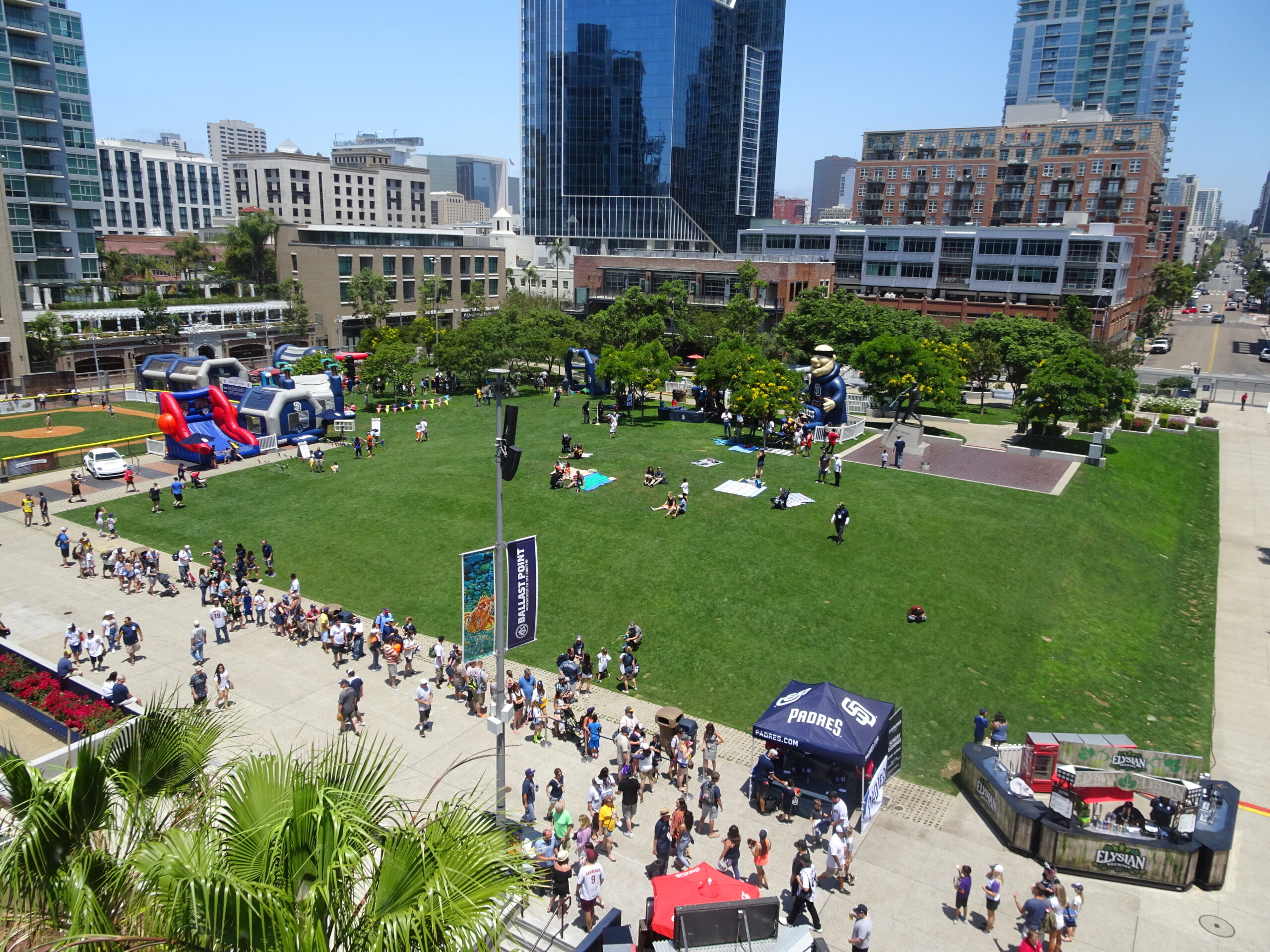
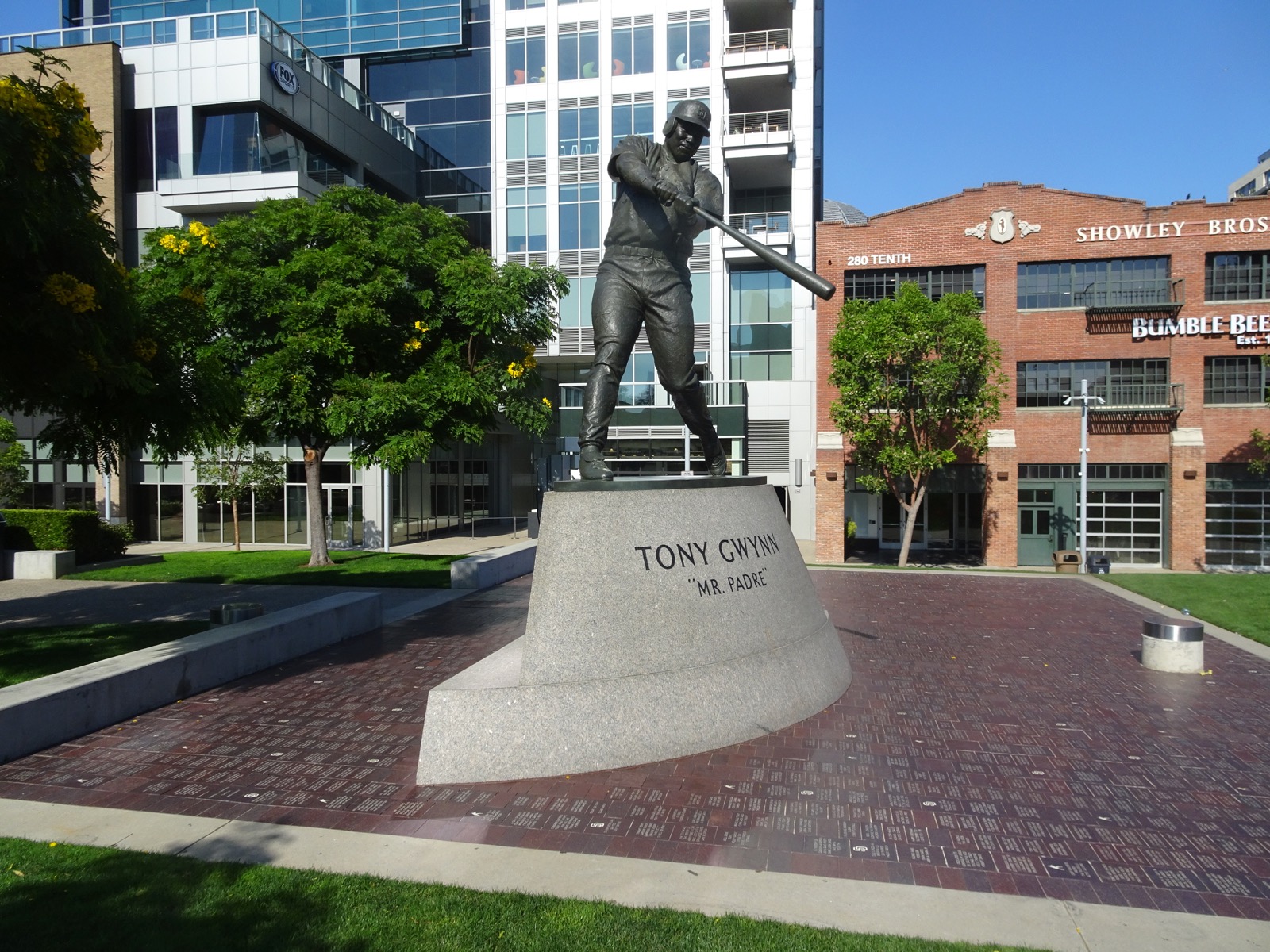
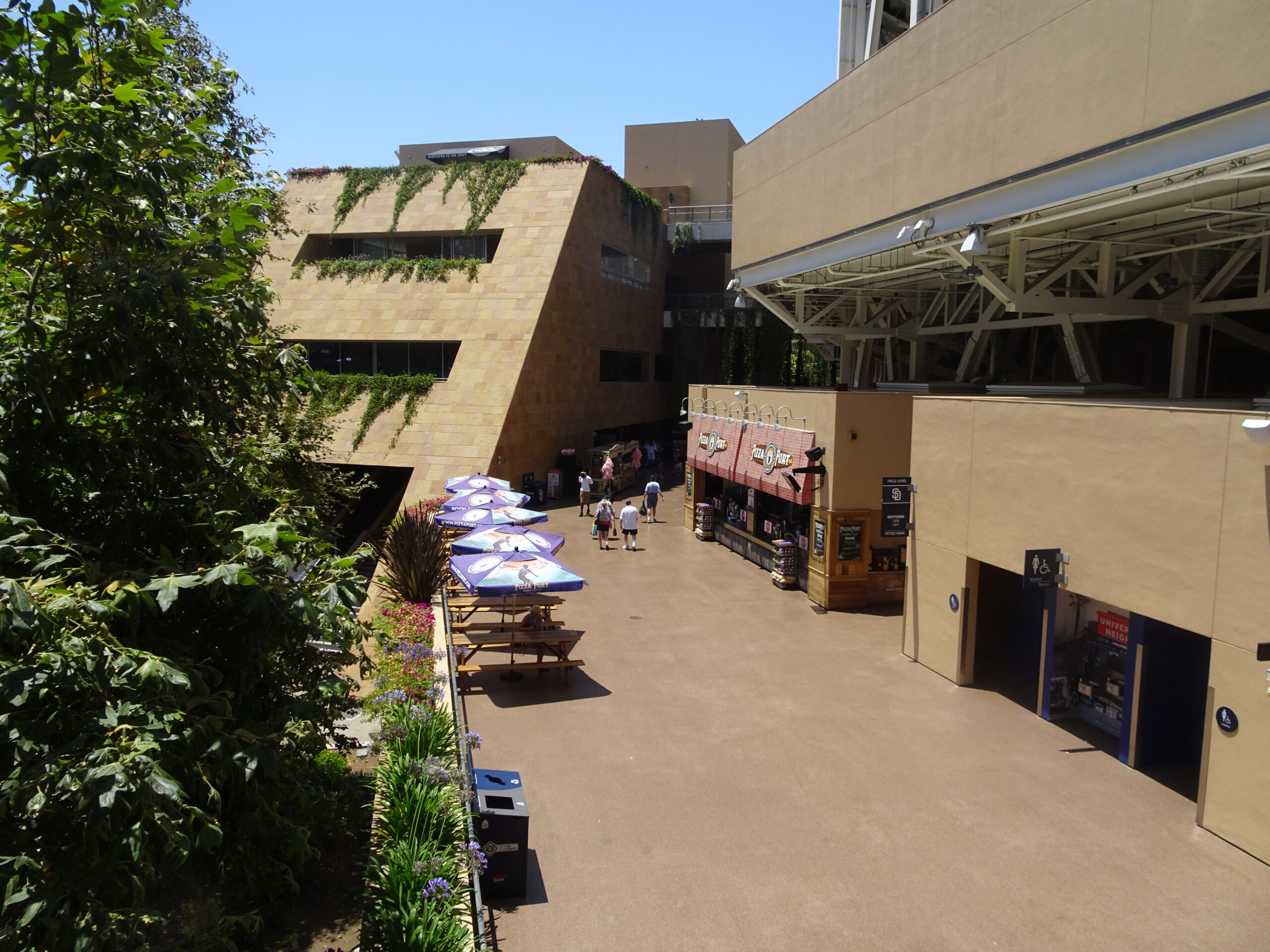
Petco Park
| Setting | 19/20 | 2 Thumbs Up |
|---|---|---|
| Locale | 5/5 | 2 Thumbs Up |
| Accessibility | 4/5 | 1 Thumb Up |
| Neighborhood Local Scene | 10/10 | 2 Thumbs Up Star |
| Architecture & Aesthetics | 55.5/65 | 2 Thumbs Up |
|---|---|---|
| Exterior Design/Aesthetics | 17/20 | 2 Thumbs Up |
| Interior Aesthetics/Visuals | 33.5/40 | 1 Thumb Up |
| Concourse Aesthetics | 5/5 | 2 Thumbs Up Star |
| Functionality & Essentials | 39.5/50 | 1 Thumb Up |
|---|---|---|
| Sightlines: Field Proximity | 14/15 | 2 Thumbs Up |
| Sightlines: Seating Geometry | 5/5 | 2 Thumbs Up Star |
| Seat Comfort | 6.5/9 | Thumb Sideways |
| Concourse Functionality | 8.5/15 | 1 Thumb Down |
| Scoreboards/Tech | 5.5/6 | 1 Thumb Up |
| Amenities & Features | 46/50 | 2 Thumbs Up Star |
|---|---|---|
| Concessions: Food Variety | 5/5 | 2 Thumbs Up Star |
| Concessions: Food Quality | 5/5 | 2 Thumbs Up Star |
| Concessions: Craft Beer/Other Drinks | 5/5 | 2 Thumbs Up Star |
| Social Gathering Areas/Restaurants | 10/10 | 2 Thumbs Up Star |
| Premium Seating/Clubs | 7/9 | 1 Thumb Up |
| Historical Exhibits, Memorabilia, Art, & Other Displays | 8.5/10 | 1 Thumb Up |
| Kids Areas/Other Entertainment | 5.5/6 | 1 Thumb Up |
| Atmosphere, Vibe, & Policies | 12/15 | 1 Thumb Up |
|---|---|---|
| Fan Support/Attendance | 4/5 | 1 Thumb Up |
| Ballpark Traditions/Gameday Presentation | 3.5/5 | Thumb Sideways |
| Ballpark Policies/Staff | 4.5/5 | 1 Thumb Up |
| Adjusted Raw Score | 172/200=86 |
|---|---|
| Bonus | 4 |
| Curve for All 7 | 7 |
| Final Score | 97 |
|---|---|
| Ranking | #1/30 |
|---|---|
Standout Design Concept Finally Reaches Full Potential in San Diego
Petco Park’s incomparable amenities and superior sightlines, along with its original exterior architecture, groundbreaking concourse design, and perfect setting, create the best ballpark experience in Major League Baseball, despite shortcomings in interior aesthetics
By: Cole Shoemaker
Originally published in 2009 and updated in 2017, ratings above are up to date for 2024, but this review below may be outdated and will be updated at some point; reviews and ratings are “living pages” updated yearly when necessary
Back in 2009, I wrote that Petco Park was the J.D. Drew of ballparks.
The metaphor was simple: like the player, Petco Park was great, but it had all of the tools to be the greatest in baseball and failed to put everything together. Petco Park had (and has) incredible originality, the best local scene in baseball, top-of-the-line amenities, superior sightlines, beautiful landscaping, an unbeatable climate, an unmistakably high-quality exterior design, and a gorgeous contextually based interior aesthetic, all centered around elevated concepts.
While he was always a good player, things never really materialized for J.D. Drew to the degree that was expected. Luckily for Petco Park, stadiums evolve and don’t have expiration dates like baseball players. J.D. Drew never became that game-defining player, but I think Petco Park has become just that.
By my careful assessment and analysis, examining every metric top to bottom, Petco Park is the best ballpark in baseball, and it isn’t particularly close. With a series of improvements in the mid-2010s, Petco Park’s enhancement projects had been brewing in my mind for a while, but the park blew me out of the water during my revisit in 2017.
So, how did Petco Park become the best ballpark in baseball?

Well, the Padres’ home was always a top-10 ballpark in my book, just one that was more defined by missed opportunities. So, much of what I’ll detail already existed. As a design concept, it’s always been the most original and ambitious ballpark of the post-1990 era.
The idea of removing the restaurants and other amenities away from the seating bowl, thus carving out an open air, canyon-like concourse, is a welcome innovation. You’re basically splitting the ballpark up into a number of outer structures separated from the seating bowl, with the main concourse open to the sky and bridges above connecting the upper deck concourses to the outer “garden buildings.” Other concepts, such as “neighborhood seating,” the suite towers, and the “Park in the Park,” are undoubtedly novel.
Through a series of tweaks and enhancements, those concepts have been refined into something unmistakably brilliant in practice.
With its superior setting, Petco Park is beautiful, despite not equaling the aesthetics of PNC Park (Pittsburgh) or Oracle Park (San Francisco). Unlike those two, however, the Padres’ sparkling pad is now nearly flawless in more objective categories, especially in terms of amenities. I think it’s through that equation that you get the best ballpark in baseball. Let’s look at the areas of improvement it underwent in the 2010s and some other specifics.
One of the primary complaints about Petco Park was how the outfield concourse and the “Park in the Park” wasn’t well integrated with the rest of the interior aesthetics. By removing the silly sandbox (“the beach”) and adding a new “social space” in that area, the fan-field connection became much better. (You know, where actual fans can enjoy the game as opposed to five year-olds playing in the sand who look like they’re about to get smacked by a home run ball.)
Perhaps most importantly, development around the park continues to accelerate, enhancing Petco Park’s setting and interior visuals. Compare this to the former look. Wow! I think we see the redevelopment project at full fruition today, with nearly every space occupied by a condo, hotel, or office building, except the Park in the Park. It’s a great look: an urban village with a park in the middle.
Can you think of another park where the views have improved so much?
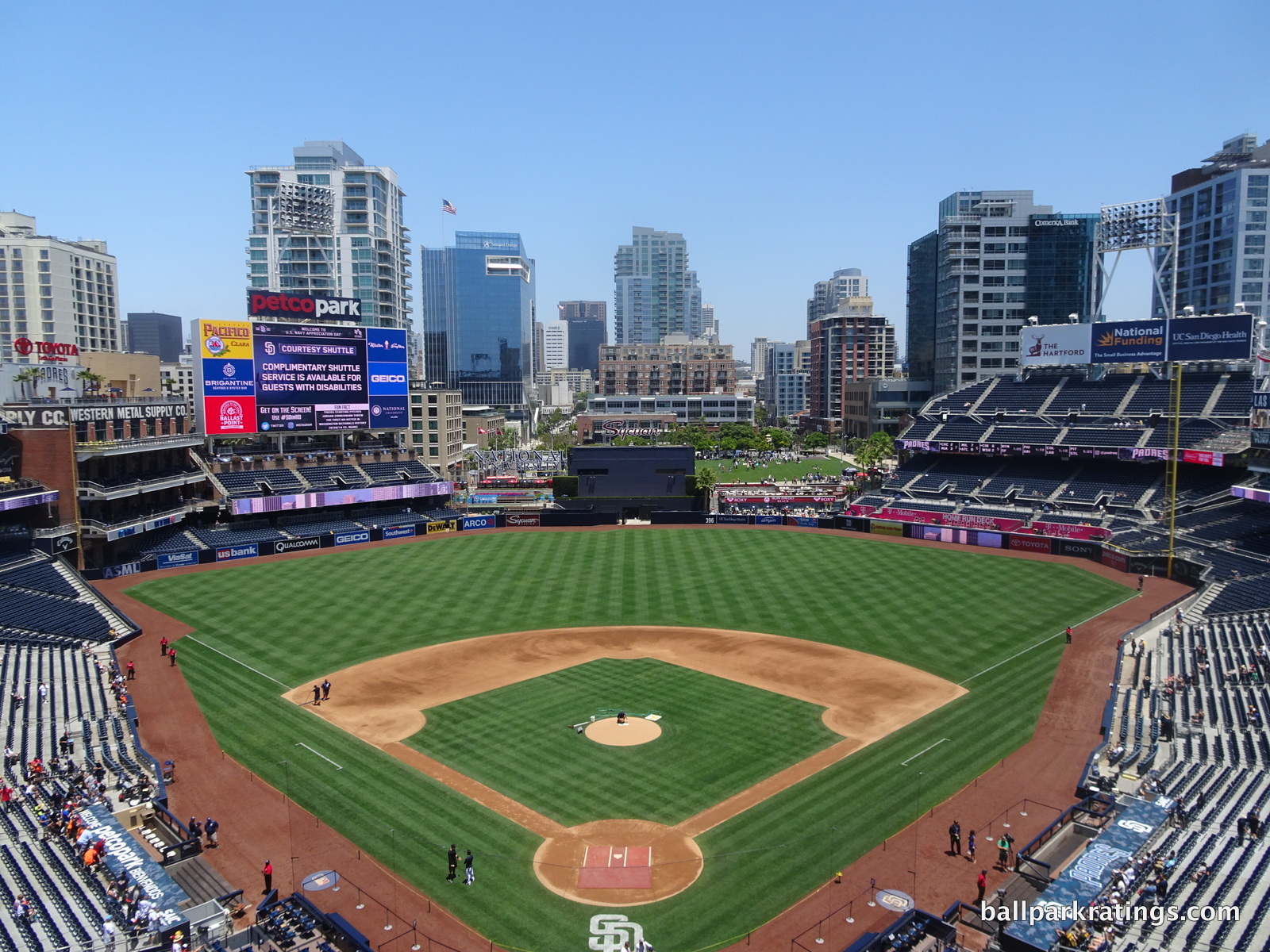
With a lot of these ballpark categories, you get anchored into giving acclaim just based on reputation. When discussing ballpark food, for example, the reflective answer is always that AT&T Park in San Francisco or Safeco Field in Seattle has the best ballpark food. This was a bit of a sore spot for Petco Park in the early years.
During the 2010s, Petco Park made a quantum leap in this department. The Padres now showcase a wide variety of BBQ, Mexican, Latin, Asian, sandwiches, and seafood, all provided by local, high quality restaurants in the San Diego area. Both the breadth and depth are remarkable. When you couple the cuisine with San Diego’s craft beer, I think you have a system of concessions that are the best in baseball. This is perhaps the most remarkable ballpark transformation this decade in any category.
Another common criticism of Petco Park was the lack of Padres’ history integrated into the park. People always remarked that the structure was beautiful, but it didn’t look like a ballpark, and you couldn’t tell who plays here. This was rectified before the 2016 All-Star Game with a tasteful interactive museum. It seems like the Padres went down the list of ballpark shortcomings and poured millions of dollars into correcting them.
When you add these improvements to an already solid array of features, Petco Park absolutely blows everyone else out of the water in terms of amenities. The Padres’ series of restaurants and bars was always their strong point, and they continued to astonish me upon my return visit in 2017.
Just to hammer home the point, let’s provide an exhaustive list. Note that all of these areas are accessible to anyone with a ticket, and these are bona fide destinations, not concession stands or walk-up bars. On the main concourse, Petco Park has (1) an accessible outfield social bar overlooking center field, (2) a full-service restaurant/bar behind home plate, (3) and an indoor wine bar behind home plate. It has a full-service restaurant/bar in the (4) Western Metal Supply Co building. On the accessible Toyota Terrace level, the Padres have a (5) full-service restaurant/bar, (6) a full-service sushi bar, (7) an informal fast casual eatery and bar, and (8) an outdoor bar overlooking the San Diego Bay and Coronado. In the upper deck, we have yet another (9) full-service restaurant and bar, open to the sky and providing great views of the ocean. The upper deck also has (10) an informal fast casual dining area on top of the warehouse. That’s before getting to any picnic areas or any premium seating clubs.
The exceptionality of having such a wide array of restaurants and bars open to all fans can’t be emphasized enough.
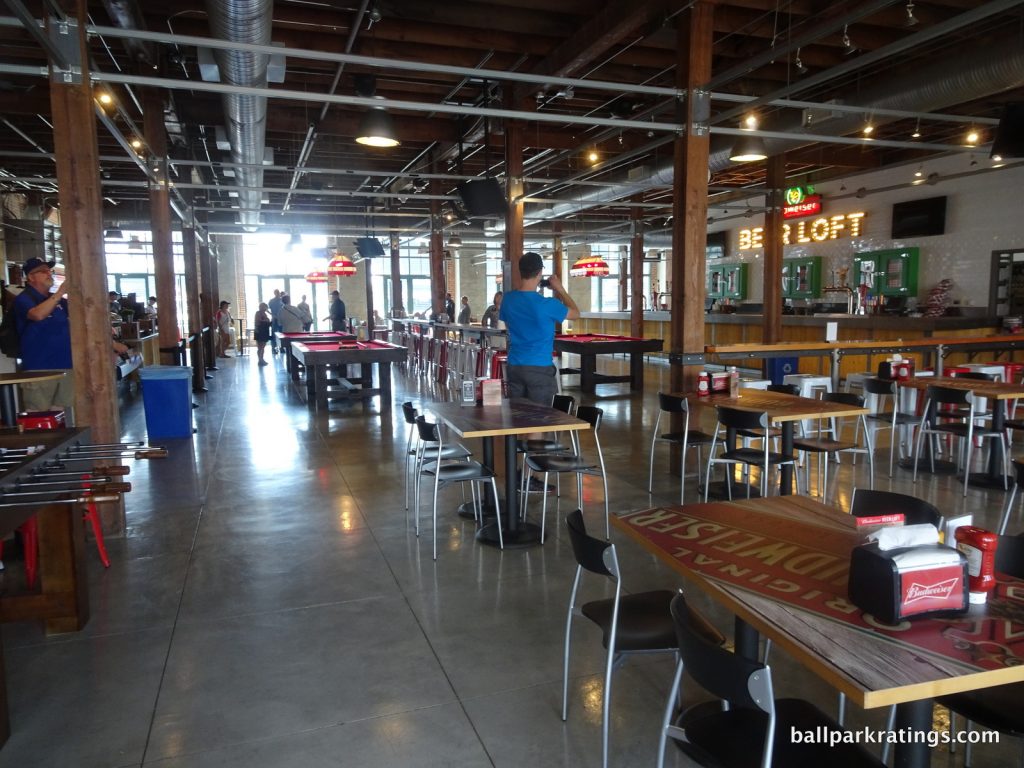
The Padres’ intention of opening up most spaces to all ticketed fans is notable, in what could be construed as an “anti-Yankee Stadium,” mostly free from exclusion and division. Looking at the amenities overall, if there’s one word I’d use to describe them, it would be overwhelming.
I often remark on ballparks that take more than one day to explore, but Petco Park takes at least three days. After enjoying the exemplary regular concession stands, all 10 eateries and bars, the premium clubs, the museum, and the entertainment in the Park in the Park, I was actually exhausted by the end of the weekend.
Make no mistake: Petco Park is inarguably the best park in baseball for not watching the game.
The fact that Petco Park so overwhelms a ballpark fanatic hints at the stadium’s only objective flaw: the concourse functionality. I was hoping my memories from 2009 were exaggerated, but Petco Park is very difficult to navigate. At every turn on the main concourse, you’ll encounter some encumbrance. There is no ease of circulation here, as moving from the outfield to the infield even requires ramps down the right field line. The concourses are mostly closed from the field as well. I’ll elaborate later.
While you could enjoy an entire weekend here without ever seeing a pitch, there’s another layer of peculiarity to that fact: while Petco Park is the best park in baseball for the non-baseball fan, it’s also the best park in baseball for watching baseball.
As has been publicized, Petco Park has some of the best seating cantilevers in baseball. The terrace level (mezzanine) extends almost 15 rows over the seating below, and the upper deck extends far over the mezzanine. While PNC Park is lower, Petco Park is actually closer to the field (horizontally) from the upper levels. With no separate suite levels, Petco Park isn’t prohibitively high either. While there have been complaints about outfield obstructions from left field, the Padres have baseball’s best sightlines judging by both field proximity and seating geometry.

So what’s in between watching baseball and not watching baseball? Is this just a pedantic way of telling you Petco Park is the best stadium in baseball overall? Do these two facts make Petco Park literally the perfect ballpark?
No, actually. While the exterior is striking, many of my complaints about the interior aesthetics still stand. As a general theme, Petco Park is too disjointed, built around an old brick warehouse then reframed through the prism of a sandstone nautical motif. That doesn’t make much sense conceptually.
While the Gaslamp Quarter seeps into the ballpark’s aesthetic schema, I wish we saw more elements reminiscent of the San Diego Bay. Where are the water features, the plush greenery, and the palm trees of San Diego? Yes, they are well integrated into the concourses, and you see these elements through views from the restaurants/bars, but I would have liked to have seen those features throughout the outfield.
If Petco Park looked more like that rendering, we might literally have the perfect baseball stadium. As it stands now, the park’s interior aesthetics are good but not great, failing to reach high bars established in Baltimore, San Francisco, and Pittsburgh.
While I think it’s finally getting the recognition it deserves in the 2020s, the reason you don’t see Petco Park at the top of every ballpark list is because fans who make these lists on a site like Buzzfeed or Thrillist just look at pictures of the panoramic views. Petco has always been highly regarded, but it’s not instinctively great because so much of what you read on social media is from people ranking ballparks based on pictures. If you take time to actually explore every ballpark in baseball, I think you’ll find the notion of Petco Park being the best ballpark quite persuasive.
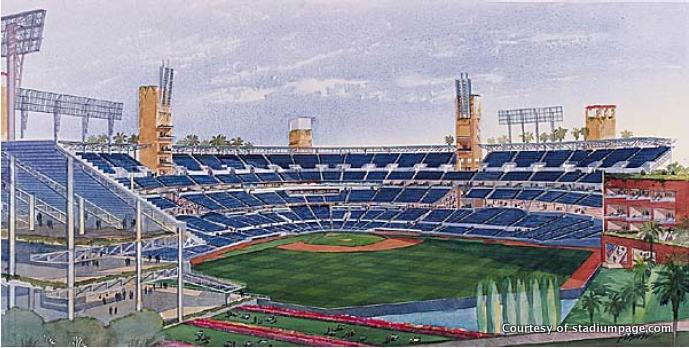
You’ll note that other great ballparks fall in the 87-92 range of my ratings system. Most other parks in the middle tier (#11-#22) are tightly distributed in the 80-86 range. At 96.5, Petco Park is an outlier (in an informal sense of the word), head and shoulders above all other Major League Baseball stadiums across the North America.
Despite not equaling the interior aesthetics or panoramic views of the best parks, Petco Park is good enough in those respects, while being nearly objectively flawless unlike even more beautiful parks in Pittsburgh and San Francisco. And I certainly don’t want to undersell Petco Park’s raw beauty. At a basic level, it almost resembles the well-roundedness of Comerica Park in Detroit (yes, you heard me). However, Petco Park begins to lap the field by possessing many superlative qualities like the best local scene in baseball, arguably the best exterior architecture, the best concessions, the best series of restaurants and bars, the most beautiful concourses, the best sightlines, and arguably the best amenities overall.
In its best scoring categories, Petco Park is often exceptionally outstanding, all the while lacking any disqualifying or glaring flaws in even its lowest scoring categories.
Petco Park has staying power as the best ballpark in Major League Baseball for years to come. Look, this whole thing is in good fun, but given the margins by which the Padres’ park exceeds others in our carefully considered and meticulously weighted methodology of rating baseball stadiums, I don’t think it would be unreasonable to call this one of the best sporting facilities in the world.
Setting
Locate:
The park is nestled in the southeast perimeter of the rapidly growing Gaslamp Quarter. Six years after opening, the location quickly became one of the best in baseball, often sited as a positive case study on downtown revitalization efforts. The ballpark fits wonderfully in its surroundings, as it has become an integral part of downtown.
Well, as of 2017, it looks like the growth isn’t stopping. With so much activity north and the stunning San Diego Bay to the south, the Padres might have hit a stroke of genius with their location.
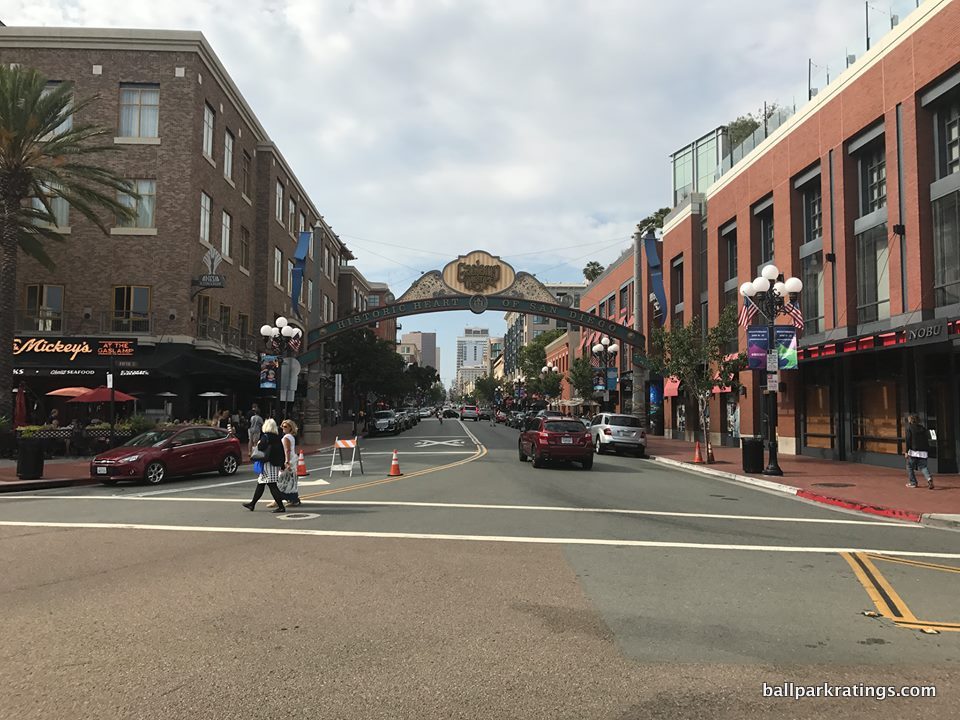
The park itself is located between 10th and 7th avenues, south of J Street. Separating the San Diego Bay and the park, the south side is bounded by the San Diego Trolley light rail tracks along Harbor Drive. The San Diego Convention Center is also just south. Two of the ballpark’s outfield entrances are located by K Street near 7th and 10th avenue. The main entrance behind home plate faces the trolley station.
The entirety of the Gaslamp Quarter is located north and northwest, while East Village is situated to the northeast.
Parking issues were publicized during the ballpark’s infant years, but the situation has gotten better. The public trolley system is always available.
Score: 5/5
Local Scene
Sport Illustrated did a fan survey in 2008 that rated Petco Park’s neighborhood the best in baseball, and it wasn’t even close. Wrigley was a somewhat distant second. Since that time, the Gaslamp Quarter has continued to grow.
The neighborhood started to go through a period of urban renewal in the 1990s, but Petco Park really jumpstarted the effort. According to Google Earth, Petco has the highest density of establishments in the direct vicinity of any ballpark in baseball.
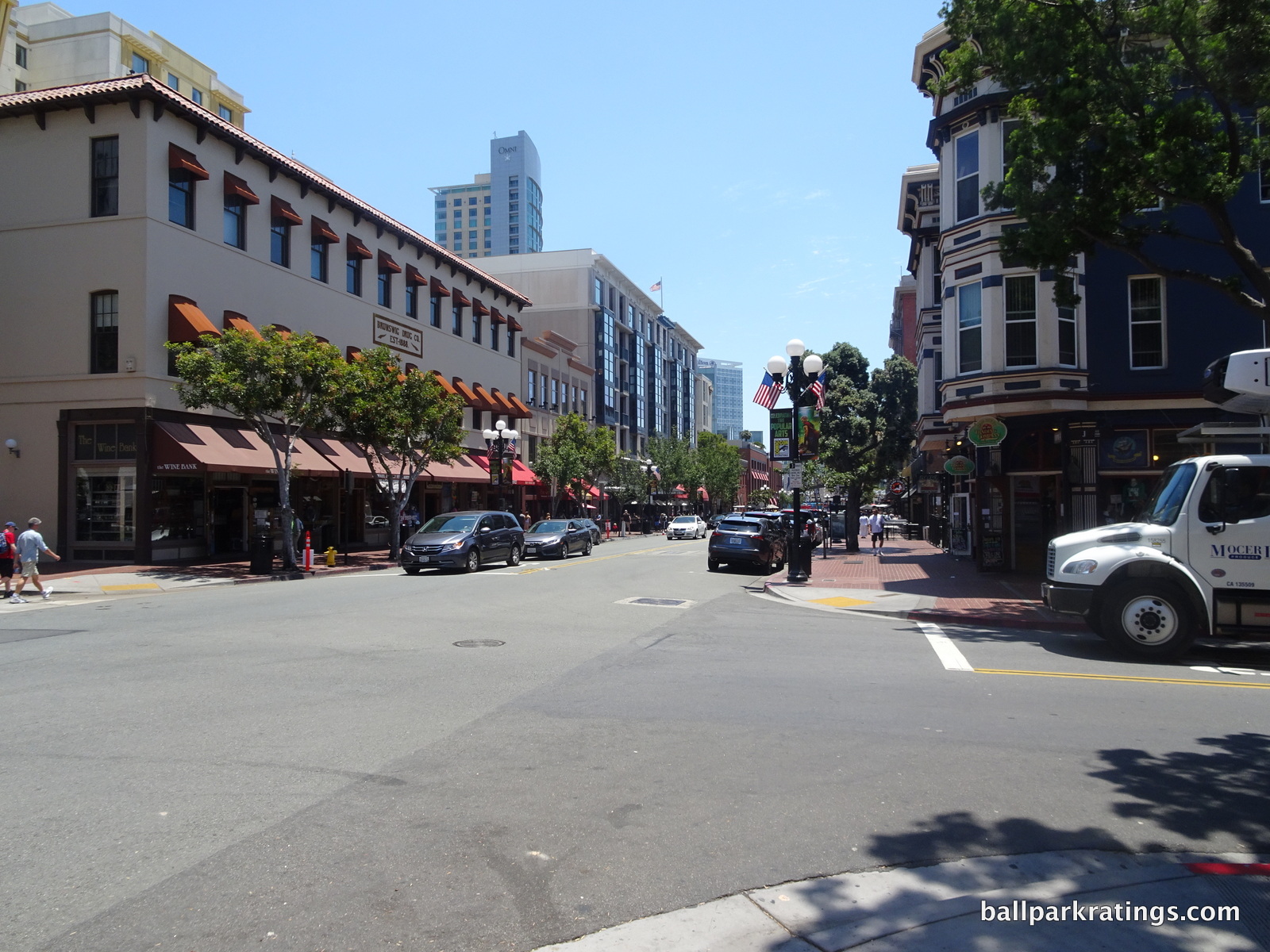
The district itself covers 16 ½ blocks, extending all the way from Broadway to Harbor Drive. It includes over 90 historic buildings, most of which have been adaptively reused as restaurants, shops, and nightclubs, similar to the Western Metal Supply Co. building integrated into Petco Park itself.
If you really want to get the San Diego experience, try and stay here, or at least spend a couple of hours walking through the area. Nice hotels near the park include the Hard Rock Hotel, the Marriott Gaslamp Quarter, the Kimpton Solamar, the Hilton Gaslamp Quarter, and the Omni San Diego Hotel. Hotels on the seaside of Harbor Drive overlooking San Diego Bay include the Manchester Grand Hyatt, the Marriott Marquis Marina, and the Hilton Bayfront.
All have pros and cons, but the Omni is probably your best bet, as it even features a sky bridge connecting guests to a private ballpark gate. We stayed here and had a blast. We didn’t use the sky bridge for entering the park (because the Park in the Park gates open earlier, 2.5 hours before the game), but it’s a very nice convenience for exiting the park.
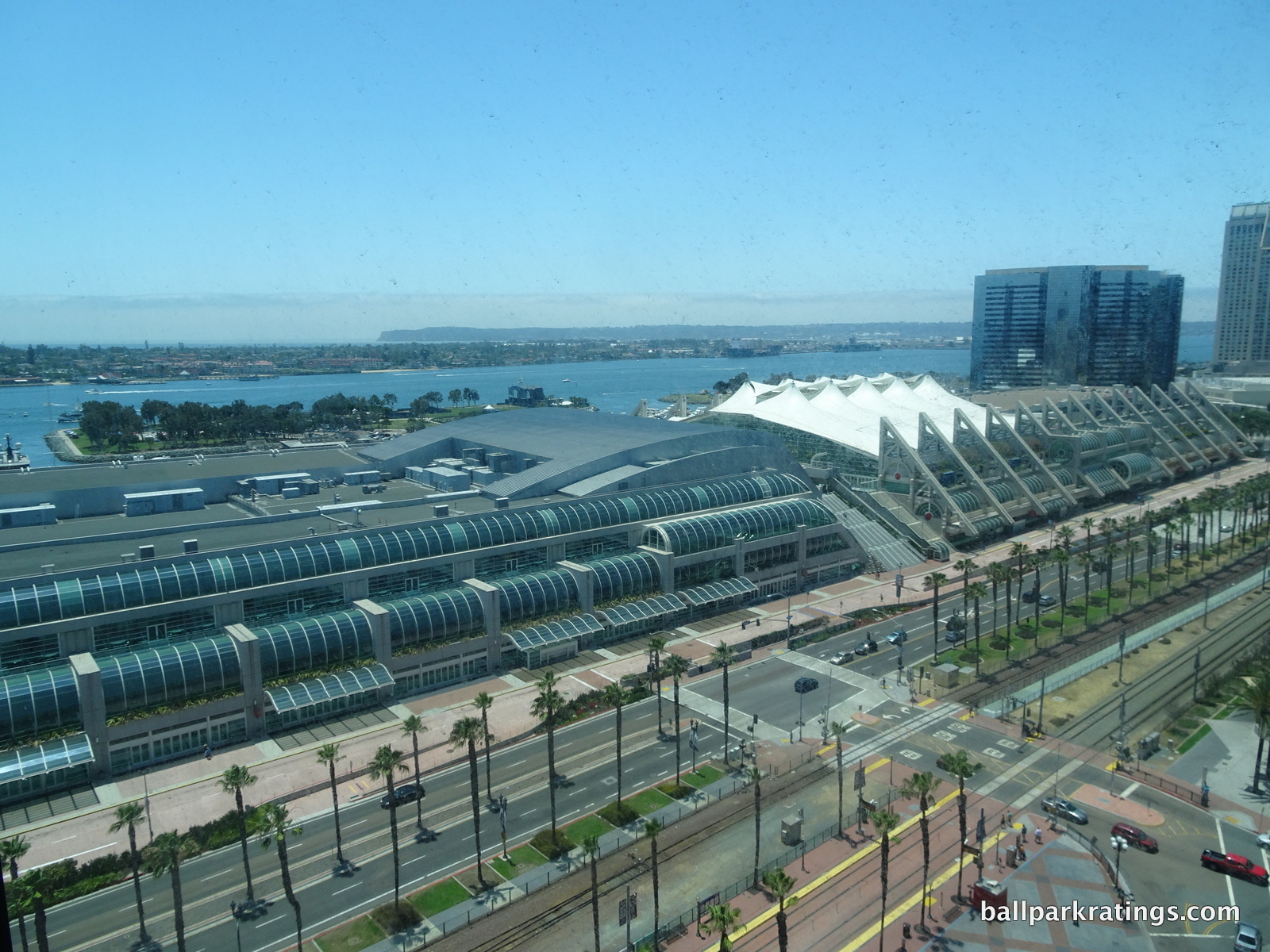
What’s cool is that exit and reentry through the sky bridge is seamless during the game, so if you want to go back to your hotel room for an inning, it’s just a minute walk away. Think of it as your own suite at the ballpark! This is certainly an added bonus to staying at the Omni.
Notable bars and restaurants in the area that we specifically checked out include Werewolf, La Puerta, Searsucker, Bice Restaurante, Café Chloe, Café 21, the Top of the Hyatt, and the Altitude Sky Lounge. Definitely take time to do your own research and explore the area.
Petco Park features the most vibrant and authentic local scene a ballpark could offer. This is the best in baseball, outdoing scenes in Denver, Atlanta, and even Chicago.
Score: 5/5
Total: 10/10
Architecture & Aesthetics
Exterior Design
Despite any esoteric quibbles from an outside architectural perspective, Petco Park should be commended for being one of the only ballparks in baseball to constitute true “capital A” architecture. The usual standard has all the flare of a suburban office park.
At the very least, the effort is laudable. Couple that with the outstanding concept, novel use of materials, great contextual relationship, and raw aesthetic attractiveness, and Petco has one of the best exterior designs in baseball.

San Diego features one of the first ballparks to radically depart from the traditional idea of what a ballpark façade should look like. While the tension between the Western Metal Supply Co. building and the ballpark itself is tenuous (discussed more in interior aesthetics), we see no red bricks throughout the design itself. It received some criticism upon opening for not looking like a ballpark, but there is no overlooking Petco Park’s actual architectural merits.
Designed by Antoine Predock, the ballpark’s façade evokes a jagged postmodernism rooted in the Southwest. The rough blocks of sandstone, characterized by a rich ochre earth tonality, were imported from India. Sandstone marks much of the façade, with lighter stucco filling out some of the inner areas.
Natural, contextual tones are used: the sandstone and stucco mimic the cliffs of Torrey Pines in both color and texture, while the exposed steel cultivates a nautical marine motif. The slopes and edges of the garden buildings are reminiscent of the Mayan pyramids. The white railings and steelwork recall the ships in the nearby San Diego Bay, and the subtle hues of blue represent the water. Note the plush greenery and flowers cascading down the sandstone.
This is certainly one of the best concepts in baseball.

At night, the landscaped beams and concourses are lit in soft beige and blue making the exterior a sight to behold. The vibrant landscaping around the ballpark is superb. The Padres should be commended for striving to create an authentic sense of place, instead of following the nostalgia aesthetic like sheep.
A perfect visual entry point, the home plate plaza area features a gorgeous waterfall, cascading over sandstone. The exterior is both conceptually groundbreaking and strikingly attractive, all while capturing the spirit of San Diego.
It doesn’t get as much attention as it should, as this is in a three-way tie for the best exterior in baseball.

Score: 8.5/10
Interior Aesthetics
While the design has been strengthened through continued contextual development in the Gaslamp Quarter and aesthetic alterations to the right of the batters’ eye (where the Craft Pier was added), much of what I wrote in 2009 still applies.
The white steel and gold sandstone on the outside, along with the garden-like concourses, are wonderfully executed. It’s not only different, but it fits in with the San Diego culture well.
On paper, the interior should be just as good, perhaps even better. There’s no doubt that Petco Park had an elaborate and ambitious aesthetic vision, which should alone be commended, but it just wasn’t as successful in execution. Fortunately, because the setting is so good, San Diego still does well in terms of interior aesthetics by default. But it’s not as good as it should be.
I’ll start with the positives: the warehouse integration is fairly well done, as has been widely publicized. Even though the red brick doesn’t fit with the rest of the design, it still works, despite creating a slightly schizophrenic sensibility with the clashing of elements. I’ll get to that in a minute.
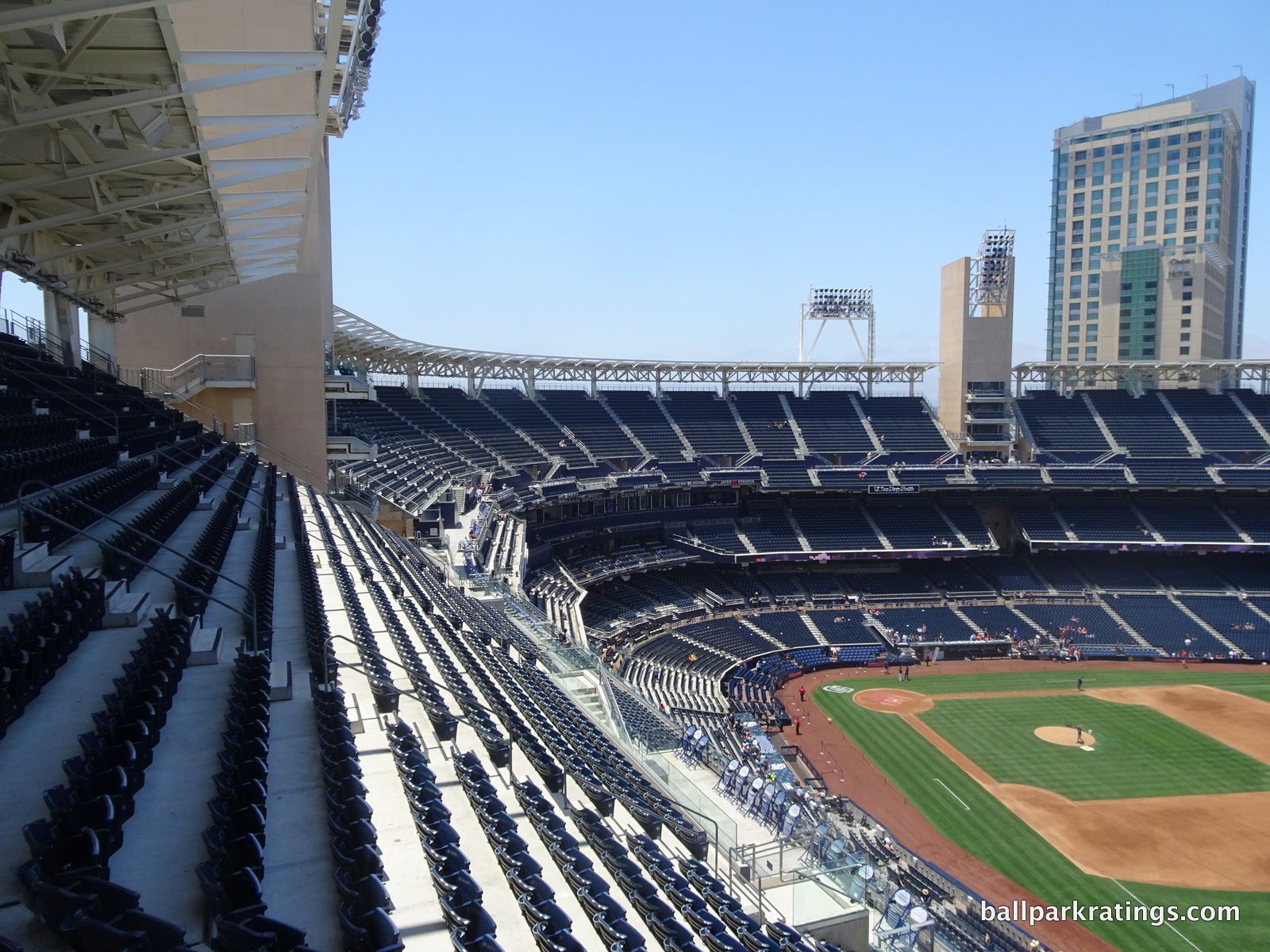
The main seating bowl looks especially gorgeous, as the beige towers greatly aid the park aesthetically. I love how the towers bring the exterior architecture into the seating bowl. I generally like the “neighborhood seating concept” from an aesthetic point of view, and the towers accomplish this perfectly by adding a degree of distinction and innovation not seen in other parks of the era.
The Park in the Park is a fantastic idea. When differentiating between a stadium and a ballpark, I often say that going to a baseball game should almost be like going to a neighborhood park. Petco takes that concept to a concrete level. I also like the picnic terrace with the flowers behind the bullpen, but I just wish it were more prominent, which leads me to my first point.
Why not integrate all of the lush landscaping of palm trees and flowers into the outfield design? The interior of the park could be so much better by bringing the San Diego feel found on the outside and throughout the concourses to the inside beyond the outfield.
The main narrative I take from Petco Park’s interior aesthetics is a lack of continuity between elements, coupled with mediocre execution and a failure to integrate natural elements in the outfield.
Overall, the outfield aesthetics feel too disjointed.

The seating structures in the outfield seem isolated and disconnected to the main structure and the context of the overall design. The center field batters’ eye looks completely out of place, despite efforts to spruce it up (before and after). The Western Metal Supply Co. building doesn’t fit with the overarching aesthetic. Parks like Camden Yards and Minute Maid Park took similar contextual elements and modeled the entire park around it.
Petco Park integrated this one contextual element just for fun then built a ballpark that directly opposes its aesthetic. That tension of the red brick and stucco/nautical design just doesn’t make sense, so the integration of that warehouse seems more like a self-conscious attempt to build a contextually based ballpark, instead of an organic design that fits with the ethos of the structure. I can’t dislike the integration of the warehouse on its own, because it’s still pretty impressive and logistically took a lot of skill, but it solidifies the theme of aesthetic inconsistency and visual clashing of features.
You really have four elements in the outfield that are not only completely independent of each other, but also sometimes contradict the general ethos of the design.

Your eye wanders between the brick warehouse, the batters’ eye, and the two grandstands, as there’s no dominant form or rhythm between the elements. They’re all really doing their own thing visually, which leads to a haphazard look.
The lack of continuity in the architectural lines is really unfortunate because the design seems to have one concrete goal: mimic and bring in the environment of San Diego. Even the Park in the Park could have been better integrated with the ballpark.
In my opinion, the batters’ eye seems to be the root of the problem and the ringleader of the disjointed feel. Why not use ivy or something more natural like other parks, and most importantly, like the rest of your park? If it just blended in with the context and conformed to the architectural vision of the ballpark, perhaps the outfield design would have been acceptable.
Just look at the original rendering. There was water in centerfield, tons of palm trees, tons of greenery, tall shrubs, prominent pink flowers, and less seating. And it reflected its context. Everything fit together; it screamed San Diego; this was much better! The two problems with continuity and aesthetics could have been fixed.
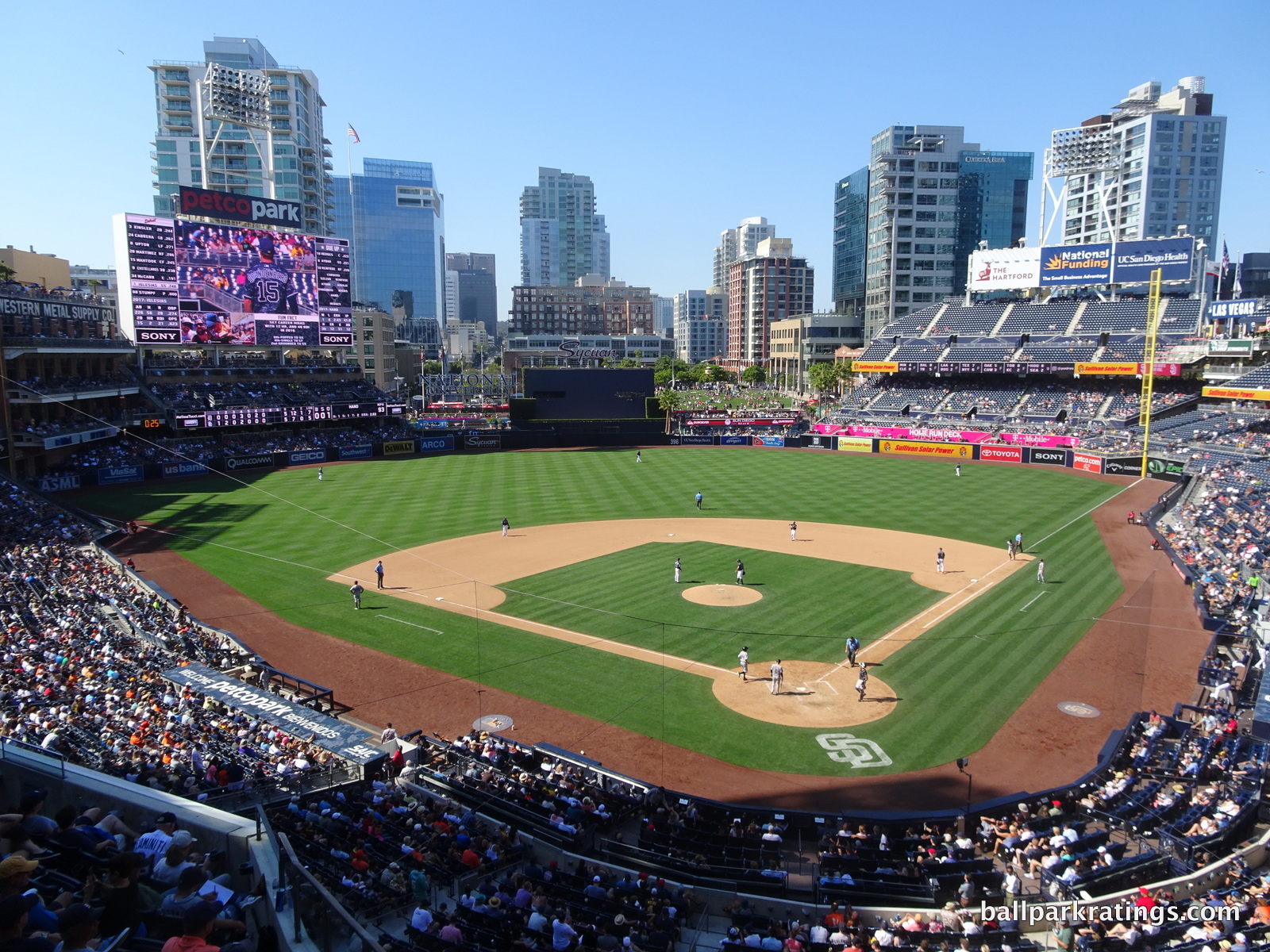
Don’t get me wrong; the design is well short of a disaster because it still maintains an open feel and allows the context to seep in between the miscues. But note how the park isn’t really constructed with the downtown view in mind. Throughout most of baseball, we see calculated design cues to integrate the skyline, water, mountains, etc. into the ballpark.
In San Diego, it looks like everything was just kind of thrown in together without any thought about the views. This is decent contextual integration by default, but it is not as well executed as it could be. In other words, it looks like the surrounding context just happens to be there, not integrated into the ballpark through conscious dexterity (other than the Western Metal Supply Co. building, obviously).
Technically, this isn’t Petco Park’s fault, because many of the surrounding structures were constructed after the ballpark opened.
Great ballparks have the appearance of responding to the contextual forces of their cities. At PNC Park, Progressive Field, Camden Yards, and a host of others, it’s clear that the ballpark was sculpted around the constraints of the preexisting urban environment. The entire ethos is authentic. In other words, the ballpark’s views and open spaces are designed around the landscape.
At times that is true at Petco Park, but at other times, it is exactly the opposite. The surrounding environment was sculpted around the ballpark. This creates a sensibility where it appears views weren’t taken into account.
On a final note, there are far too many contrivances in the ballpark. And what’s significant is that they fail to add aesthetic value. The beach was completely contrived and unnecessary. Perhaps it would have fit in better with the original rendering of water and palm trees, but it looked out of place and phony. It looked more like an element that’s falsely trying to get back what that ugly batters’ eye took away, which shows a lack of confidence in the design. Fortunately, the beach concept was altered in the mid-2010s.
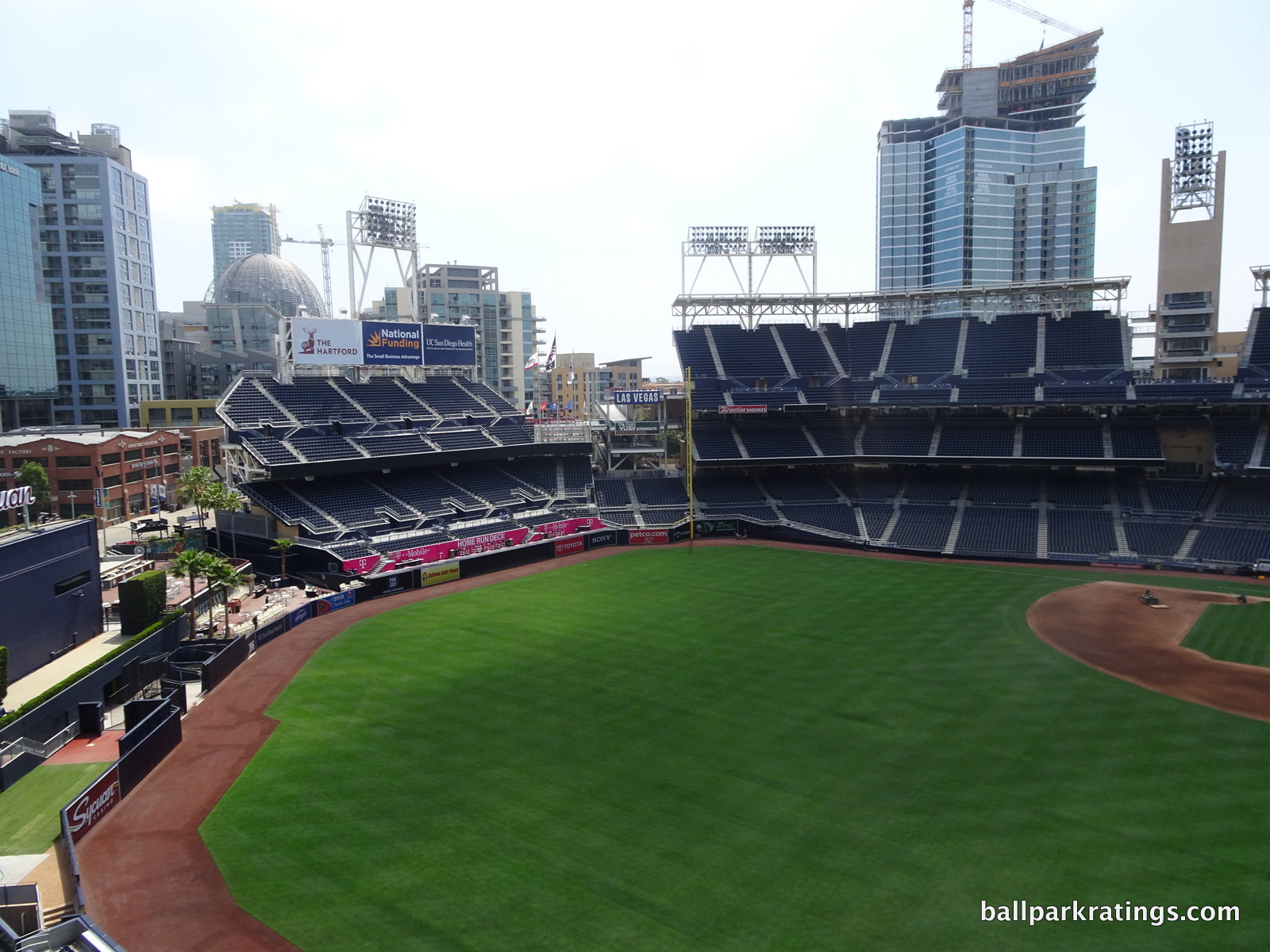
Not borne from necessity, the right field notch (“home run porch”) is the single most contrived element in baseball. At least you can understand why a team would think to put a hill in Houston, because of the deep center field. If there was ever a place for a nostalgic hill, that’s it. But there’s zero reason or rationale for Petco’s porch on any possible level. It’s just there, completely out of place. But I understand it from a functional point of view: how cool is it to be literally in the outfield with fair territory on either side? So I appreciate the reasoning behind it and its novelty.
In the end, perhaps the original rendering didn’t work out logistically, or it was a rough sketch they never really considered. But from an aesthetic point of view, Petco Park could have been as great as parks in Pittsburgh and San Francisco.
As it stands now, the interior aesthetics seem like a missed opportunity more than anything else, but not one that’s enough to prevent Petco from being the best park in baseball overall. However, being 9th out of 27 in interior aesthetics is nothing to thumb your nose at.
Score: 11/15
Panoramic View/Backdrop:
Reminder for those who don’t read the criteria: this is used as a supplementary factor to emphasize the primary component of interior aesthetics (ideally): contextual integration. Even though Petco Park doesn’t always highlight views as best as we would want, development since 2004 has greatly aided Petco Park in this category.
Today, I think we see the Petco Park redevelopment project at full fruition. A condo, hotel, or office building occupies nearly every space beyond the outfield, except the Park in the Park.
It’s an almost flawless concept: an urban village with both a ballpark and a literal park in the middle.

Score: 4.5/5
Concourses
Arguably the highlight of Petco Park from an aesthetic perspective, the concourses are sculpted unlike any in baseball.
Landscaped with all kinds of local greenery and flowers, they are completely exposed to the sky and the surrounding area.
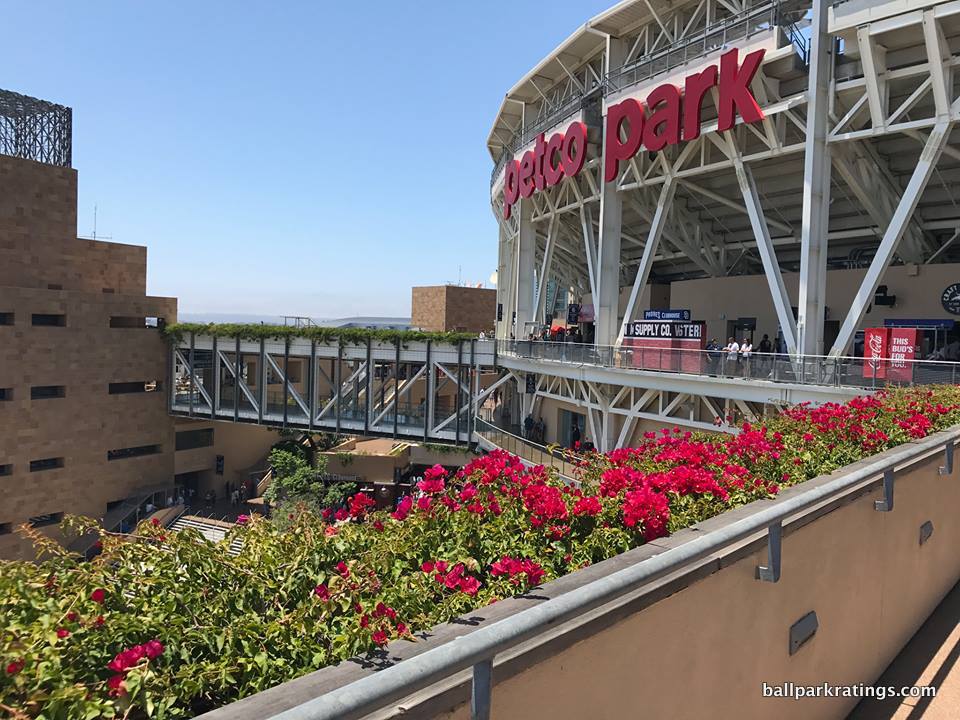
As a structure, Petco Park is split into a number of outer buildings removed from the main seating bowl, creating the most unique concourse design in the majors. The concourse is situated like a street in a neighborhood: the seating bowl is on one side, while ‘garden towers’ adorn the other side. There’s no traditional ceiling. Bridges in the upper decks connect to the garden buildings, which house restaurants and other concessions.
Everywhere you look you see hanging ivy and gardens cascading down the structures. The airy concourse allows natural light and oceanic breezes to pass through. Bougainvillea and jasmine plants overfill banks that spill from the bridges. The canyon-like space reveals skyline and bay views on all levels. Garden terraces face the ocean surrounding the city. The look is brilliantly sculpted and well suited for the environment.
Functional issues aside (which we will get to), this is the most aesthetically inclined concourse in all of baseball.
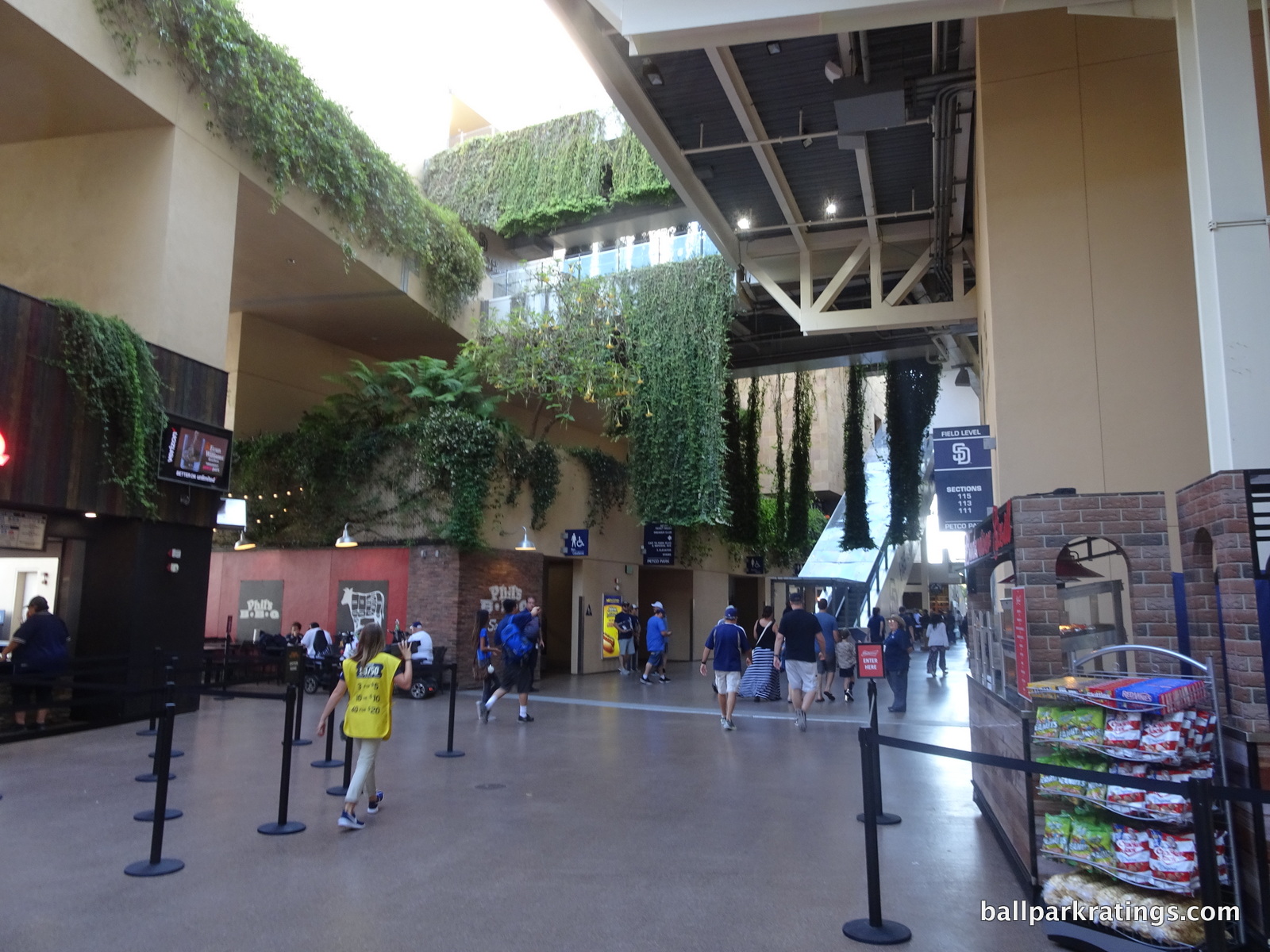
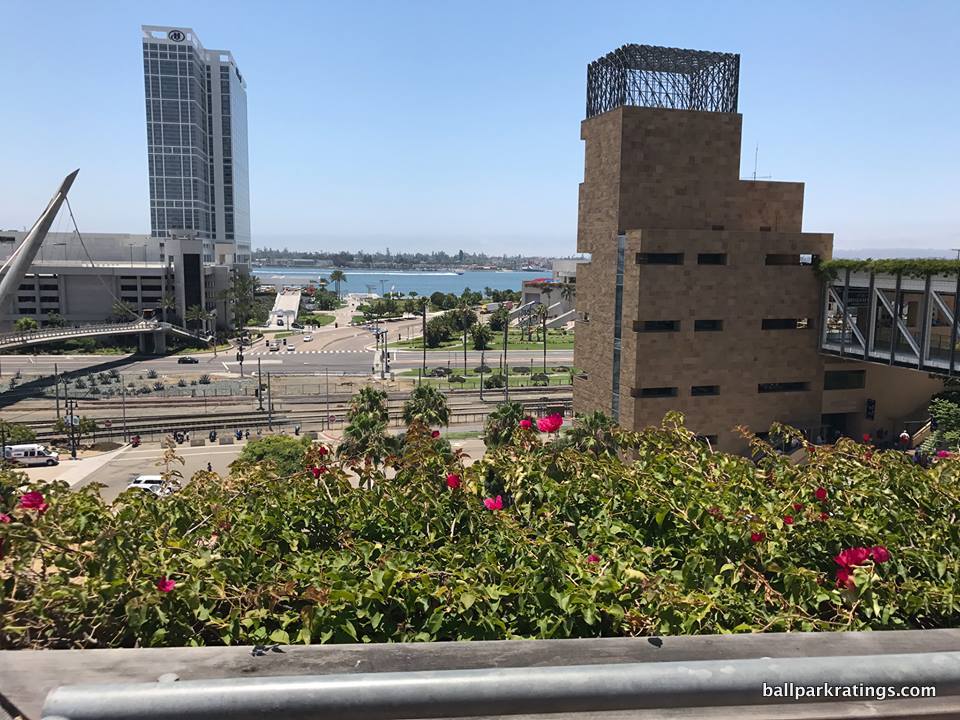
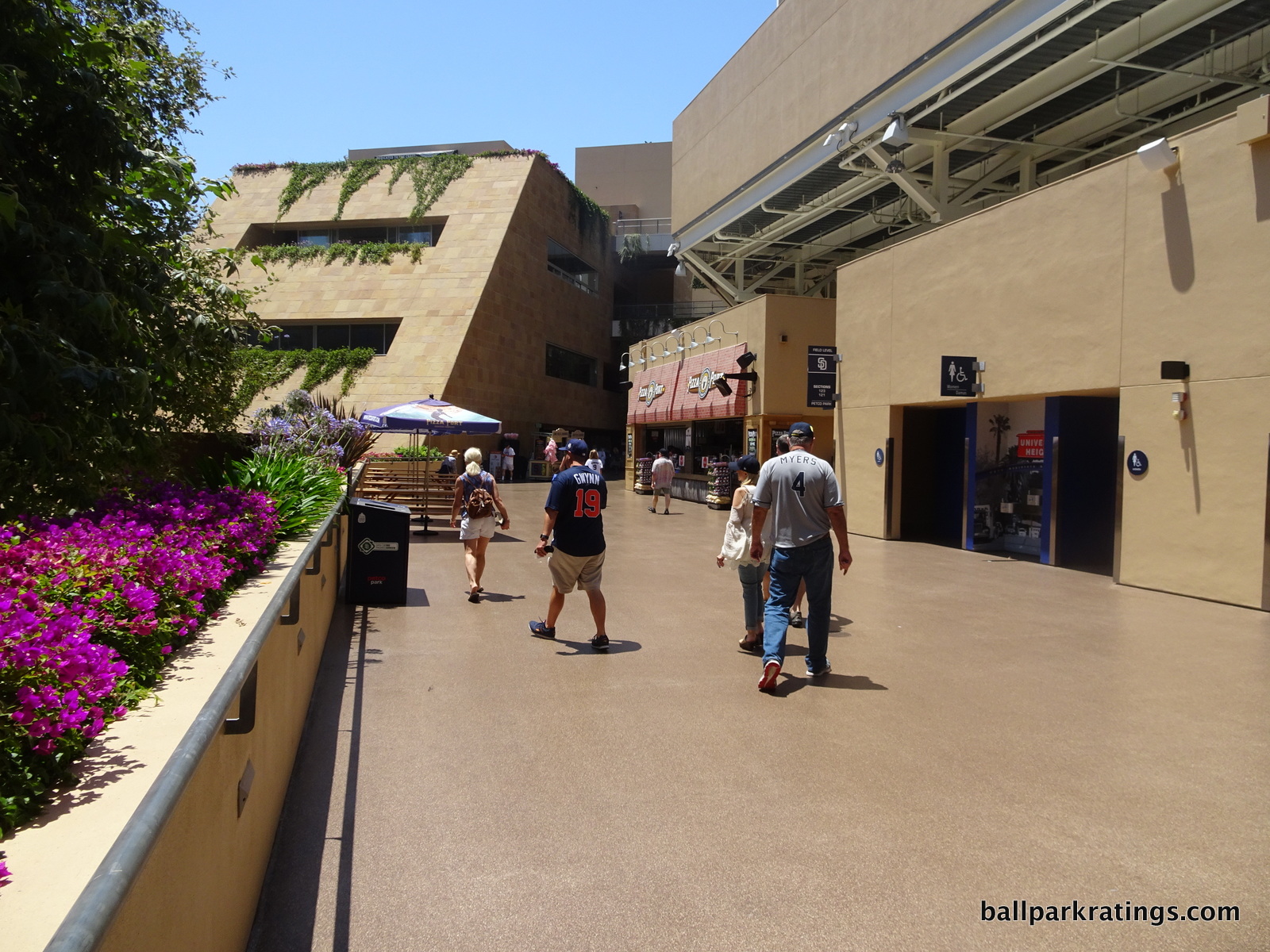
Score: 3/3
Total: 27/33
Functionality & Essentials
Sightlines
I’ve heard a wide range of perspectives on the sightlines at Petco Park, but the general consensus is high acclaim for the significantly cantilevered upper levels, despite the early complaints about some obstructions.
First of all, the seating geometry is executed to perfection. All seats are oriented aggressively toward the infield. Stiff necks are completely non-existent from all areas. Petco Park appears to be one of the few parks that actually got the seating geometry just right.
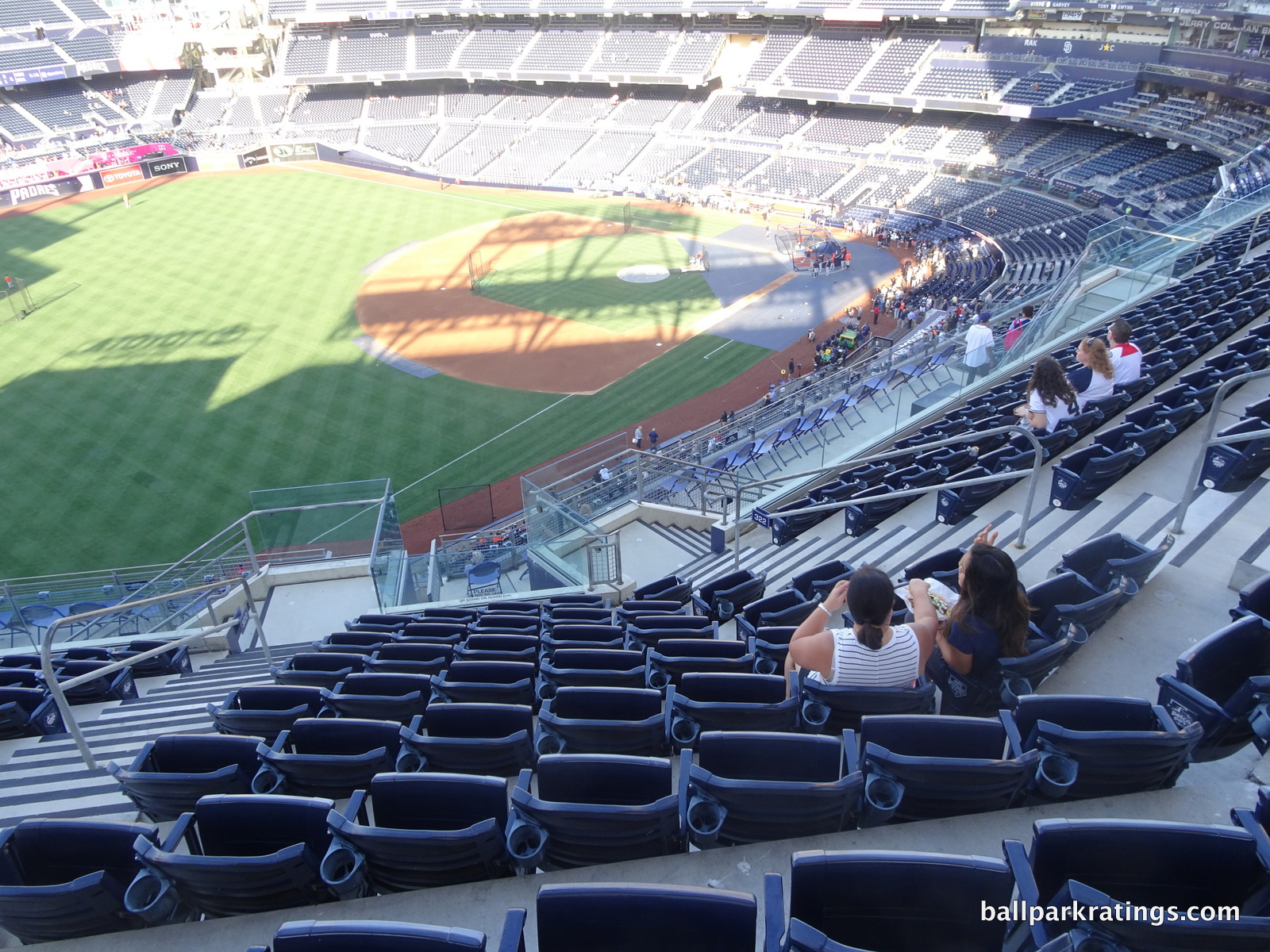
Petco Park also places fans closer to the action than any park in the majors, not counting the classics in Chicago and Boston. The mezzanine completely extends over the back part of the infield boxes, placing the seats a notably close 34 feet from the field, reportedly closer than any ballpark in baseball.
The upper deck is as cantilevered over the mezzanine as you’ll see in modern ballpark construction. Of course, they had to raise the height of the mezzanine and the upper deck to avoid overhang issues for seats below, but the height issue is mitigated by the fact that Petco has no separate suite levels. So they pretty much get it perfect in my opinion. Foul territory is really kept to a minimum as well: seats behind home plate are only 45 feet from home plate.
While PNC Park may be lower from the upper decks, Petco Park has the closest upper decks in baseball. On the surface, Petco appears to have the best sightlines in baseball.
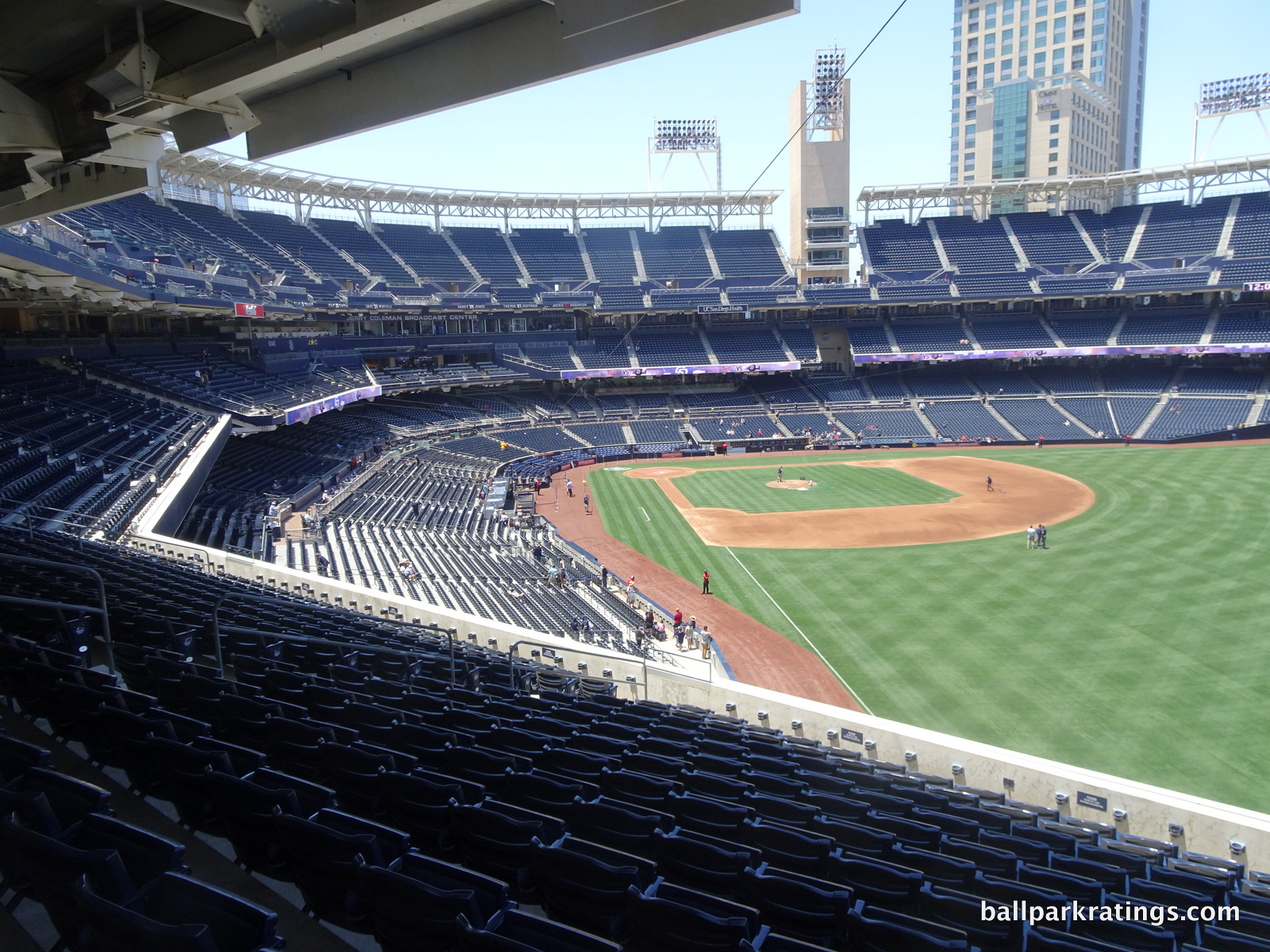
But there are problems with isolated sections stemming from structures meant to add aesthetic value to the park. The towers that split up the upper deck block the views from a few seats in the highest part of the upper deck. The same is true for the view from the upper deck in left field, which is blocked by the Western Metal Supply Co. building. From parts of the upper deck in left field, 1/3rd of the outfield is cut off.
I don’t put as much stock in these isolated obstructions as some other ballpark reviewers. My sightline critiques don’t speak as much to individual and isolated obstructions fans may experience. That doesn’t represent the totality of the park, so I focus more on decking structure, cantilevers, field proximity, and seating geometry.
I’d rather be closer to the field even if I had to sacrifice some views of the outfield from a small number of sections. So I find absurd the notion that the minor outfield obstructions created by the Western Metal Supply Co. building ruin the ballpark’s sightlines.
Even considering these outfield obstructions, Petco Park clearly has the ideal formula for sightlines among post-1991 ballparks, in my opinion.
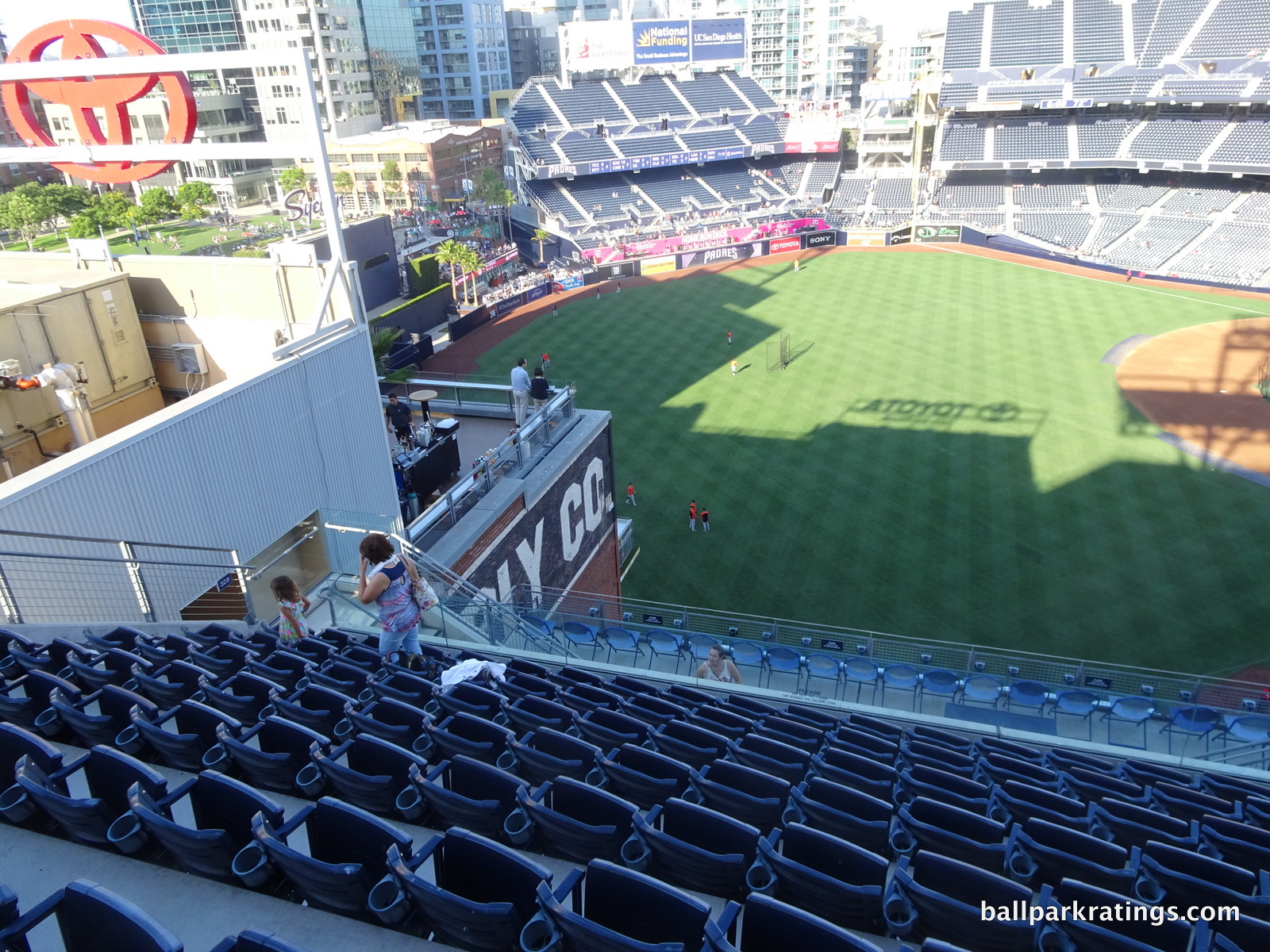
Score: 9.5/10
Seat Comfort
Petco Park’s seats are in good condition and meet the current seat width standards, but not historical seat width standards, similar to most modern ballparks. People commonly lament the increasing waist size of Americans, but parks like the Astrodome, Candlestick Park, and RFK Stadium had seats ranging from 20-21 inches throughout the ballpark. That historical ballpark factoid has been completely lost.
Petco Park has a relatively high proportion of padded seats, but they aren’t too comfortable: Toyota Terrace level seats have thinly padded bottoms, while Omni Premier club seats feature thinly padded bottoms and thinly padded backs.
For new readers, 3.5 is the standard score. Only a handful of newer parks, either with a higher proportion of padded seats or wider seats, score higher.
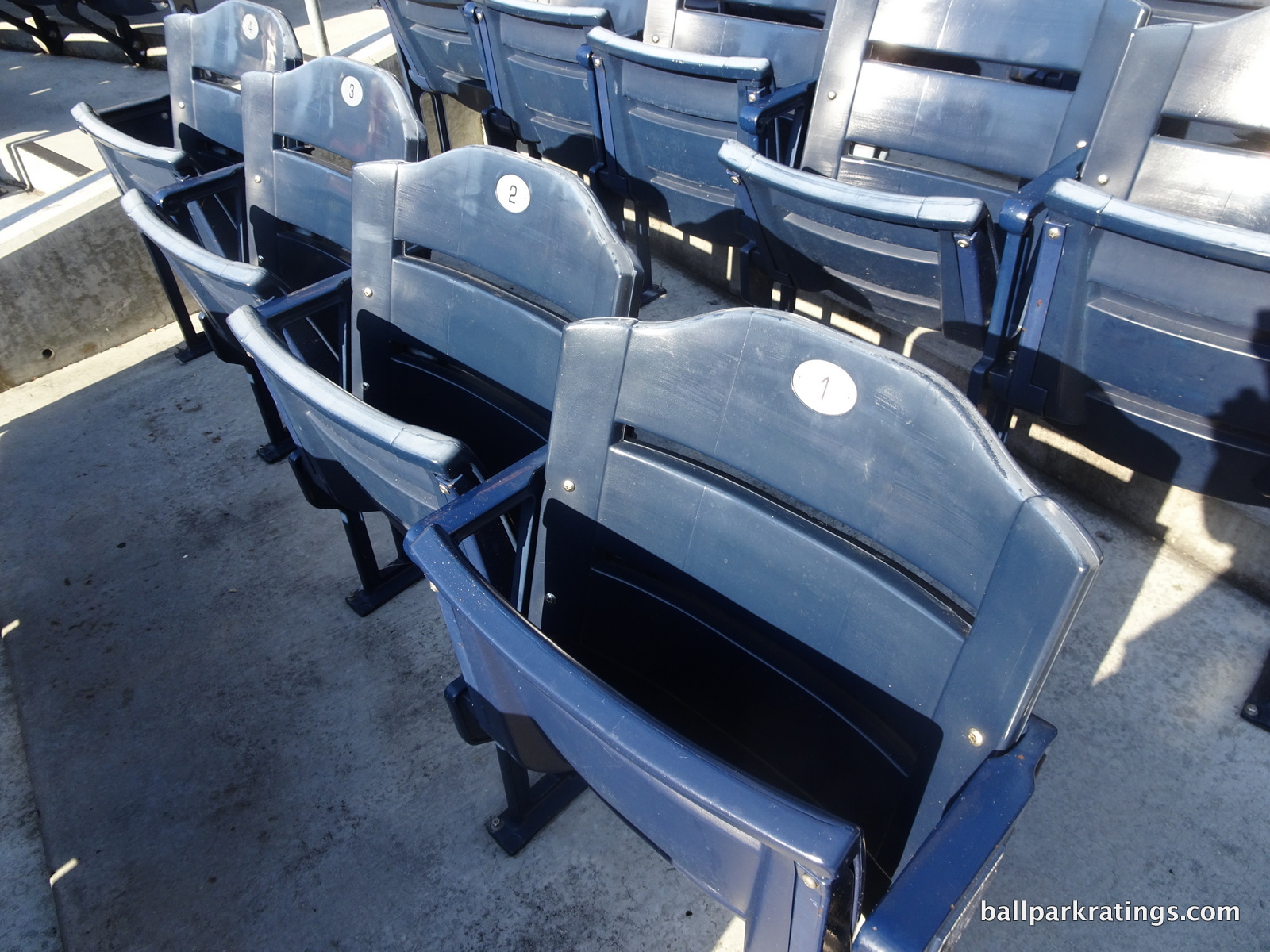
Score: 3.5/5
Concourses
While it may be the best looking concourse, it doesn’t work as well from a functional standpoint. Petco Park may have the most confusing and convoluted concourse system in American sports. This is undoubtedly the ballpark’s primary flaw, and it’s not a minor one. On the plus side, it isn’t a substantial obstacle given the large amount of space, unlike at AT&T Park (which has a concourse so narrow it’s almost disqualifying).
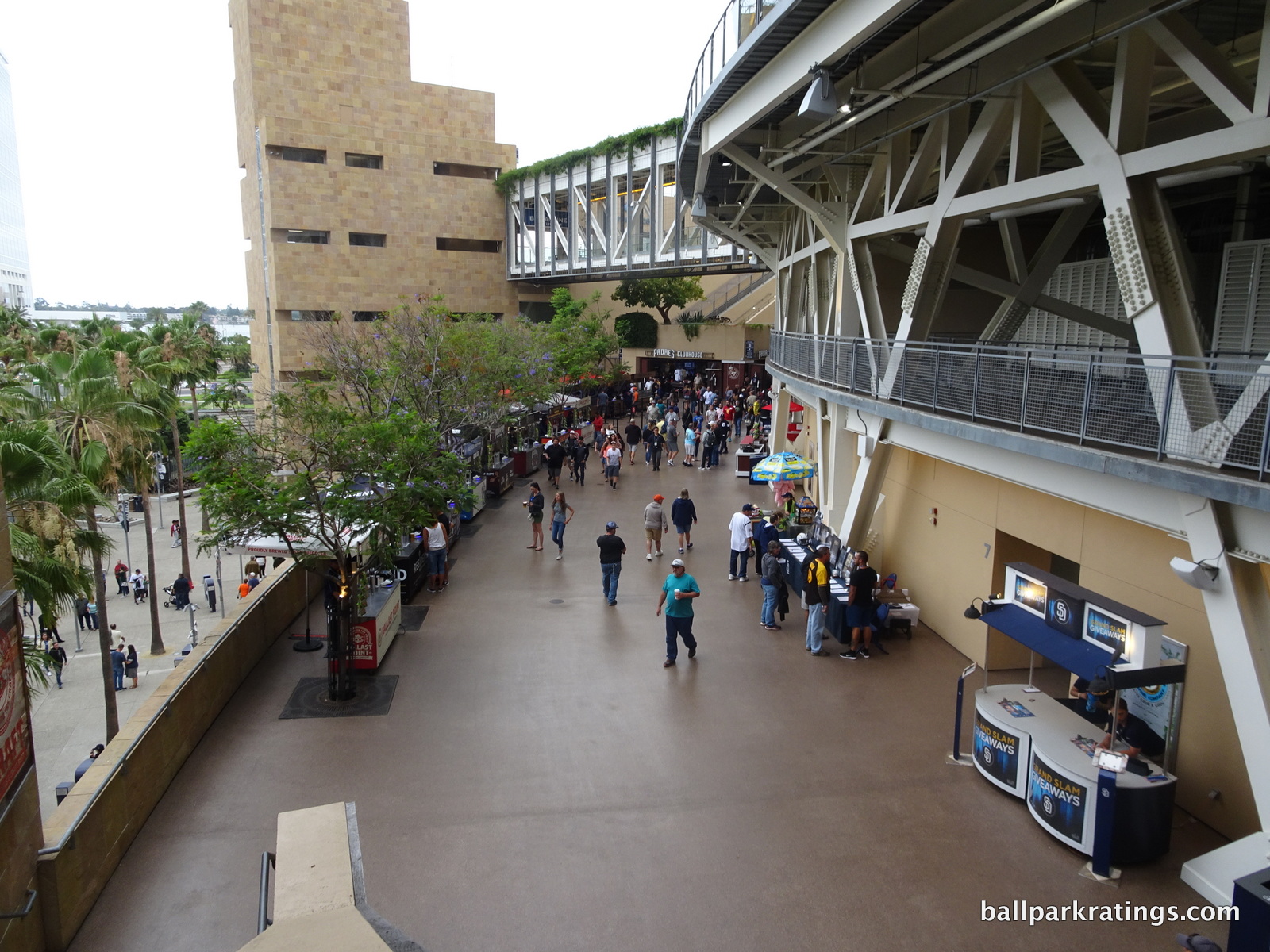
State-of-the-art main concourses go all the way around the field on one level, without horizontal encumbrances or vertical changes in elevation. They are open to the playing field at every point, so you never lose sight of the game. They also feature seamless entry at street level. Think Citizens Bank Park in Philadelphia. It has a simple, wide, and open system that is easy to navigate.
Forget all of that at Petco Park. Along the main concourse, especially when you transition from the infield to the outfield, there are so many vertical changes in elevation and horizontal discontinuities you will literally get lost.
It doesn’t really even qualify as a 360-degree system.
The main concourse is three floors above street level. The left field lower box seating occupies the second floor, the left field upper box has its own concourse area, and the outfield concourse (including the Park in the Park and the outfield right field concourse) is at street level on the first floor.
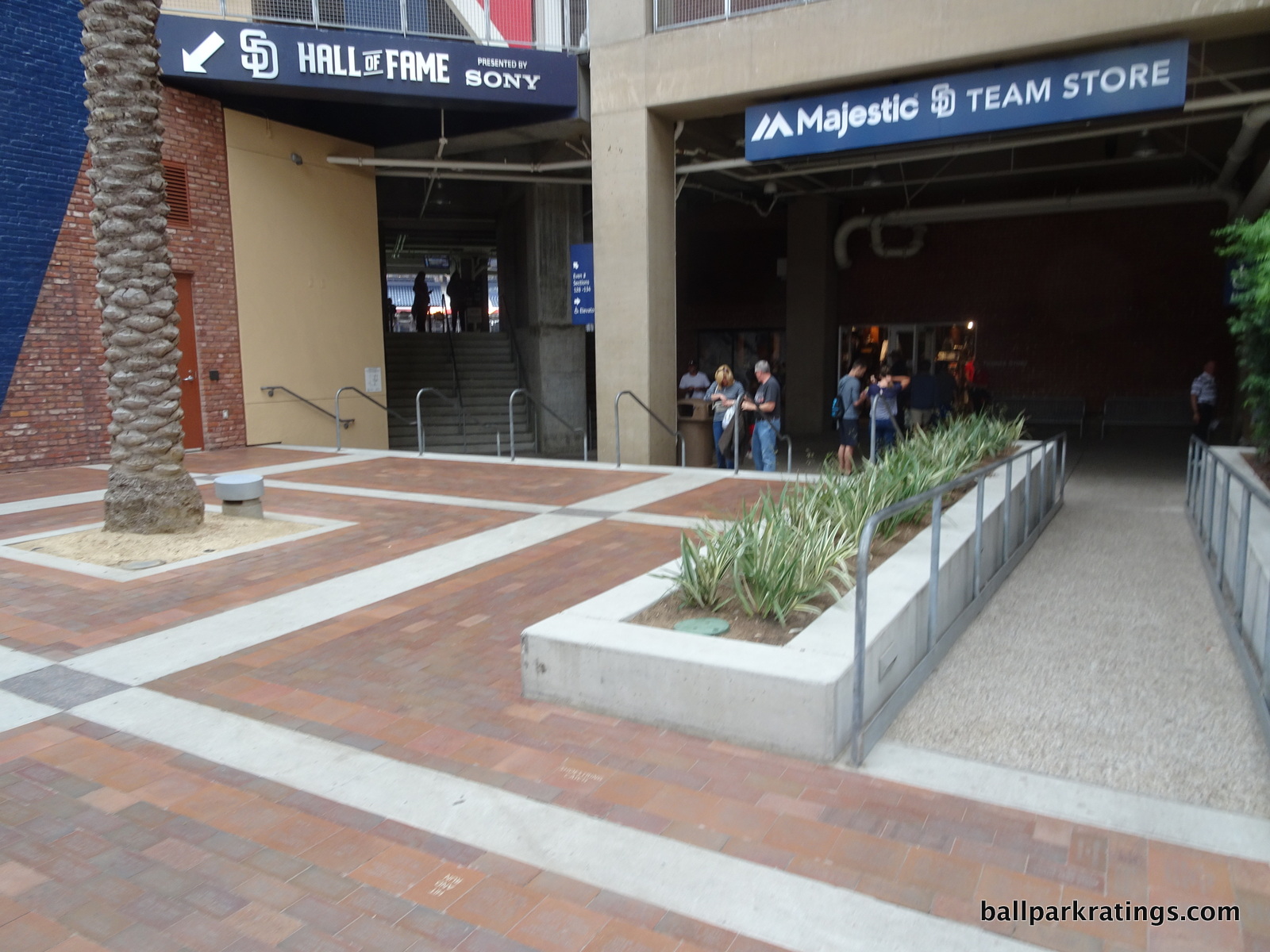
When approaching the main entrance plaza, you will hike up to the main concourse as if you’re venturing into an upper deck. On the main concourse, things get very complicated when you reach both the left field and right field corner.
In left field, you will approach a small staircase heading downwards, with a narrow corridor to the right. You’ll naturally want to turn right, assuming this will get you to the outfield concourse, but it actually leads you to the second floor concourse for the left field box seating. Instead, after you head down the first set of stairs, keep moving forward. You will then hit a second level of stairs and escalators that lead to the courtyard plaza and the Padres’ Museum and Hall of Fame. Turn right out of that area and you will finally reach the outfield concourse and the Park in the Park.
The right field corner isn’t as complicated, but it is more annoying. The concourse down the right field line is inexplicably divided by a series of concession stands. You’ll be inclined to take a left toward the seating when meeting this fork in the road, but you want to go to the right side to reach the outfield concourse.
At this point, you’ll be met with my ballpark pet peeve: ramps! And not ramps to get to the upper deck, but just the outfield! Yes, Petco Park requires a cumbersome set of ramps, not a more convenient set of stairs or escalators, to reach the outfield concourse on the right side. The ramps instinctively look like a ballpark exit, because you have to walk two floors down to get to street level where the right field concourse begins, leading to the Park in the Park. Padres’ fans have called this the “Never Ending Wheel Chair Ramp” that should be avoided “at all costs.”

No other park is anywhere near this complicated (this is interesting), as the outfield concourse is usually part of the main concourse. This is completely unacceptable. Great ballparks naturally encourage circulation to get fans walking around as many attractions and points of sale as possible. This design isn’t conducive to circulation.
As we’ll get to in “Amenities,” Petco Park has so many cool features, but fans may not have the patience to find them.
To add insult to injury, Petco Park’s concourses are not open to the field, for the most part. Open concourses are a hallmark of the greatest retro parks, and that’s mostly lacking here. It’s not a true closed system like at Camden Yards or Busch Stadium, but the view is often blocked, except for a few openings between structures.
On the main concourse, we do have open views down the left field line before meeting the Western Metal Supply Co. building. But going down the right field side starting around home plate, views are continually obstructed by suites, the Premier Club, a food court, then a bathroom and those series of pesky ramps. It looks like a system that was designed to sport open views of the field, but so many obstructing features were added after the fact.
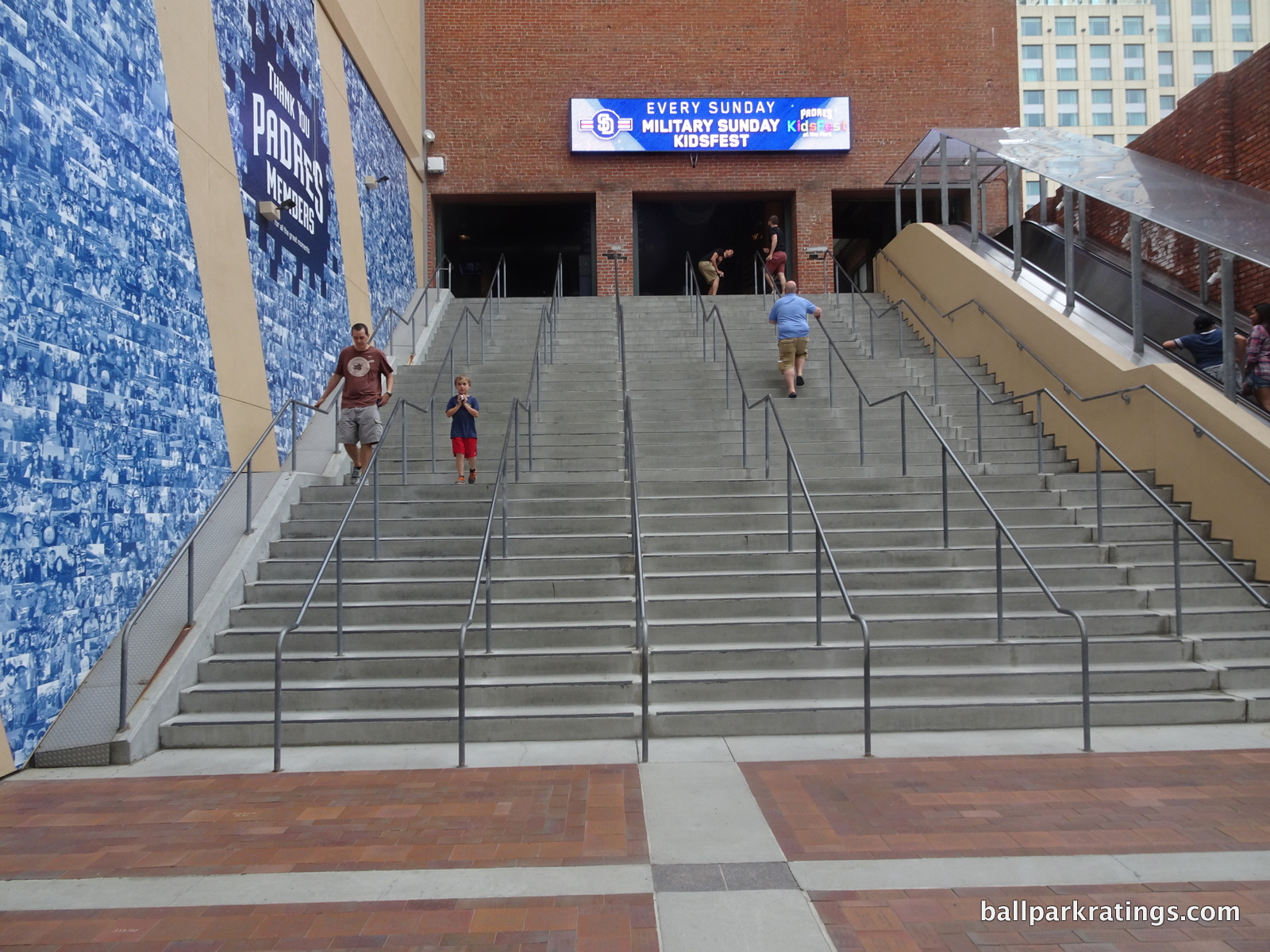
Petco Park also lacks the open standing room areas seen in some other parks. The outfield concourse is blocked by the grandstand in right field and by the Western Metal Supply Co. building in left field. Glimpses of the game can be seen from center field and the new Craft Pier.
The concourses are also closed in the upper deck and terrace level. The upper deck sports a fantastic view of the surrounding area, including the San Diego Bay. Yes, access to the garden buildings on both the terrace level and the upper level is nice. And the view from these restaurants is to die for. But how about a view of the game too?
Petco Park doesn’t have the worst concourses in baseball from a functional point of view because they are sufficient in space. Both the main concourse and the outfield areas are well above the industry standards in width. The massiveness of the Park in the Park will overwhelm you no matter how high your expectations. You keep going and going thinking this can’t be part of the ballpark’s physical plant, but it is.
But overall, Petco Park is characterized by discontinuity and a lack of field views in this category. You shouldn’t need a map to navigate a baseball stadium. A lot of this is a function of Petco Park’s “neighborhood seating” concept, which has more pluses than minuses, but leads to a lot of this discontinuity.
This significant blemish is the primary aspect that prevents Petco Park from being the perfect ballpark.
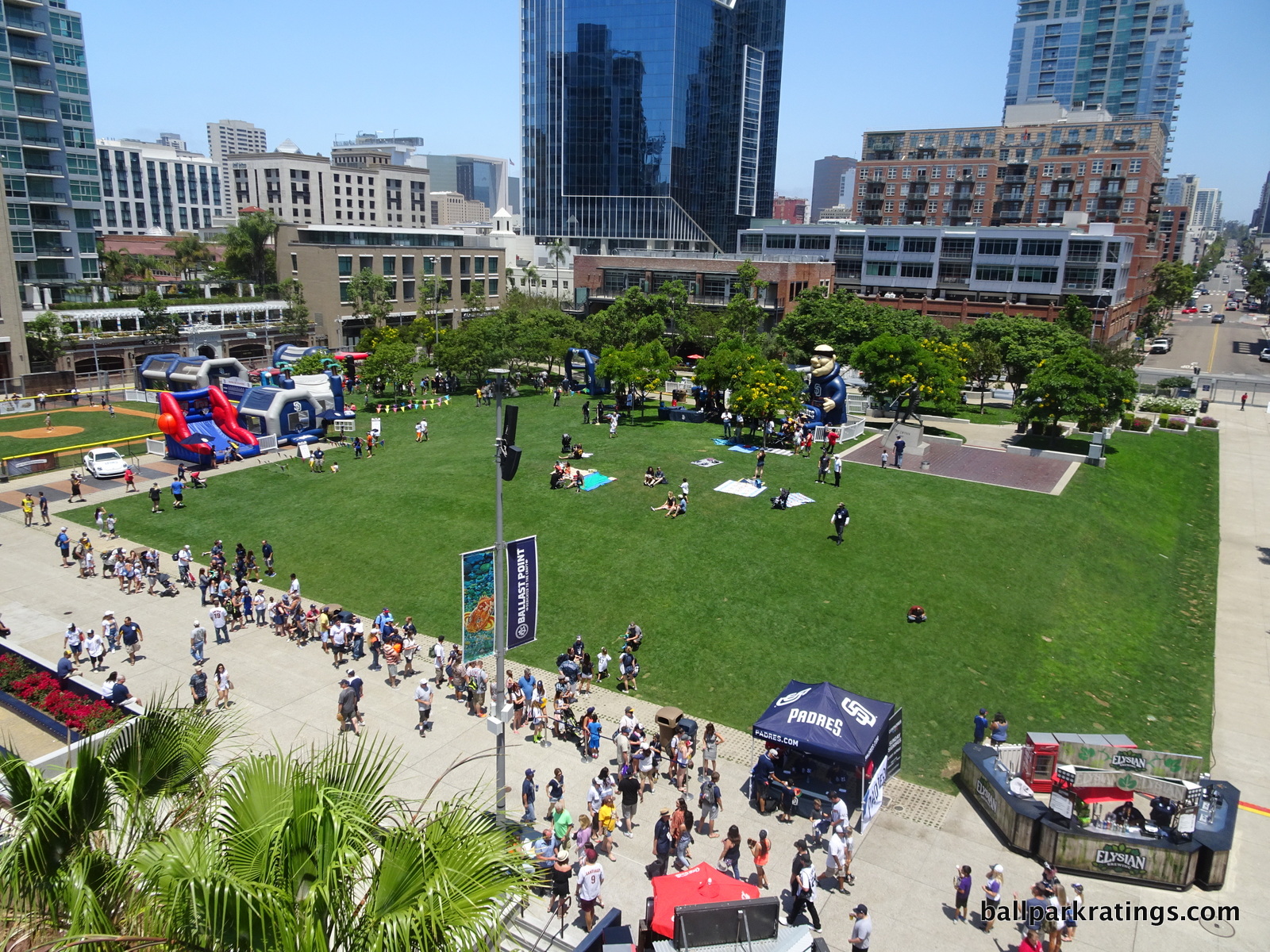
Score: 3.5/7
Scoreboard System
Originally dubbed “FriarVision,” Petco Park’s old videoboard left a lot to be desired. Petco was one of the last ballparks to have a matrix board. In 2015, the Padres responded by adding a massive new videoboard. Measuring 61.2 by 123.6 feet, it is almost five times larger than the old one.
As of 2017, it is the 5th largest in baseball, behind those in Cleveland, Seattle, Kansas City, and Atlanta.
Some fans complained that the videoboard can’t be viewed from the left field corner, but this is pretty standard. However, the Padres added an ancillary board in right field in 2018 to address these concerns.

Score: 3/3
Total: 19.5/25
Amenities & Features
Quality and Selection of Concessions
With a selection of food and beverages that are high quality, varied, and local, Petco Park represents the pinnacle of stadium food in major league ballparks.
A number of ballparks cover all of the bases in terms of variety, serving every conceivable cuisine from hamburgers and pizza to mahi-mahi and poke. Petco Park does just that, but with nearly every single concession stand run by local eateries. Even in parks like Safeco Field and AT&T Park, stadium food corporations run some of the varied cuisine. Not in San Diego. It’s all varied, and almost all local. I could count the number of generically branded concession stands on one hand. Everything mentioned below is run by a renowned local eatery unless I indicate otherwise.
Not only that, but Petco Park’s high quality, varied, and local cuisine has both breadth and depth. Many ballparks have a great breadth of food offerings, checking all of the boxes with BBQ, Asian, seafood, Italian, subs, and Mexican. But sometimes you get the sense that those ballparks just want to say they offer all of these food options, but only provide a few concession items in each category. Petco Park has great depth as well, providing many different options within each regional cuisine category.
Finally, I’ll add that the high-quality, varied, and local cuisine isn’t just run by ordinary local eateries, but by some of the best and most highly acclaimed restaurants in San Diego. Often, San Diego’s best food is in Petco Park! And don’t forget, this is before we look into Petco Park’s numerous sit down restaurants and bars!! We’re just talking concession stands here, although there is some overlap. Let’s dig in.
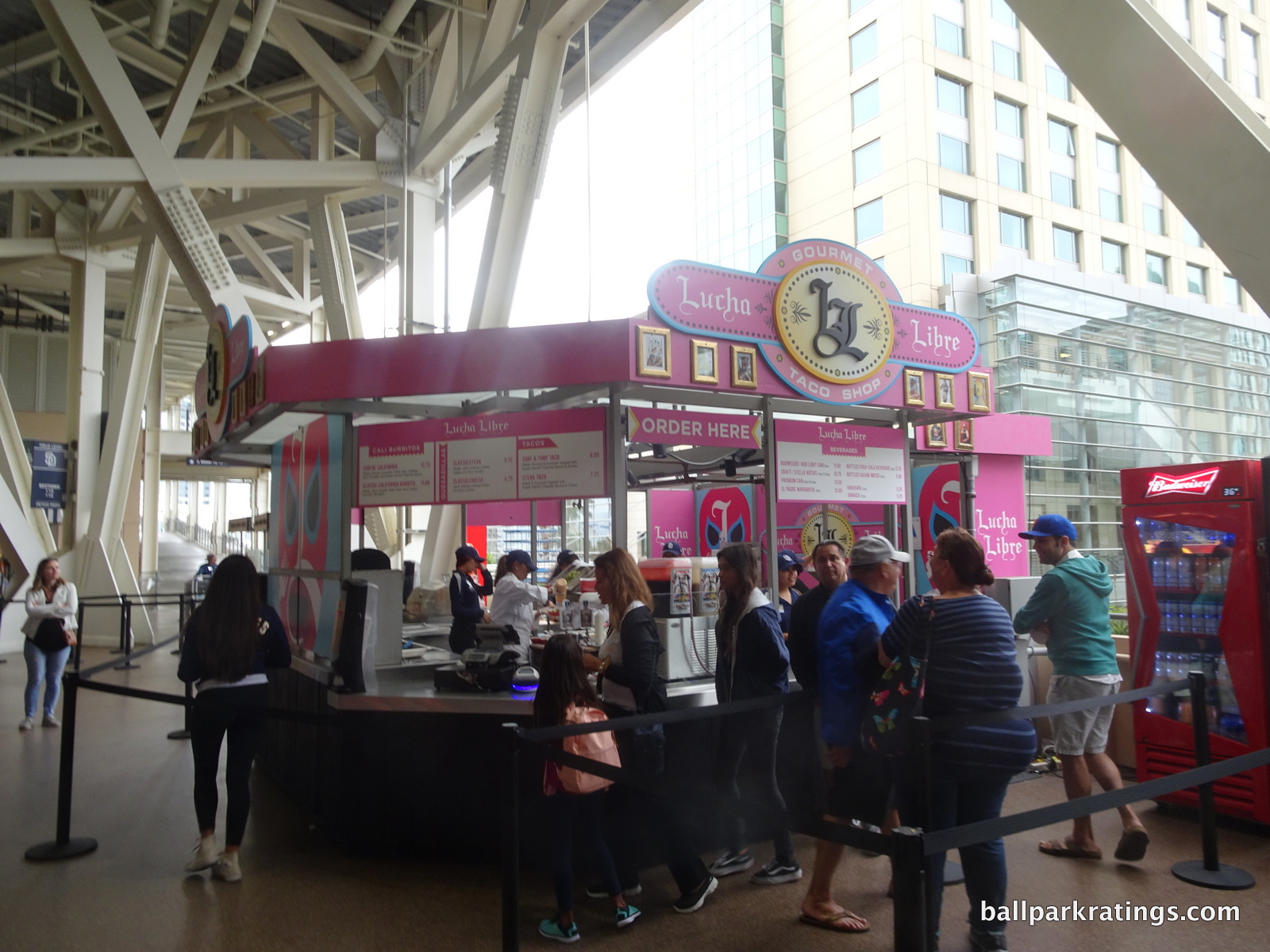
Geographically, San Diego is perfectly positioned to offer a wide breadth of cuisines if you think about it. Let’s start with the seafood. Brigantine Seafood & Oyster Bar is Petco Park’s signature seafood joint. Located on the Toyota Terrace level (accessible to all), the concession stand offers fish and chips, calamari, coconut shrimp, shrimp and crab Louis, Coctel del Mar, Oysters Rockefeller (!), New England clam chowder, and some of the best fried fish tacos you’ll ever taste.
The Brig’s Famous Fish Taco comes with cabbage, salsa fresca, cheddar cheese, and ranch dressing, all on a corn tortilla. Petco Park’s Bumblebee Seafood Cart serves some unique fare like tuna melts, salmon bacon melts, tuna nicoise salad, and roasted red pepper hummus.
Rimel’s serves some of their unique treats at both the fast casual eatery on top of the Western Metal Supply Co. building and at a kiosk on the main concourse. Rimel’s surfer burrito, chicken bowl, rotisserie chicken, and grilled mahi-mahi bowl are available. They also serve their specialty Baja style fish taco, with grilled mahi-mahi, salsa fresca, fresh cabbage, a spicy spread, and green chili garlic sauce. You might start to notice a trend of fish tacos!
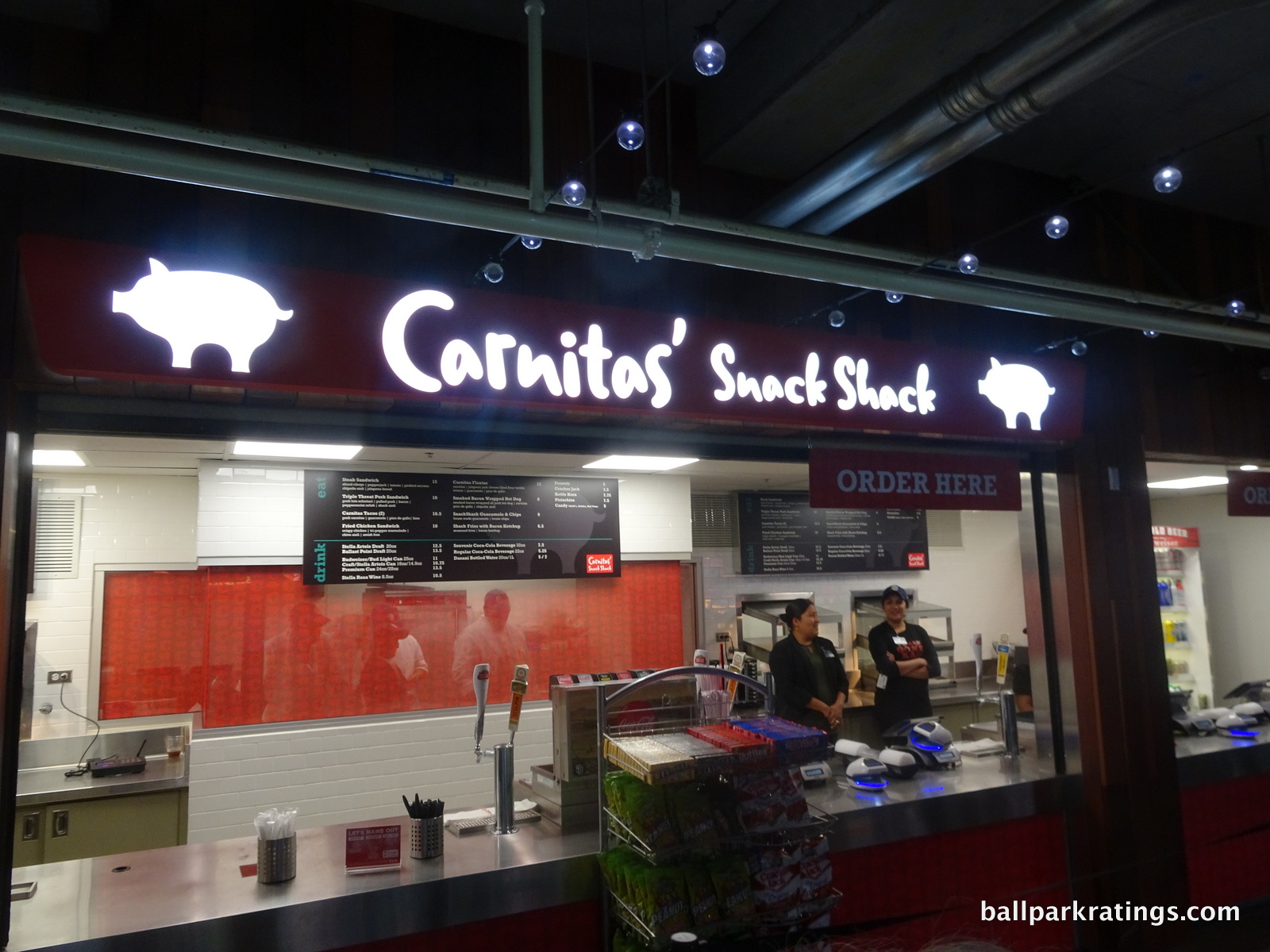
Petco Park excels in its quality and selection of local Mexican food, to no surprise. Located in two areas on the main concourse, Lucha Libre serves their Surfin’ California Burrito, Surf & Turf Taco, carne asada quesadilla, queso taco, steak taco, and classic cheese quesadilla. Miguel’s Cocina cooks up very similar grub, highlighted by their Surf N’ Turf Burrito, classic fish taco, carne asada taco, and chips & queso. If you have a weekend at Petco Park, this might be a fun area to compare.
San Diego’s standout concession lineup also includes an unusual number of local sandwich restaurants.
While relegated to a poor location behind the lower left field box, Carnitas’ Snack Shack might be the most highly acclaimed eatery mentioned so far. The San Diego fast casual spot is revered for its pork sandwiches, craft beers, and local veggies.
We have extensive options at Snack Shack’s Petco Park location, including a steak sandwich, “Triple Threat Pork Sandwich” (pork loin schnitzel, pulled pork, bacon), carnitas tacos, carnitas flautas, guacamole, and their famous shack fries with bacon ketchup. These are the best carnitas in San Diego.
With a sit-down location on the Toyota Terrace level and a concession stand on the main concourse, Board and Brew has some of the best sandwiches San Diego has to offer. Specialties include the “Turkado” and the turkey club. Other options on the menu are the baja chicken/beef sandwich, chicken club, and a classic grilled cheese.
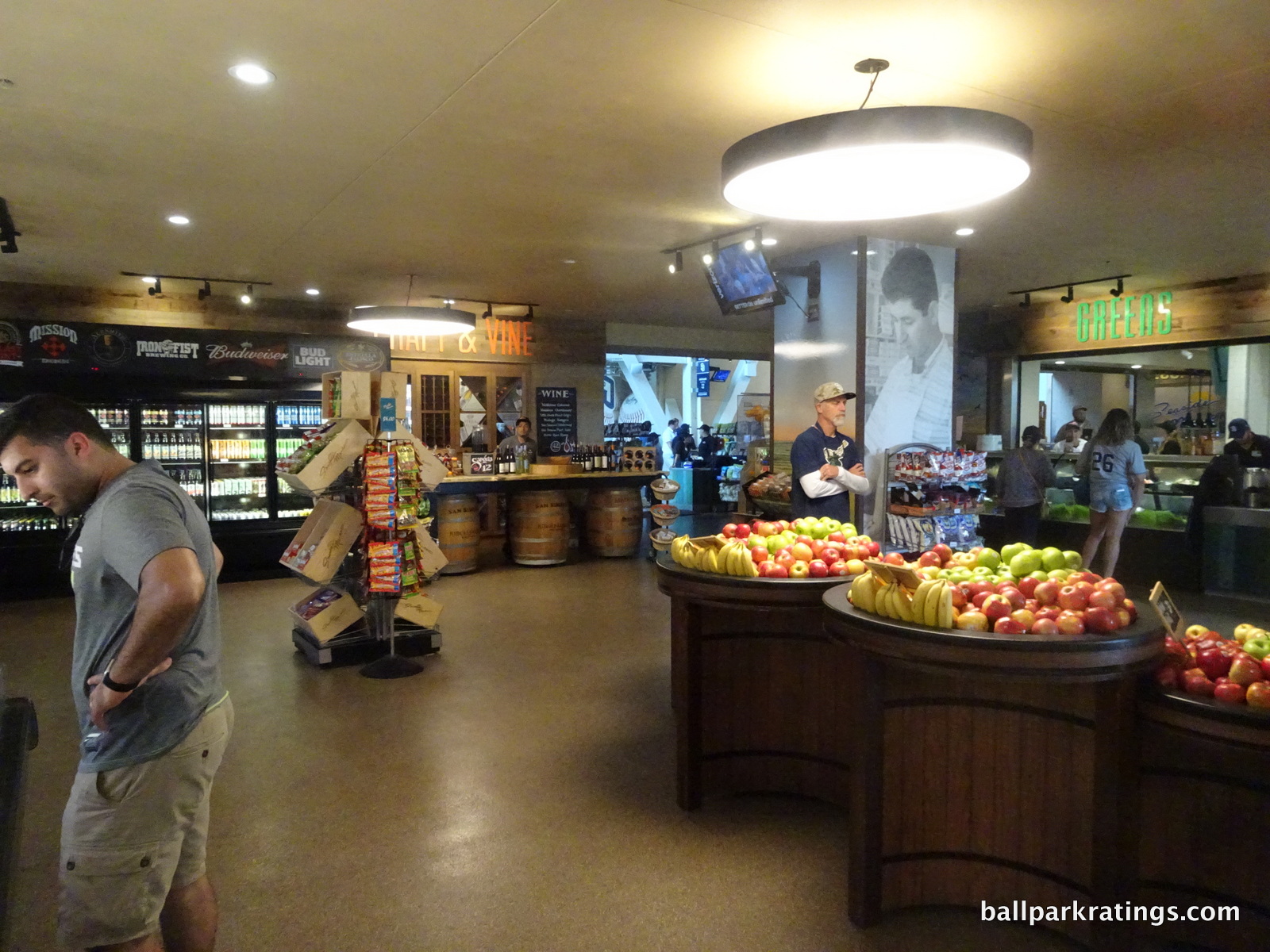
Gaglione Brothers brings their famous cheesesteaks and fries to the ballpark. Cardiff Seaside Market has an impressive presence at Petco Park. Down the left field line on the main concourse, there is a kiosk serving their famous burgundy pepper tri-tip sandwich. It’s marinated on a brioche roll and topped with BBQ sauce. Be sure to try the burgundy pepper tri-tip nachos too!
Cardiff Seaside Market has a prominent role in serving Petco Park’s healthy grab and go food. Like an actual supermarket, we have everything here. A variety of fruits, vegetables, salads, nuts, chips, boxed sandwiches, sushi (sometimes), beers, and wines are available. If you’re looking for more healthy fare, the Paradise Bowl kiosk serves fresh fruit, pitaya, and acai bowls. You’re not going to find that in Cincinnati!
Joining in the ballpark craft burger craze, a true San Diego institution is featured at Petco Park: Hodad’s. With several stands around the ballpark, cheeseburgers, bacon cheeseburgers, veggie burgers, chicken strips, onion rings, fries, and milkshakes are provided.
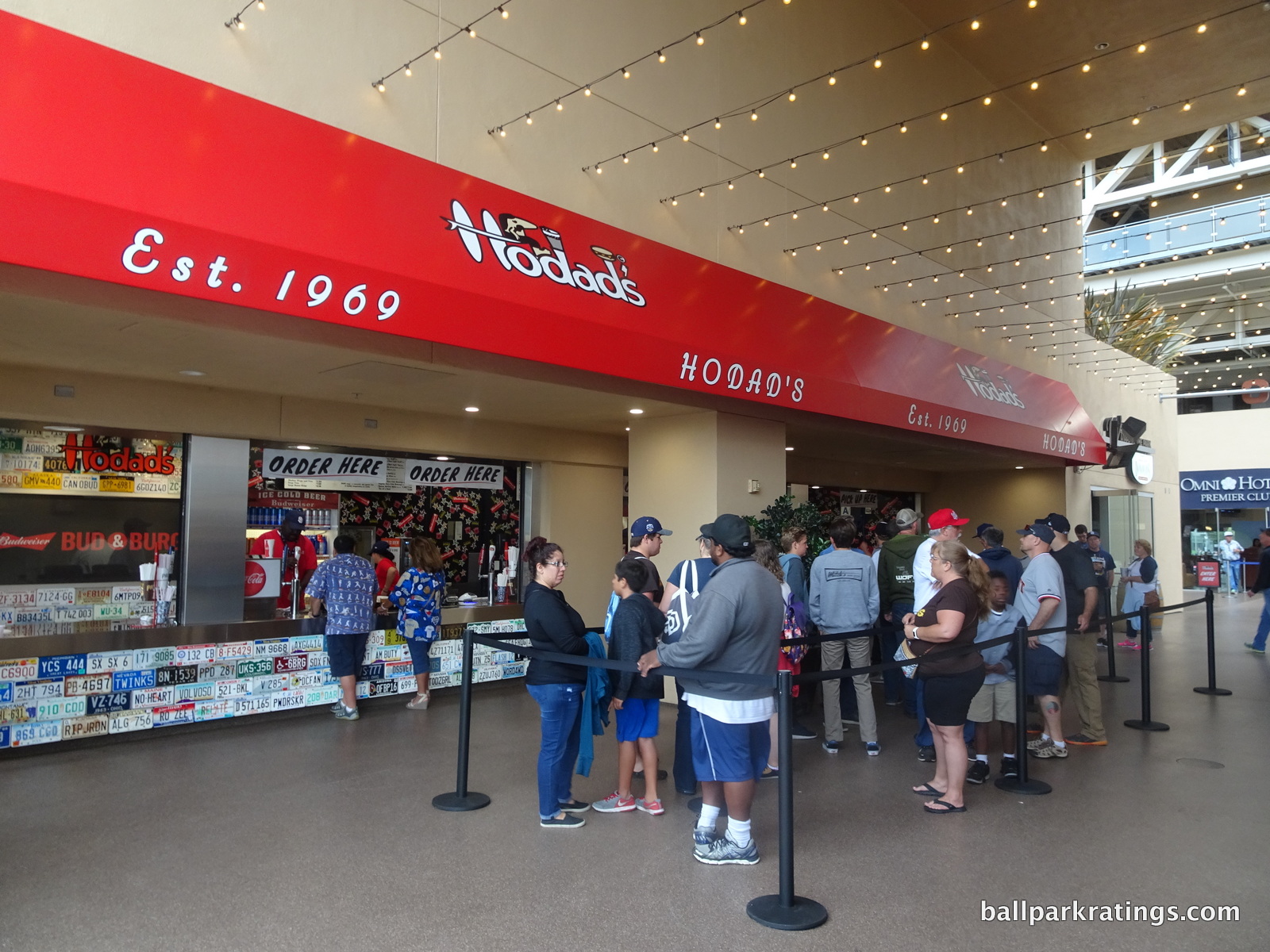
If you’re craving Asian fare (other than boxed sushi), you’ll have to head up to Zenbu’s Sushi Bar, which I discuss below.
If you’re unfamiliar with the area, most of this is still understandable. High quality fare from the sea, south of the border, and the other side of the Pacific makes sense. What you might not guess is that Petco Park features some of the best BBQ in any major league ballpark!
From Yelp to food critics reviews in San Diego Magazine, Phil’s BBQ is not only cited as the best BBQ in San Diego, but some of the best informal grub in the entire area. Rest assured, if something is highly acclaimed, the Padres will bring it into Petco Park.
Located on the main concourse with its own dedicated picnic area and in the outfield with a kiosk, Phil’s BBQ cooks up pork ribs, BBQ pulled pork sandwiches, brisket, and “El Toro,” a chargrilled deli sliced tri-tip with BBQ sauce. Randy Jones Grill is one of the few generic stands in the ballpark, serving smoked beef brisket, hickory grilled chicken, pork chops, and pulled pork. And to think, 10 years ago, Randy Jones BBQ was Petco Park’s signature food!
Even the sweet spots at Petco Park are locally oriented. The Baked Bear has their famous ice cream cookie sandwiches.
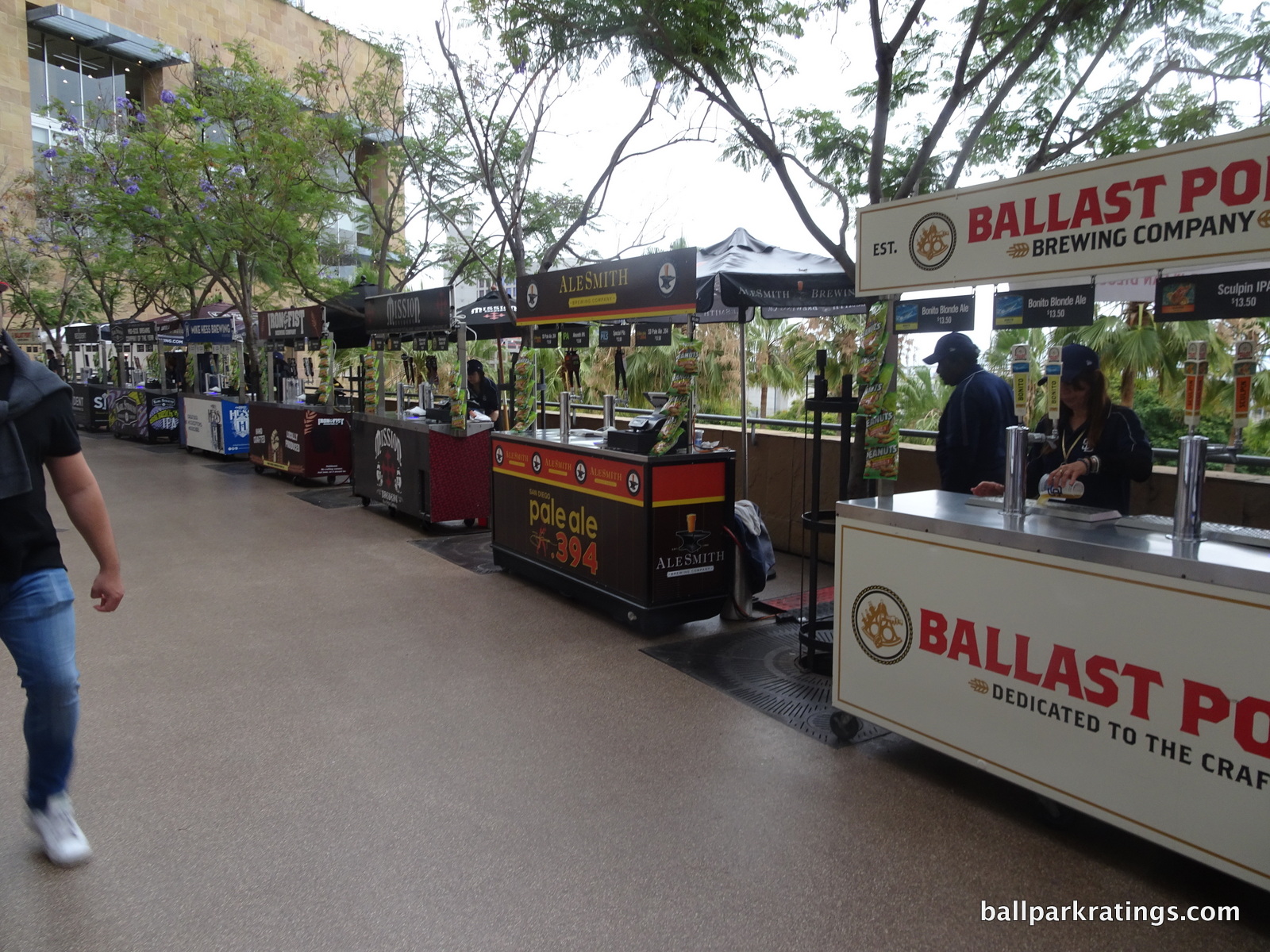
Finally, San Diego’s exploding craft beer scene puts Petco Park over the top. With over 50 craft beers on tap (other parks like Guaranteed Rate Field in Chicago have more overall), Petco Park is second only to Miller Park in craft beers on tap, at least according to the tour guide.
The most popular beer in the ballpark is the San Diego Pale Ale .394, brewed in honor of Tony Gwynn. Other local brewing companies include Stone Brewing, Ballast Point, Pizza Port Brewing Co., Mike Hess Brewery, Alesmith, and Mission Brewery. I could list at least 15 more, and most offer a wide variety of beers. Ballast Point is the most notable.
As I’ll discuss below, Petco Park also has one of the widest selection of wines of any major league ballpark.
To say Petco Park dazzles in this category would be a gross understatement. Almost every stand has its own yelp page! This might qualify as a “ballpark outlier,” a category where a ballpark dwarfs all others in baseball. With extremely impressive fare in San Francisco, Seattle, and New York (Mets), this is quite a feat and something I wouldn’t have expected 10 years ago.
Score: 5/5
Regional/Signature Concession(s)
Petco Park renders this category redundant. Almost everything is signature, local, and high quality.
If you had to pick one item, the fish taco is probably Petco Park’s signature item, and you can get that in at least four different places (Miguel’s, Luche Libre, Rimel’s, and Brigantine).
When fans are forced to pick their favorite foods at Petco Park, a few are usually emphasized. Carnitas’ Snack Shack is always mentioned, as their pork-centric menu staples are becoming more and more popular throughout San Diego. I probably would have been reminded to sample this if it was better located.
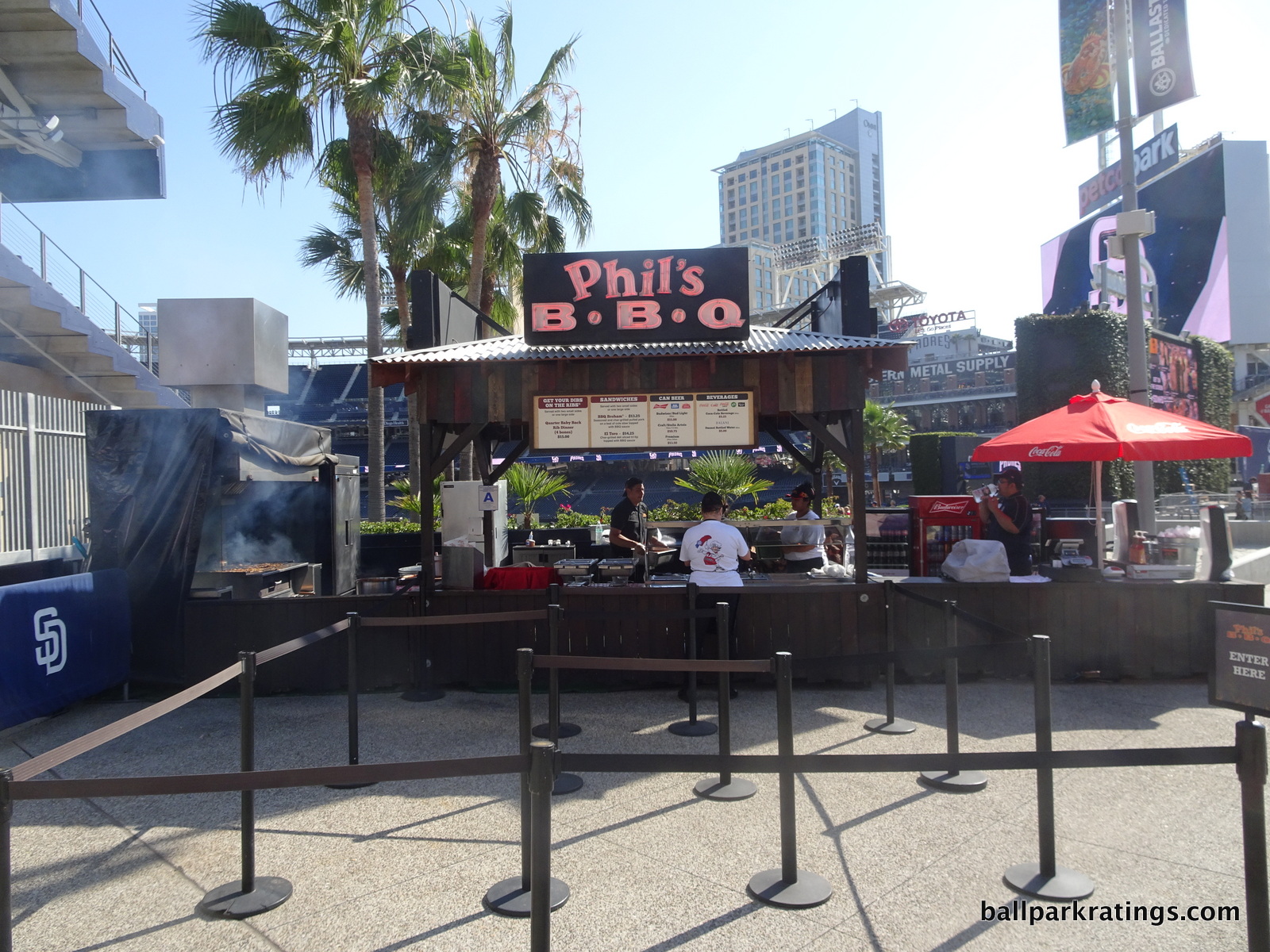
The other three most commonly mentioned items are Hodad’s Bacon cheeseburger, the tri-tip sandwich at Seaside Market, and anything at Phil’s BBQ. But almost everything at Petco Park is excellent.
There’s an interesting drink you might see flowing around at Petco: The Michelada. It’s a Mexican beer cocktail kind of like a Bloody Mary, but with beer. At Petco, the Estrella beer is made with clamato juice, tajin spice, lime juice, shrimp, and habanero pepper.
I was able to sample Hodad’s cheeseburger, Phil’s BBQ ribs, Luche Libre’s Surf N Turf taco, Rimel’s fish taco, and Brigantine’s famous fish taco. They all lived up to the hype, but the latter was probably my favorite.
Score: 2/2
Accessible Restaurants/Bars/Sitting Areas/Social Spaces
While you could conceivably argue another park outdoes Petco in terms of concession stand food and beverages, the superiority of San Diego’s series of full-service restaurants/bars and social spaces open to all fans is undeniably unmatched.
Part of this is a function of the Padres opening the Toyota Terrace level (former de-facto club level) to all fans, but Petco Park prioritized places to hang out from the outset. If you had any plausible critique, it would be the lack of field views from most of the restaurants.
Let’s detail the 10 spaces I listed in the opening. This level of analysis isn’t overkill, as Petco Park triples (triples!) the average ballpark in sheer quantity of notable spaces. Whereas Petco Park’s food is so good it might qualify as a “ballpark outlier,” the park’s series of spaces in this category indisputably qualify as such.
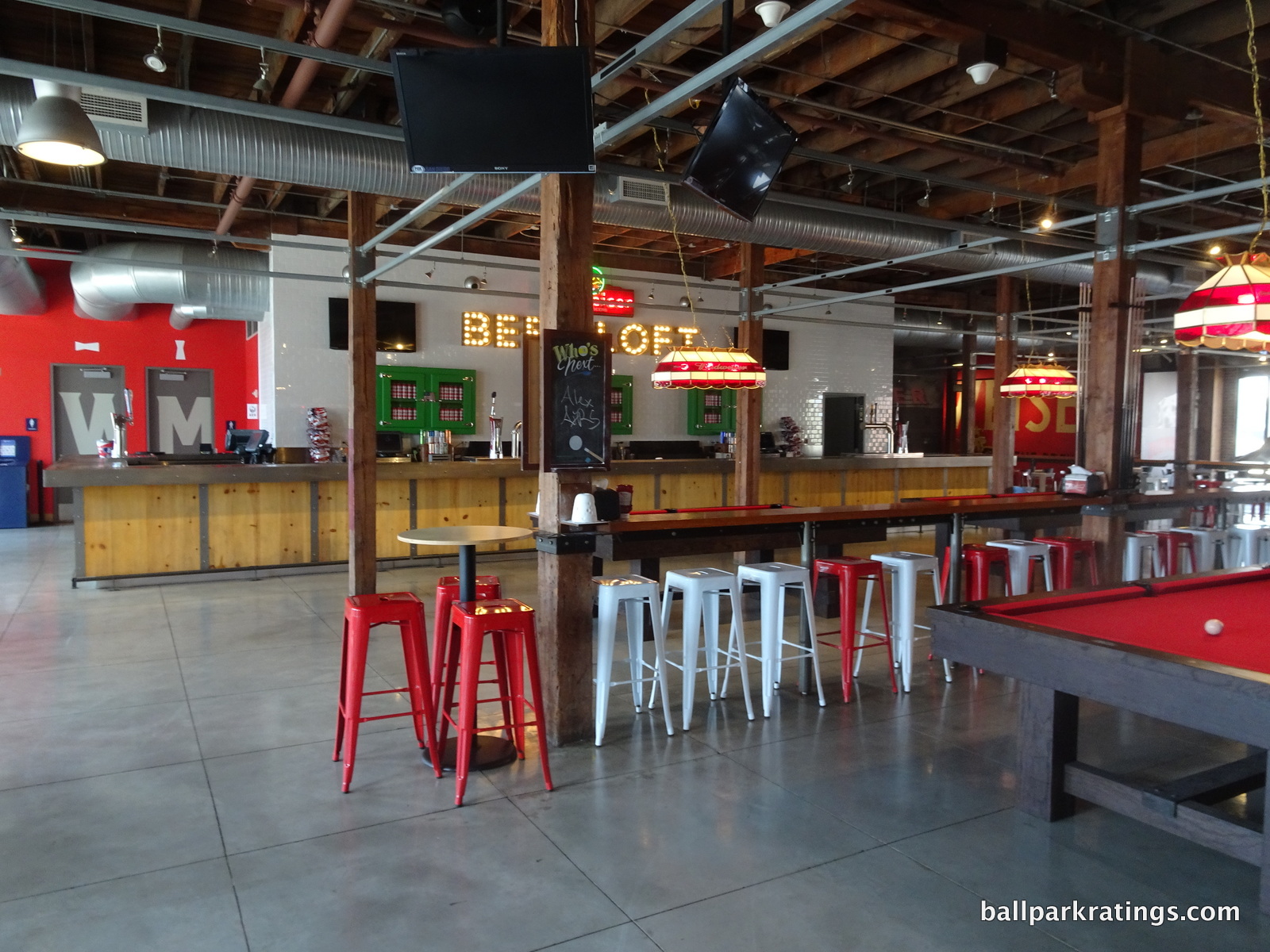
Originally known as the Hall of Fame Bar and Grill, Petco Park’s signature restaurant is the Budweiser Beer Loft located on the 4th floor of the Western Metal Supply Co. building (which is really the 5th floor of the entire ballpark). The informal eatery features full table service and a walk-up bar. The highlight of the restaurant is the entertainment options, which include pools tables, foosball, and shuffle board. How many ballparks have billiards? I’d have to think about that one!
The only downside is that the outdoor seating has been converted into a private group space, so the restaurant lacks good field views.
On the garden level above the main concourse, the Padres’ most centrally located full-service restaurant and bar is Ballast Point’s The Draft (formerly known as the PCL restaurant). The indoor dining area is laid back, and the outdoor area overlooks the cascading gardens of the main concourse. For whatever reason, this area has never been very popular. The waitresses were quite excited to see me taking pictures. I suspect the lack of field views and notable cuisine is the culprit. Serving generic wings, fries, chicken, and burgers, the food is better at the other restaurants and concession stands.
On the main concourse opposite the Omni Premier Club, Donovan’s Wine Bar has perhaps the most impressive wine selection seen in a ballpark. I counted 41 wines available by the bottle, the most expensive of which goes for $500. Don’t worry, you can take your vintage cabernet to your seat! They also sell 25 wines by the glass.
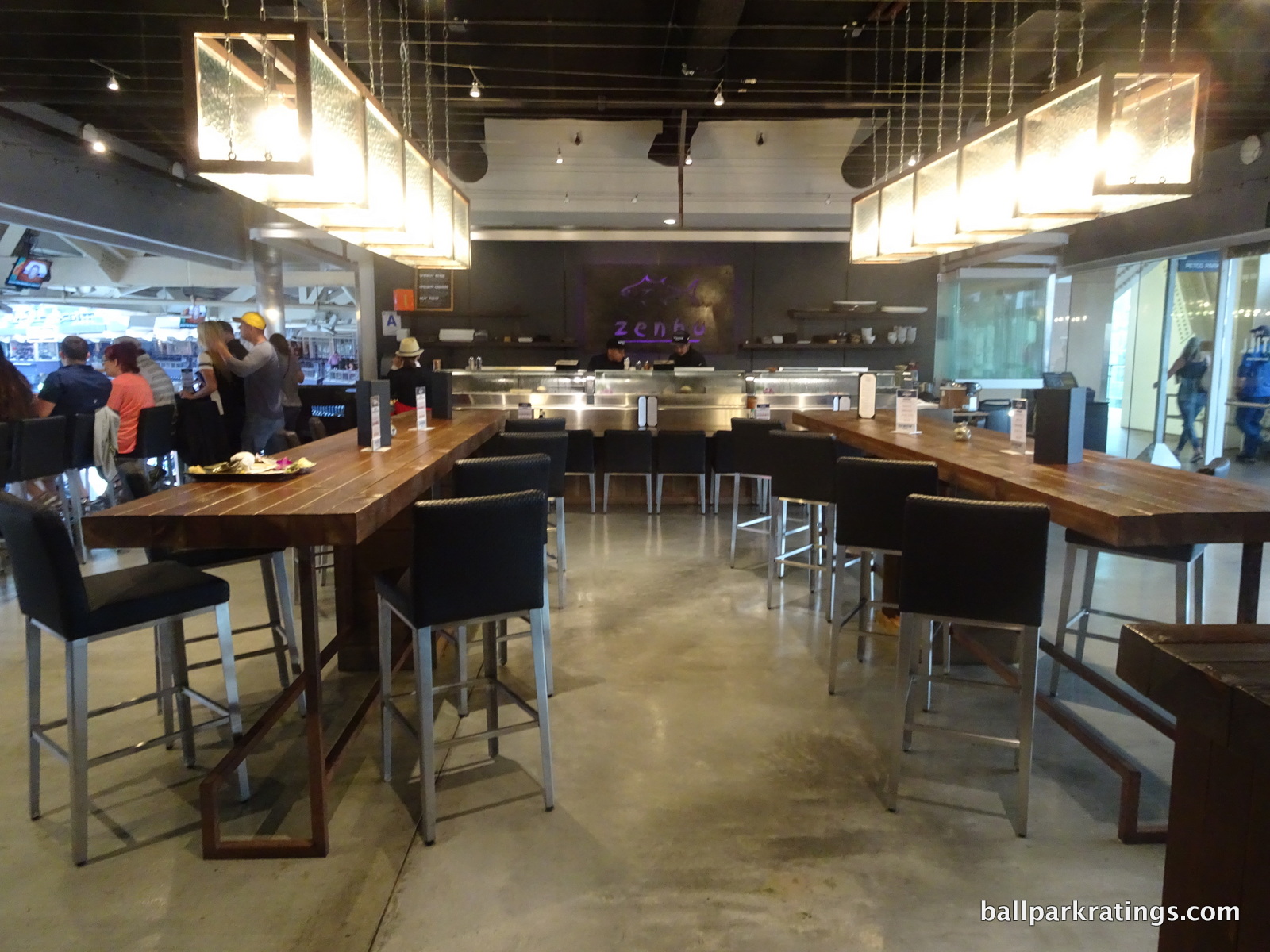
Most of the fun starts on the Toyota Terrace level, featuring three climate-controlled options and a picturesque outdoor bar. Located in the left field corner, the Zenbu Sushi Bar has an awesome selection of sushi, beer, wine, and specialty cocktails. This is the only restaurant on the terrace level with a field view. The restaurant has a sushi bar, an indoor dining area, a sit-down drink rail area overlooking the field, and an outdoor patio overlooking the field. Notable delicacies at Zenbu include their albacore roll and the hot tail sashimi.
The other three establishments of note on the terrace level are separated from the terrace concourse in the outer garden buildings, sporting scenic views of the San Diego Bay and/or the surrounding area, but not the field.
Club 19, now sometimes known as the .394 club (the Padres are inconsistent about branding for some reason), has traditionally been deemed the nicest space on the terrace level. Featuring a scenic outdoor patio and brown leather couches in the spirit of coffee table-style seating, Club 19 is an understatedly attractive and cozy space, if not a little bit stale.
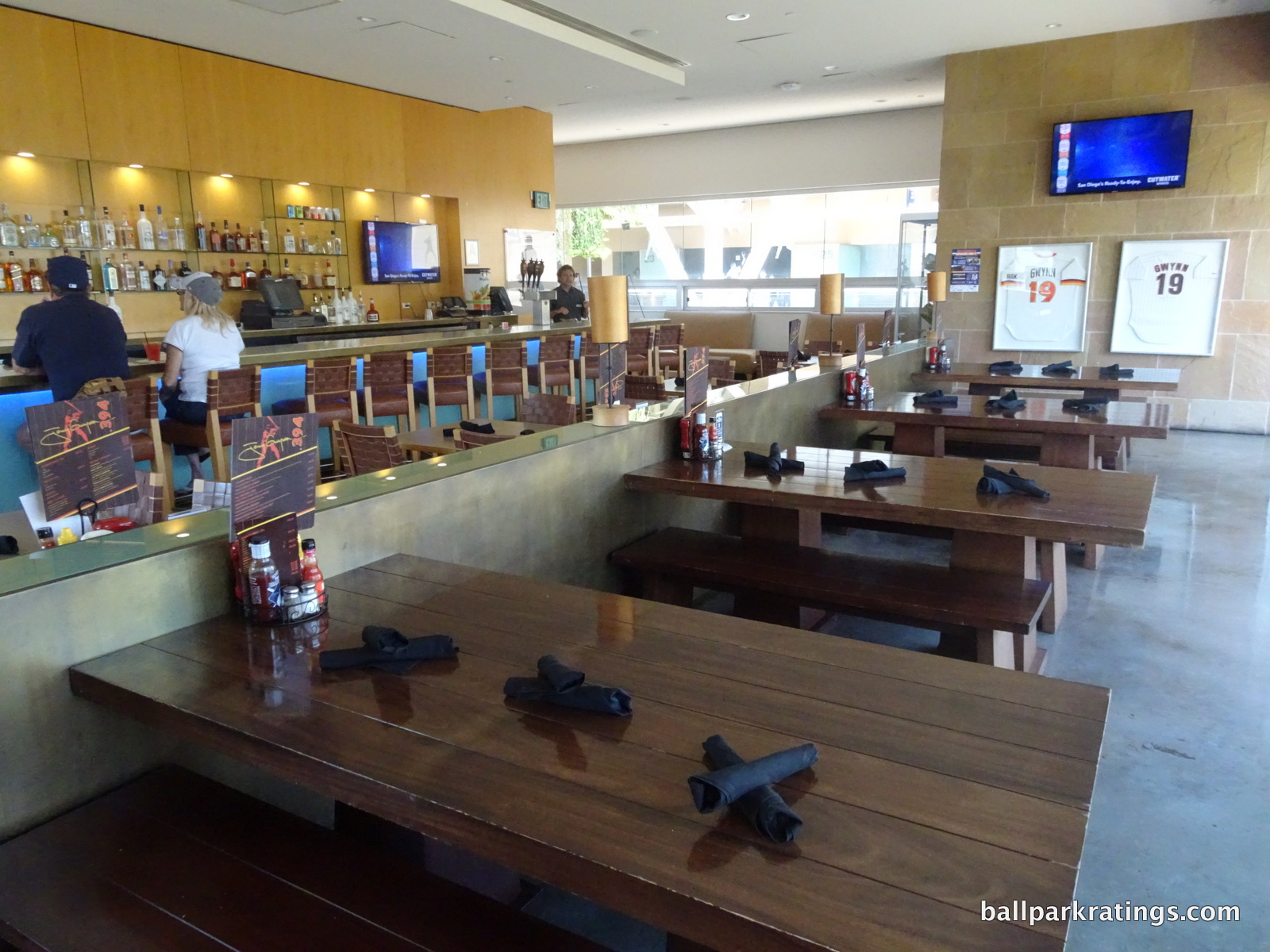
The climate-controlled restaurant features full table service and a full sit-down bar. Note the Tony Gwynn memorabilia throughout the club space, including photos, jerseys, Gold Glove awards, memorable quotes, and statistics. It appears the Padres are in the process of overhauling the décor of Club 19, judging by the new renderings in the entryway.
Formerly known as the Baja Bistro, the Broad and Brew is a fast casual concept located at section 205 on the first base side behind home plate. The design is less upscale than Club 19 or Zenbu, but the quality of the food more notable, featuring an expanded selection of the top-shelf sandwiches served at the Broad and Brew concession stand. The restaurant doesn’t feature full-service table seating (fast casual), but there is a full-service bar. The colorful décor evokes an informal tropical joint. Located a floor above Ballast Point’s The Draft, the eatery lacks outdoor seating but features nice views of the San Diego Bay.
Finally, Coronados (now partially rebranded the “Brigantine Bar,” but again, it’s unclear) is a completely open-air, full-service bar overlooking the San Diego Bay and the Convention Center. Sporting some of the best views in the park, be sure to check out the sunsets from this perch. While adjacent to the Brigantine concession stand, only drinks are served at Coronados, but there are plenty of tables and chairs. Feel free to bring your food here and enjoy the view. The outdoor bar includes a fireplace.
Transitioning to the outfield concourse, Petco Park now has a bona fide social space overlooking the field. Inspired by San Diego’s beach lifestyle and iconic piers, The Craft Pier is (almost always) open to all fans. The space features pilings and decking constructed from compost woods, drink rails, beach lounge chairs, and patio tables.
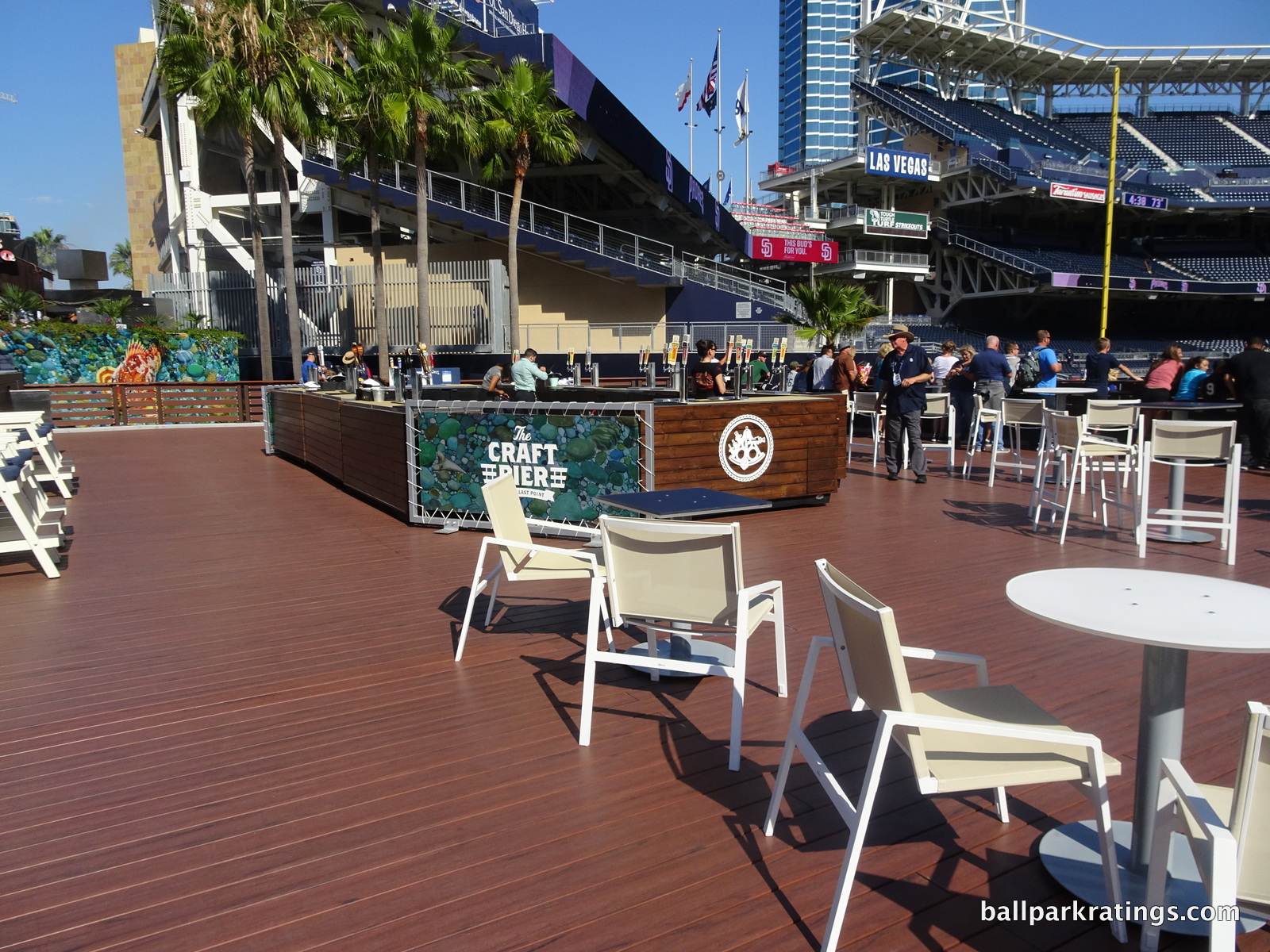
While liquor, wine, and food is not served, this is Petco Park’s destination for sampling the city’s finest craft breweries. As with all spaces, you are free to take your drink out of the direct area. The lower tier of the pier is reserved for groups.
Finally, let’s head on up to the upper deck. A handful of ballparks have full-service bars on the upper deck concourse, but Petco Park outdoes them all with perhaps the best full-service restaurant the entire park has to offer. This is the only time I can remember where I would advise you to head to the upper deck even if you have access to all of the amenities on the lower levels.
Providing the best views in the entire park, the open-air Wonderland Ocean Pub serves their signature drinks and great food. The well-known San Diego establishment serves their specialty cocktails—try the Old Grove Refresher—paired with unique fare. Menu items include the Mac Daddy Ahi Poke, ceviche, and the Ocean Pub Burger. The tabled picnic seating is informal, but there is a full-service bar with chairs. Crowned with suspended hanging light fixtures, the vantage point is the highlight.
Located on top of the Western Metal Supply Co. building at the end of the left field upper deck concourse, Rimel’s Rotisserie provides more tabled seating. The food resembles that served at the Rimel’s stand downstairs, and seating is first come first serve. There is no full-service bar, and part of it is sometimes reserved for groups.
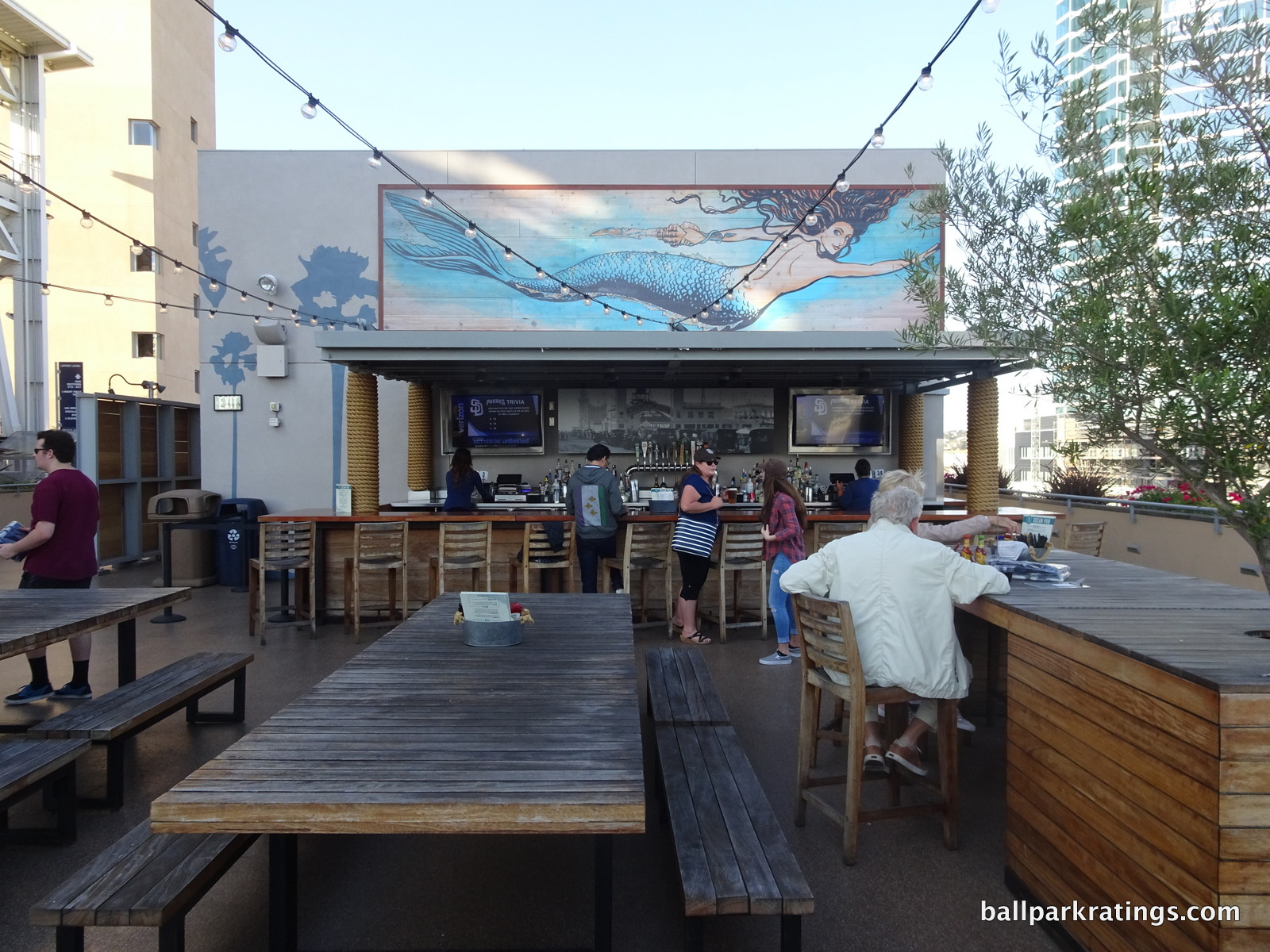
After discussing Petco Park’s 10 unique restaurant/bar/sitting spaces, there are two other areas of note. While it doesn’t constitute a restaurant, Phil’s BBQ concession stand at section 113 features its own dedicated picnic area. There are generally more chairs and tables throughout the concourses than usual. There is also the Ballast Point Beer Garden behind section 228, which is very easy to miss.
I think it’s important to take a step back and put all of this in perspective.
At one end, you have the set-up at Marlins Park, which literally has a walk-up bar in left field and nothing else (remember, we’re talking about spaces accessible to all fans). An average ballpark might have a full-service restaurant, a fast casual dining space, and another full-service bar/social space. At the higher end, baseball has something like Coors Field, Comerica Park, or Yankee Stadium, which may feature multiple full-service restaurants, breweries, and rooftop bars.
Then you have Petco Park, which could be defined as having five full-service restaurants/bars, two more fast-casual dining areas, an expansive outfield social space with over 50 beers on tap, a wine bar, a signature ocean view full-service bar, and a number of picnic areas.
Other parks during the new millennium should have strived to create a similar series of well-defined destinations within their ballpark. I can’t think of another example where a ballpark outdoes all other ones to such an extreme degree in one category.
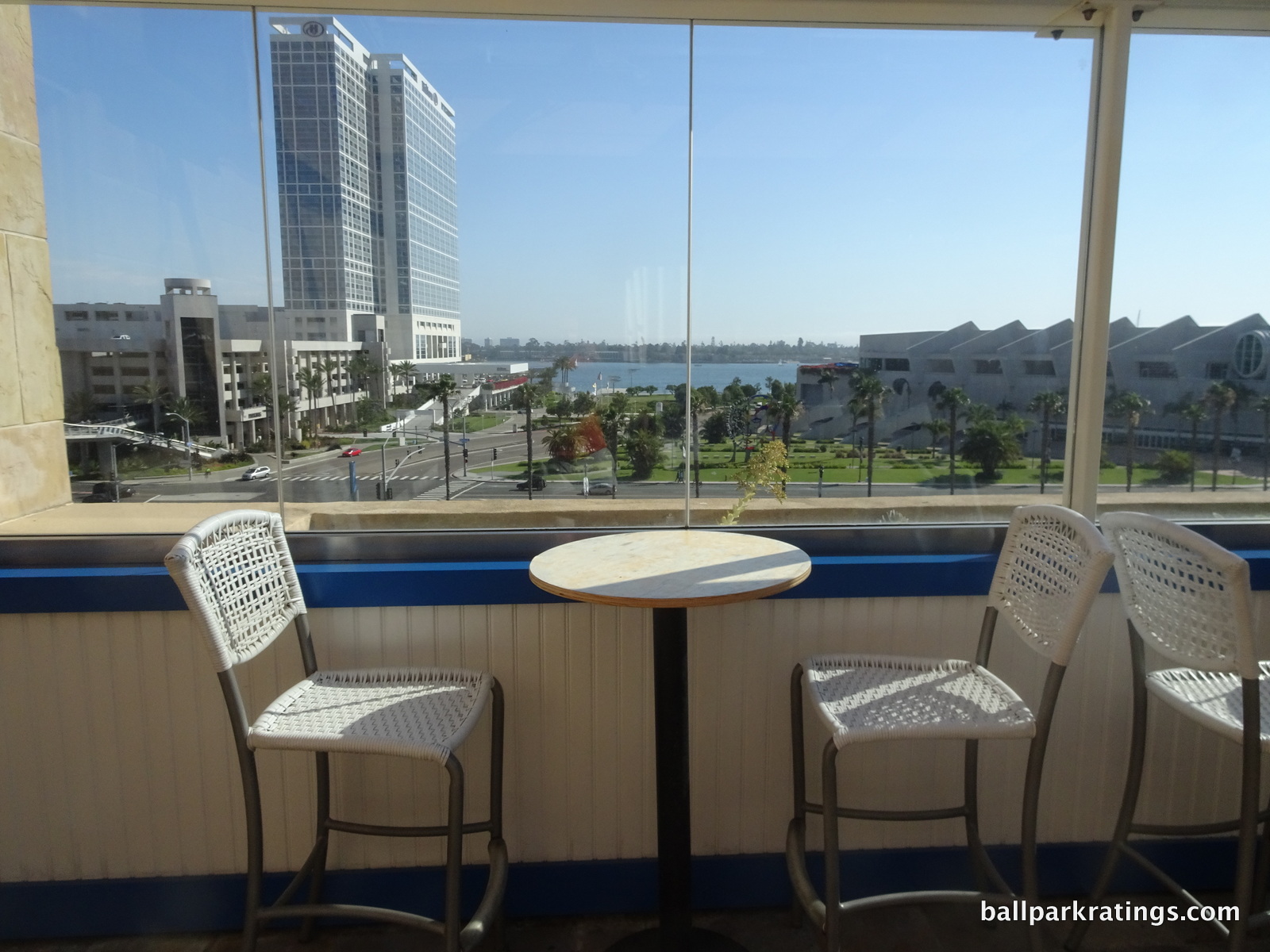
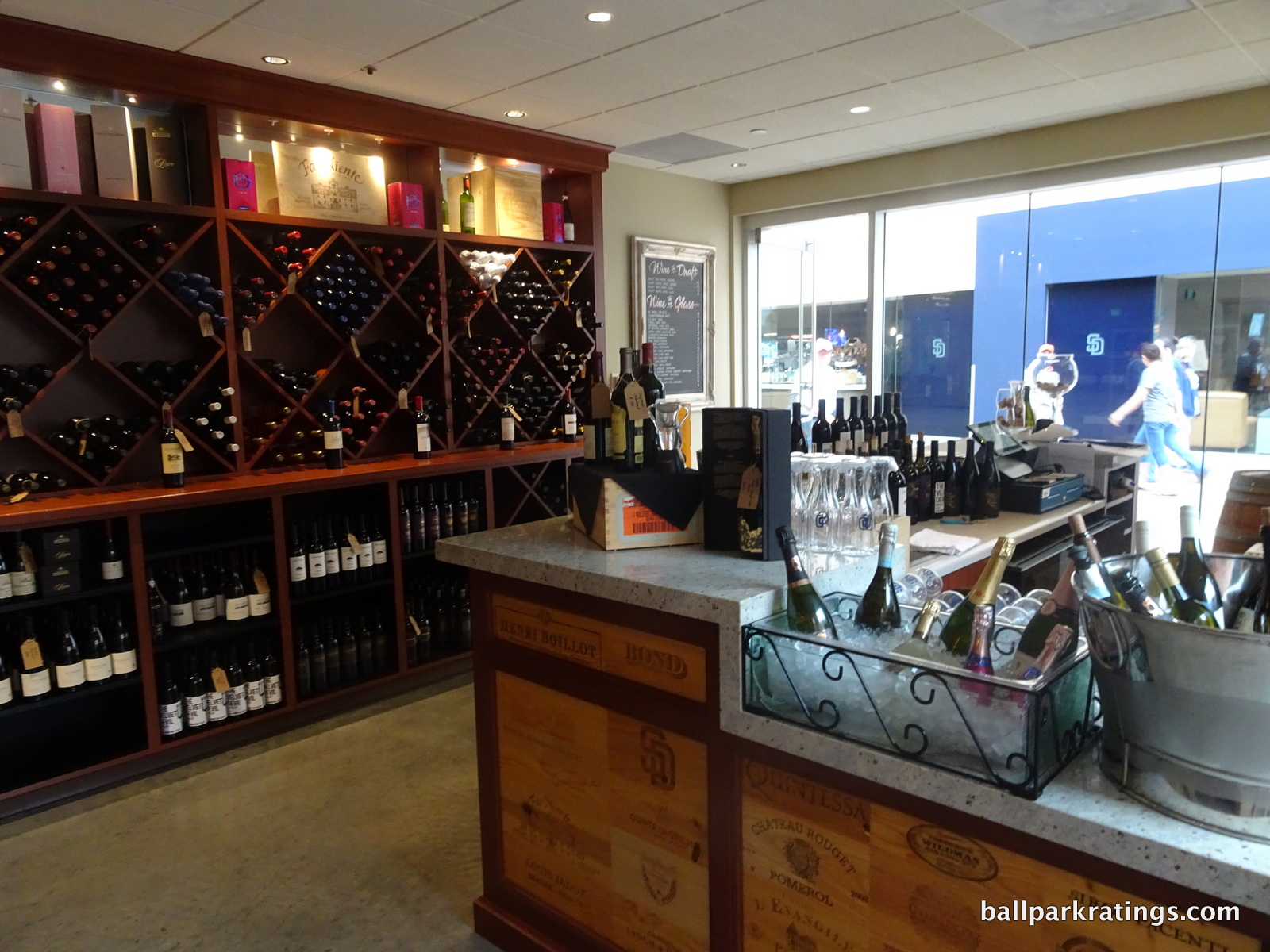
Score: 5/5
Premium Seating/Clubs
With a small corporate market and team insistence on opening up as many spaces as possible to all fans, Petco Park simply doesn’t have the premium seating inventory of most other parks in Major League Baseball. This is mitigated by mostly great quality, a few puzzling concepts notwithstanding.
Part of the issue was that it was difficult for the Padres to mold this category to fit the San Diego environment. Club levels and fancy restaurants traditionally require lots of enclosed, climate-controlled areas, which aren’t conducive to Petco Park’s open, airy design or fantastic climate. Constructing traditional “club seating” with climate-controlled concourses just didn’t make sense here, for example.
The Padres responded with the Toyota Terrace level, situated on the mezzanine where club levels are traditionally positioned across baseball. Instead of enclosing the terrace concourse, they kept the hallway open and built three premium spaces detailed above in the garden buildings on the outer part of the structure overlooking the bay. Fans take bridges to get to them across the terrace level hallway. The fourth space (Zenbu Sushi Bar) is on the other side overlooking the field. These spaces were originally reserved for club seat ticket holders or those on this level, but all fans are now given access to these spaces. The model of the Toyota Terrace level was never too “premium,” anyway.
So, Petco Park is only the second ballpark built since 1991 (the other being Comerica) to lack a significant club space on the mezzanine.

The Lexus Home Plate Club is Petco Park’s ultra-premium option behind home plate, but it’s smaller and more exclusive than others seen across Major League Baseball. While the décor of the restaurant and lounge isn’t the most inspiring, everything else about the Home Plate Club experience blows you away, in what is one of the top-5 clubs behind home plate in the majors.
Confined to only 222 seats, all of which are in front of the back of the dugout from end to end around home plate (in other words, everyone is closer than a fan sitting in the first row behind the dugout), these are some of the hardest tickets to obtain in baseball. I’ve always tried to sit in a ballpark’s best seats to get my readers the best pictures, but the Padres’ Lexus Home Plate Club goes into the category of “no sane person would buy these,” beyond even the Legends Suite at Yankee Stadium (where ticket prices can go way down on the secondary market). When they enter the secondary market, they’re often more expensive than the cheapest seat in a large ultra-exclusive club like at Yankee Stadium because of the scarcity.
All of the requisite amenities people have come to expect are included: all-inclusive food, beer, wine, and liquor, fully padded seats, in-seat service, valet parking, and batting cage views. The private entrance is located behind home plate by the retired numbers. One unique perk is the access to private lockers. Another is that the seats themselves feature fold out tables that come out of the armrest, like at a domestic first class airline seat. I’ve never seen this at a ballpark.

Whereas most such clubs have one dedicated space, the Lexus Home Plate Club has multiple spaces for well-connected fans to enjoy. The experience includes access to a private bar area upon entering, an exclusive indoor dining area next to the batting cages, and a more informal lounge space with indoor and outdoor patio seating centered behind home plate. I’ve sat in the best seats in most major league ballparks, and the Lexus Home Plate Club at Petco Park is something to write home about, distinguishing itself from other ultra-exclusive clubs in baseball.
Petco Park’s secondary premium option is the Omni Premier Club. Located on the left side behind home plate on the main concourse, the club is accessible to those in sections A-L (Premier Club) and some other premium areas. I’m not entirely sure I like the set-up here. The Omni Premier Club functions more as a high-end buffet (with food and beverages not included in the ticket price) restaurant than as an exclusive club space. If fans weren’t privy to eating at the $39.00 buffet, there would be no reason to come here.
While the full-service bar and outdoor dining overlooking the field are worth checking out, the décor inside the club is a bit tired. The club space is not directly connected to the seating either, and won’t even have a bathroom if the left side of the club is being rented out for a group function. Located in the upper part of the lower bowl, most premier club seats directly access the main concourse. This doesn’t resemble the true premium spaces around the majors. The main perk might be the padded seats and in-seat service.
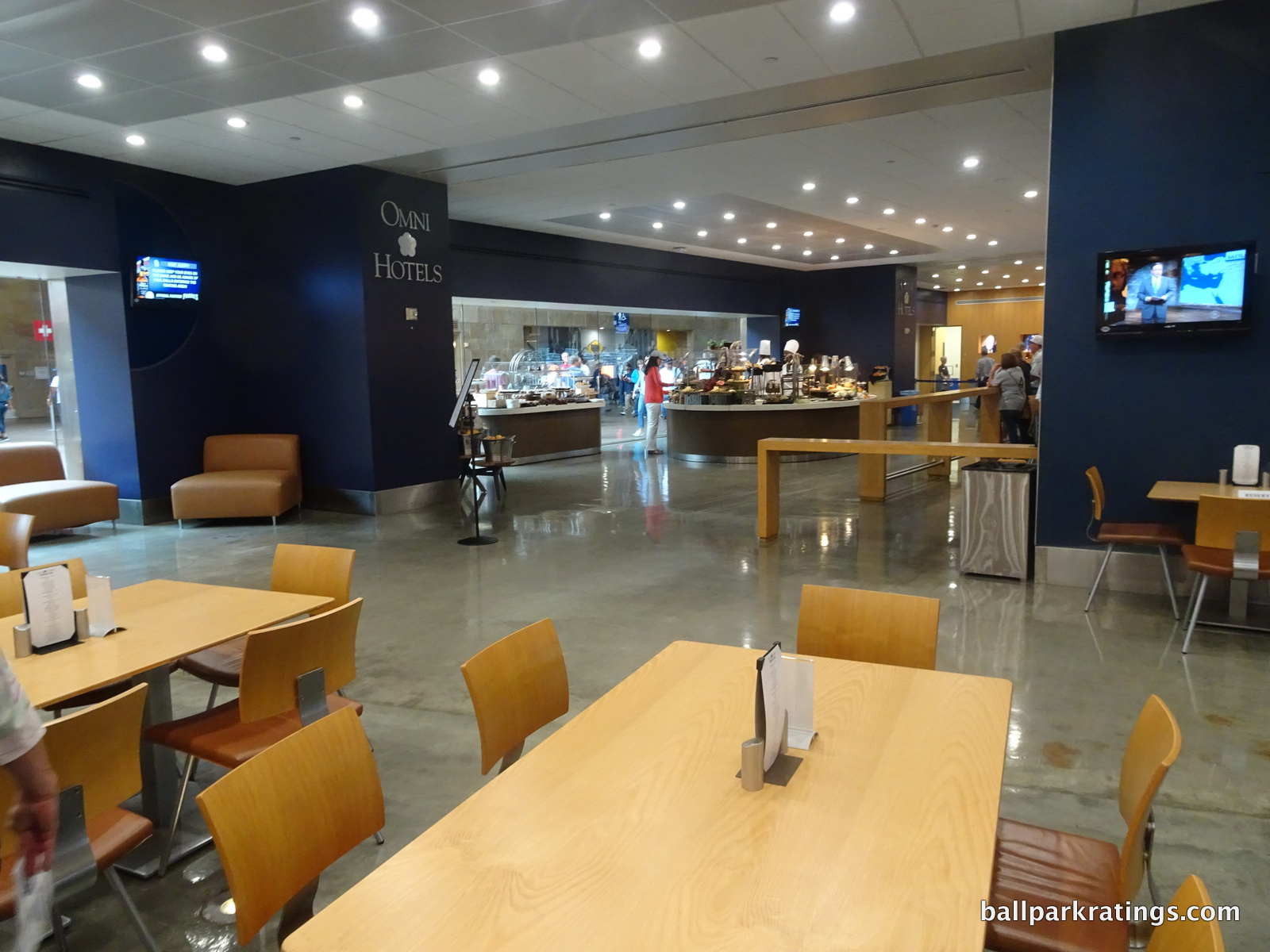
Located down the lines, the small First Base VIP Box and the Third Base Coaches Box are premium seats of note, with the former featuring all-you-can-eat food delivered to your seat. They don’t feature their own unique “clubs,” but you have access to the Omni Premier Club.
While no longer classified as premium seats, all seats on the Toyota Terrace level have padded bottoms, and sections 201-210 still feature in-seat service.
Attempting to cultivate outdoor premium spaces, the Padres recently created a membership lounge (called “Membership Lounge” sponsored by Herradura Tequila) off the main concourse behind home plate overlooking the San Diego Bay. Formerly a bar part of the Mercado food court, it was probably wise to create a new premium space. There isn’t much of an upgrade in amenities because the regular spaces are so great. All season ticket holders have access to this space. Located completely outdoors, the Membership Lounge features comfy couches, a full-service bar, and live pre-game music.
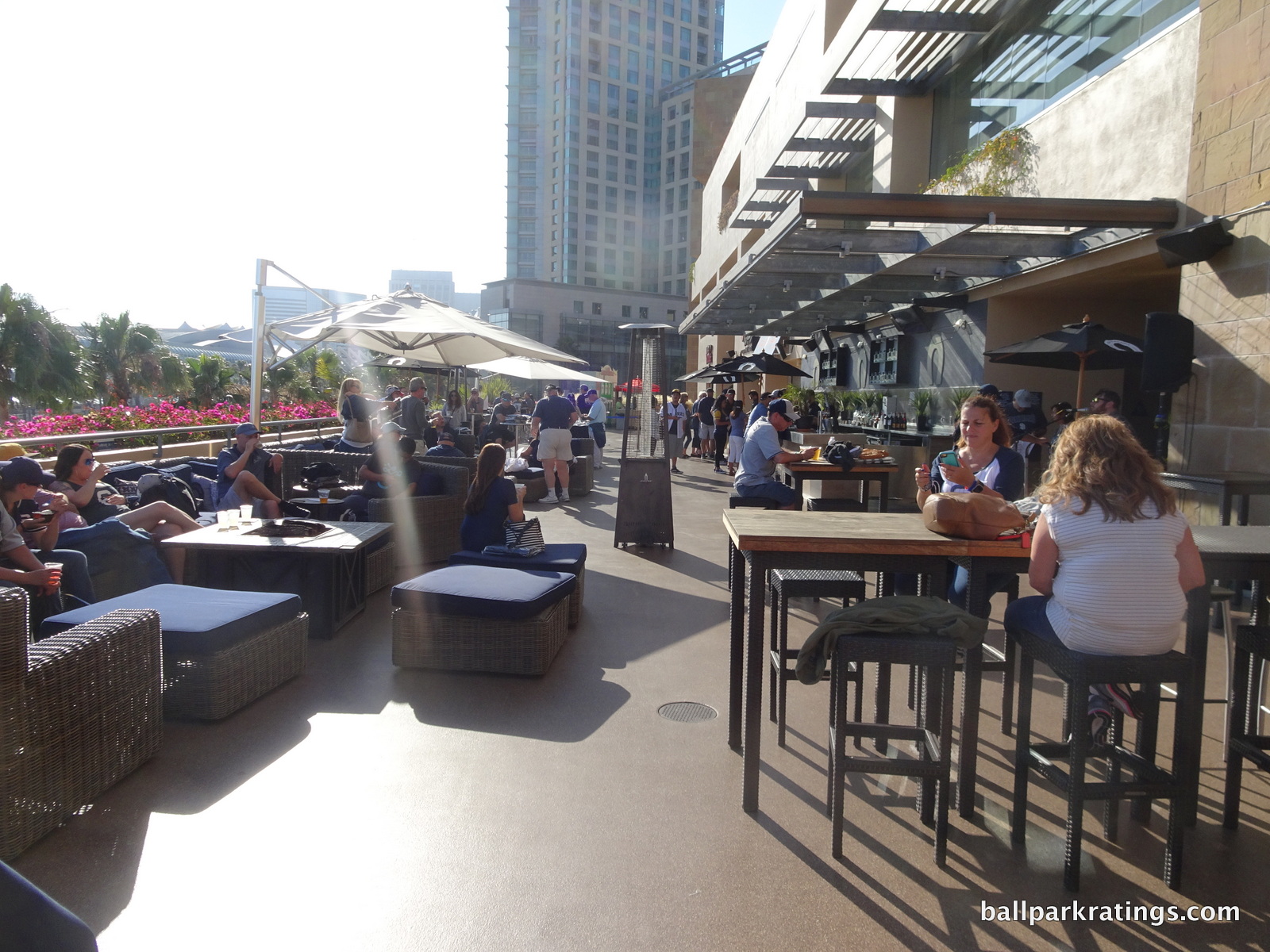
Besides the usual bevy of creative group areas, the Padres feature one more notable premium option worth discussing. Resembling the loge boxes of NBA or NHL arenas, the “Home Plate Box Seats” are boxes of 4-6 seats with reclining leather couches and private HD TVs. These were added after the fact behind the 100-level behind home plate in front of the premier club seating. The Padres also added terrace tables in front of the press box on the terrace level. These options could be thought of as a middle ground between luxury suites and club seats.
Petco Park features 58 luxury suites, a fairly standard (if not a tad conservative) number for 2004. All suites feature retractable doors that expose the entirety of the indoor area to the field, a rarity in suite design. The main suites are located along the main concourse at the back of the lower bowl (premier club suites) and at the back of the terrace level (terrace suites). These suffer from minor overhang issues unlike the best suites in baseball. The tower loft suites are located in the light towers, one of Petco Park’s signature architectural features. Oddly, Petco Park’s best suites, located behind home plate below the terrace level but above the main concourse, are group suites.
While the Padres don’t overdo it in this category, the model largely fits their market. They could use a few more true premium options, as this prevents them from having a perfect amenities score.
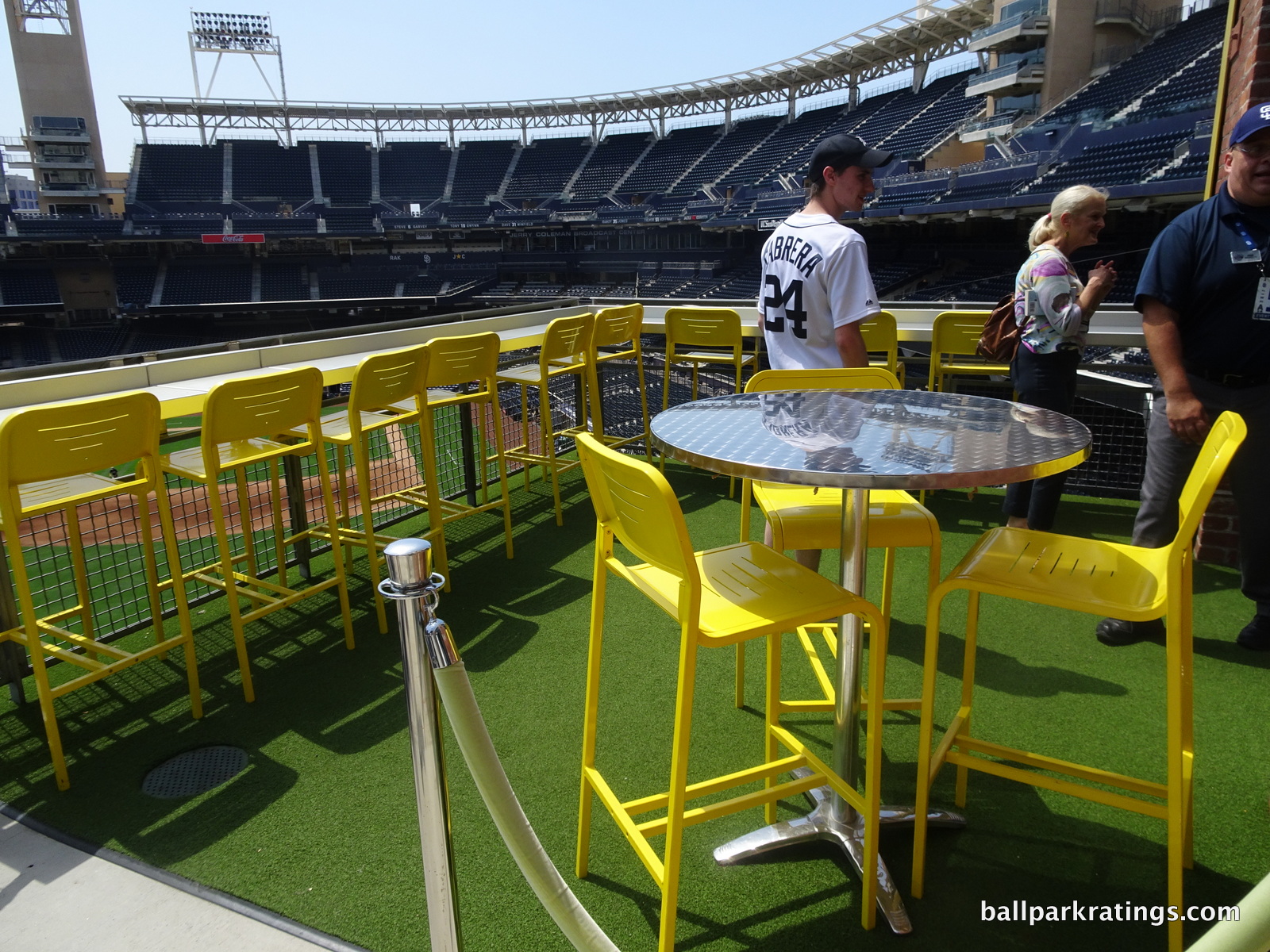
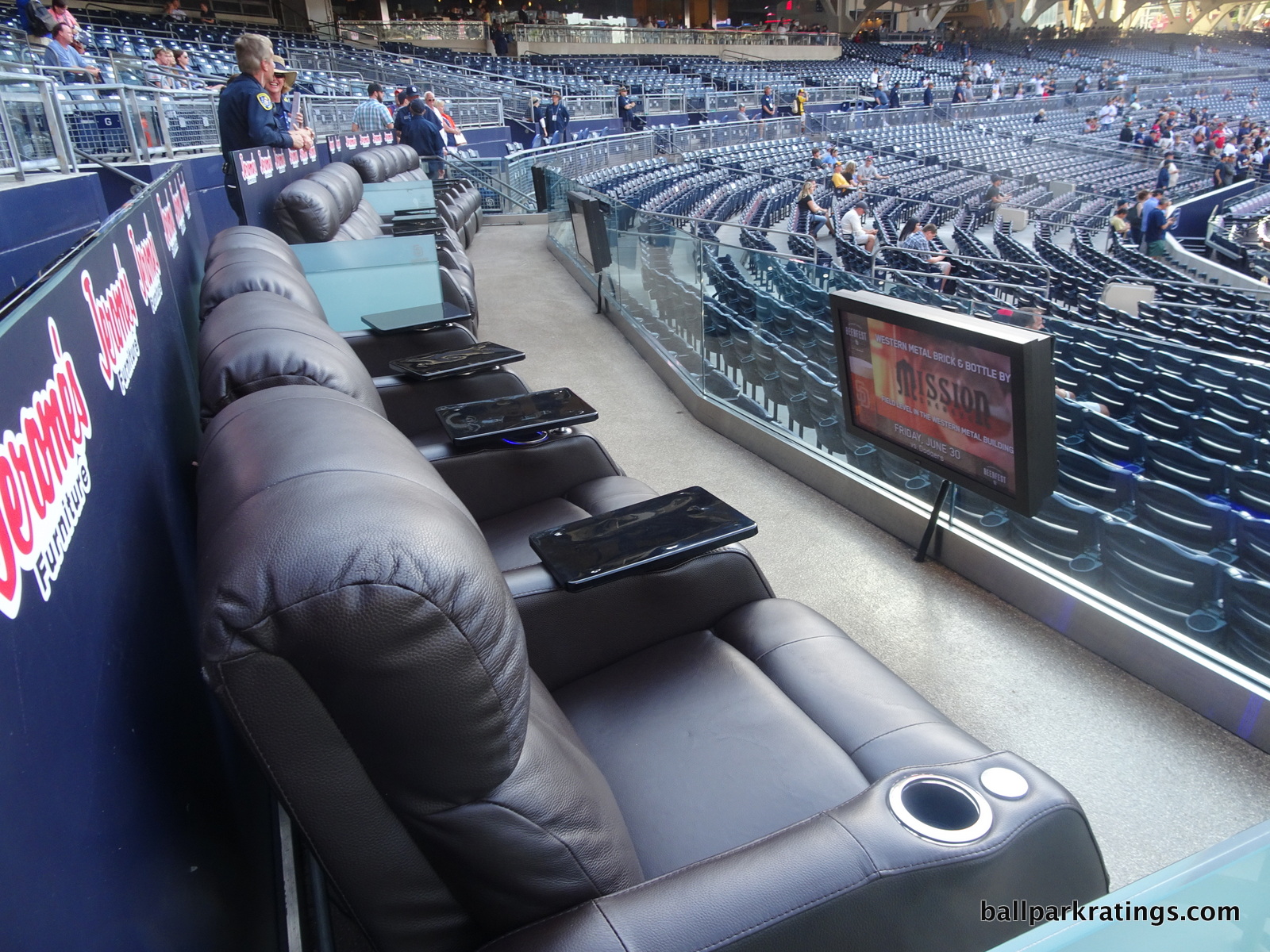
Score: 3.5/5
General or Artistic References to Baseball or Team History/Museums
Petco Park has traditionally been known as a rather ahistorical ballpark with regard to team history. San Diego has a rather rich baseball tradition, but that story went untold at Petco Park for years. Added in mid-2016, the Padres Museum and Hall of Fame largely rectified Petco Park’s most noticeable flaw.
Located just inside the ballpark gates in left field, the Padres Hall of Fame Plaza is located in the outside courtyard. Most notable is the wall titled “Padres in Cooperstown” that includes plaques of 16 National Baseball Hall of Famers who wore a Padres uniform or were connected to San Diego baseball in some fashion.
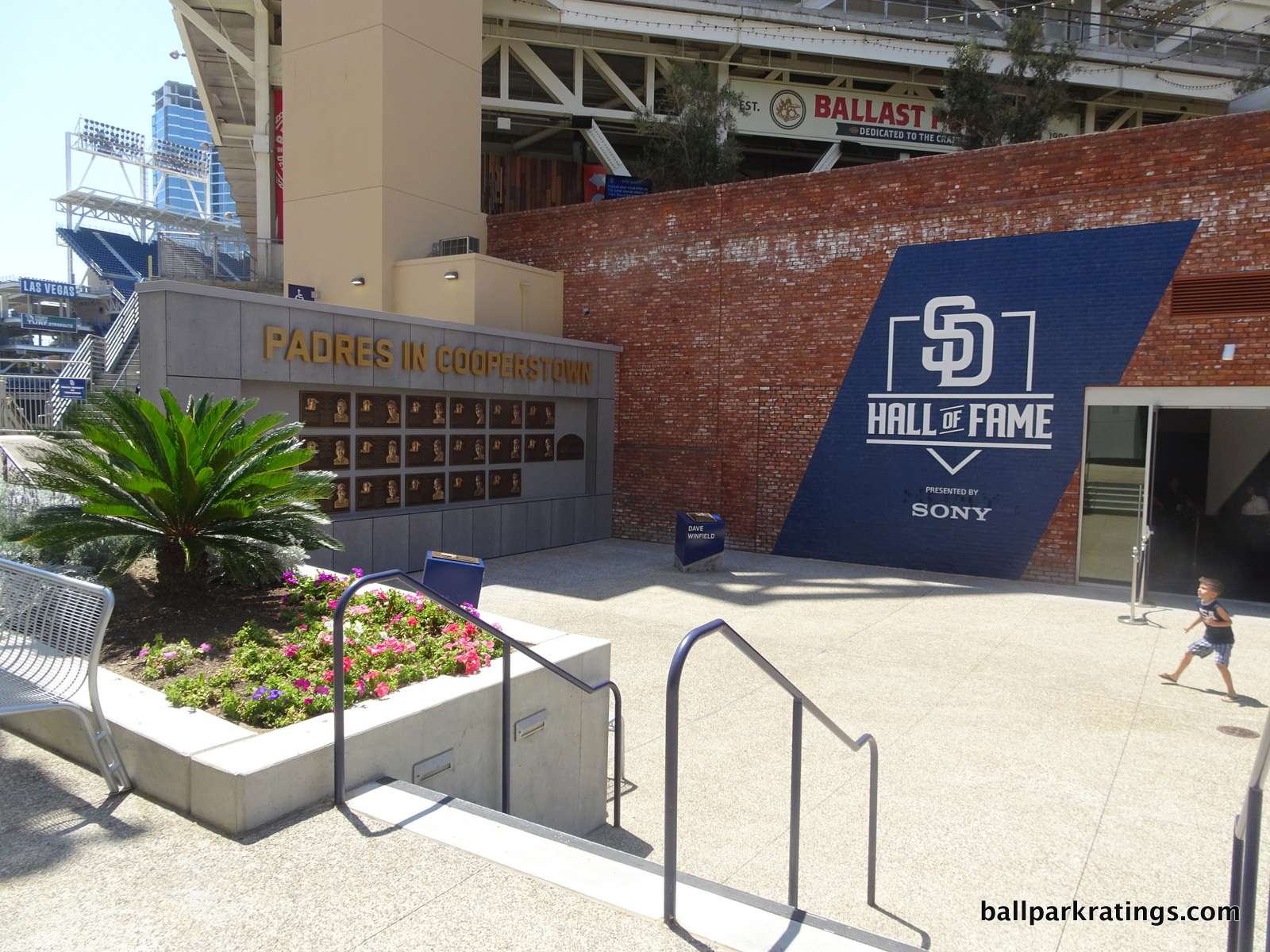
Monuments of Tony Gwynn and Dave Winfield are placed in front of the “Padres in Cooperstown” plaque area to signify their status as the two National Baseball Hall of Famers who spent at least a significant part of their careers with the team. The conspicuously large space in between the monuments is being reserved for Trevor Hoffman, who will almost certainly be inducted in 2018.
A front window display called “Padres Honors” showcases the Padres’ 23 Gold Glove winners, 19 Silver Slugger awards, four Cy Young Award winners, two National League championships, and a marker for the 2016 All-Star Game.
Inside the actual museum is a timeline of Padres’ history and baseball history in San Diego divided into three categories: “Before the Padres, 1871-1935,” “The PCL Padres, A Franchise is Born, 1936-1968,” and “National League Padres, 1969-present.”
Historical photographs, video displays, and baseball memorabilia line the walls beginning with the first baseball game played in San Diego. Artifacts and memorabilia include significant bats, balls, bases, jerseys, and trophies.

In the center of the museum, the Padres placed illuminated panels with pictures and career information of the 13 members of the Padres Hall of Fame.
The Museum and Hall of Fame features an obligatory list of Padres all-time leaders. The experience ends with an interactive video display. The museum is not nearly as large or elaborate as those in Cincinnati or St. Louis, which are destinations in their own right, but it’s a tasteful exhibition.
There is a trend toward foregoing extensive ballpark museums in favor of integrating team history into common areas of the park, like the “decade bats” at Comerica Park or Monument Garden at SunTrust Park. The thought is most fans aren’t going to go inside one isolated area, so teams should spread the historical references throughout the main concourses. I generally agree with this new philosophy. But it simply wouldn’t have worked here given Petco Park’s exposed concourse design, so I’m happy with this setup.
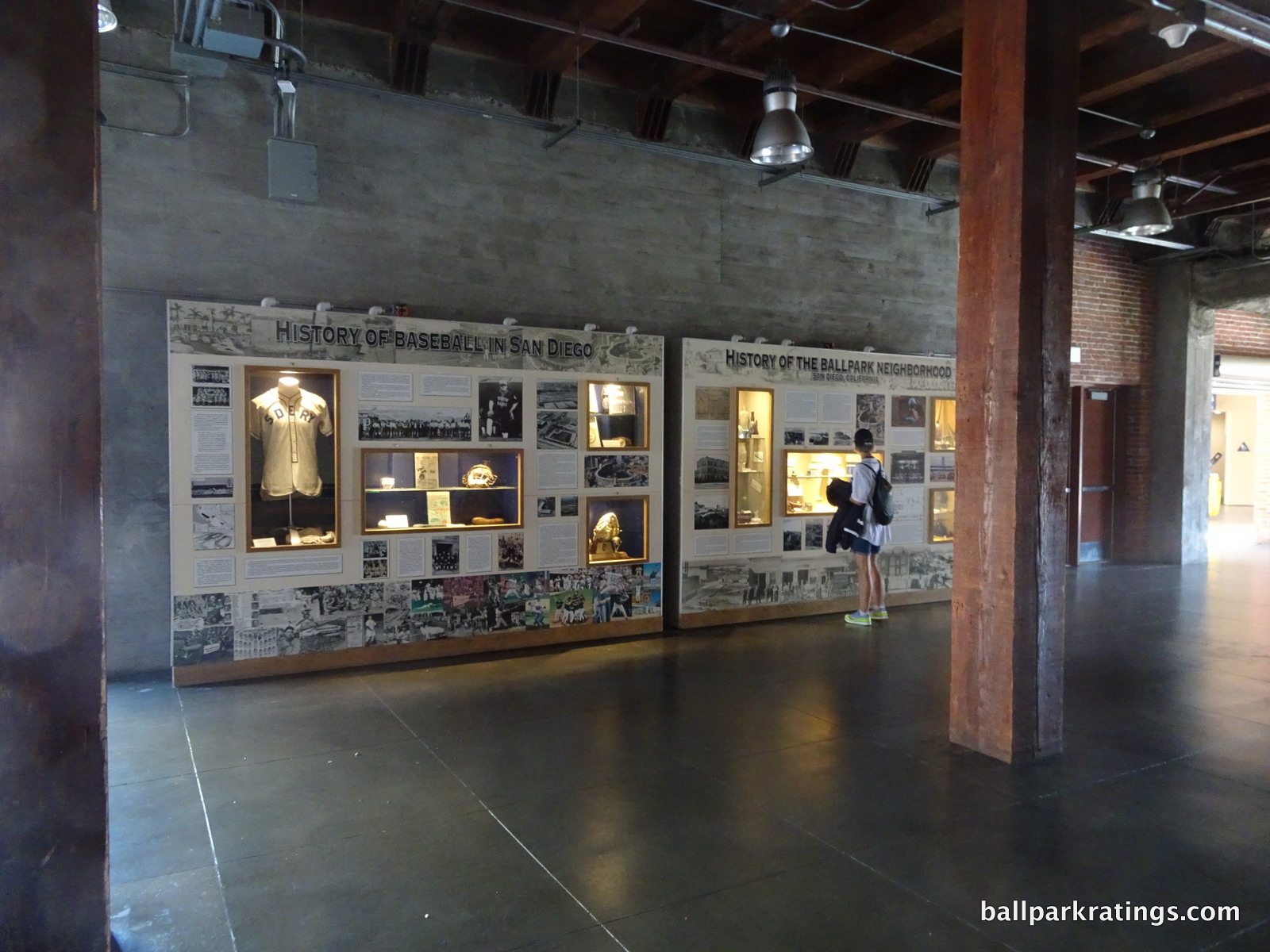
There are a few other historical references that predate the new Museum and Hall of Fame. Padres’ retired numbers are prominently showcased outside the home plate plaza by the waterfall. There is a “history of baseball in San Diego” exhibition located by the Western Metal Supply Co. building as fans transition from the main concourse to the outfield concourse down the left field line. Also note the very cool “history of the ballpark neighborhood” display. Like the museum, I think these features were added at some point after the ballpark opened.
Finally, the Padres feature a tribute to San Diego’s naval connections through the USS Midway exhibition on the outfield concourse in right field. It features a model of the aircraft carrier. Beyond the glassed-in model, there is a wall honoring Major League Baseball players who served their country.
I find this to be an effective vehicle for connecting San Diego’s history with that of baseball and the Padres. These features, coupled with the fantastic new museum, give Petco Park high marks in this category.
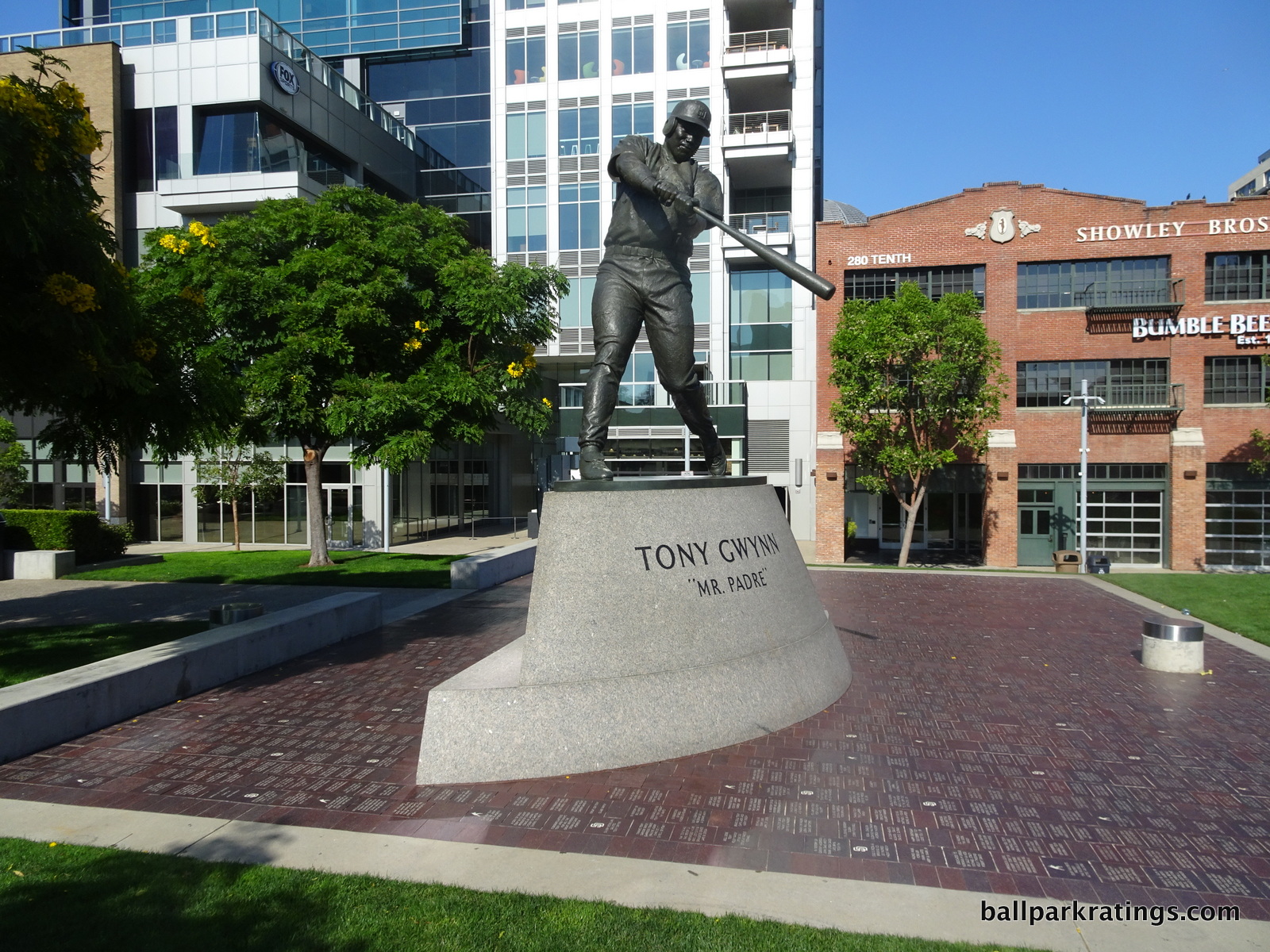
Score: 5/5
Entertainment/Kids Activities/Other Amenities
I actually didn’t expect Petco Park to get a perfect score in this category, but it excels in certain non-traditional and intangible forms of miscellaneous entertainment.
The Padres don’t have any sort of extensive “kids clubhouse” like in Cleveland, or any over-the-features like Atlanta’s zipline, Detroit’s Ferris Wheel, or Kansas City’s putt-putt golf course, but there is plenty to do here besides drink, eat, enjoy history, or watch a baseball game.
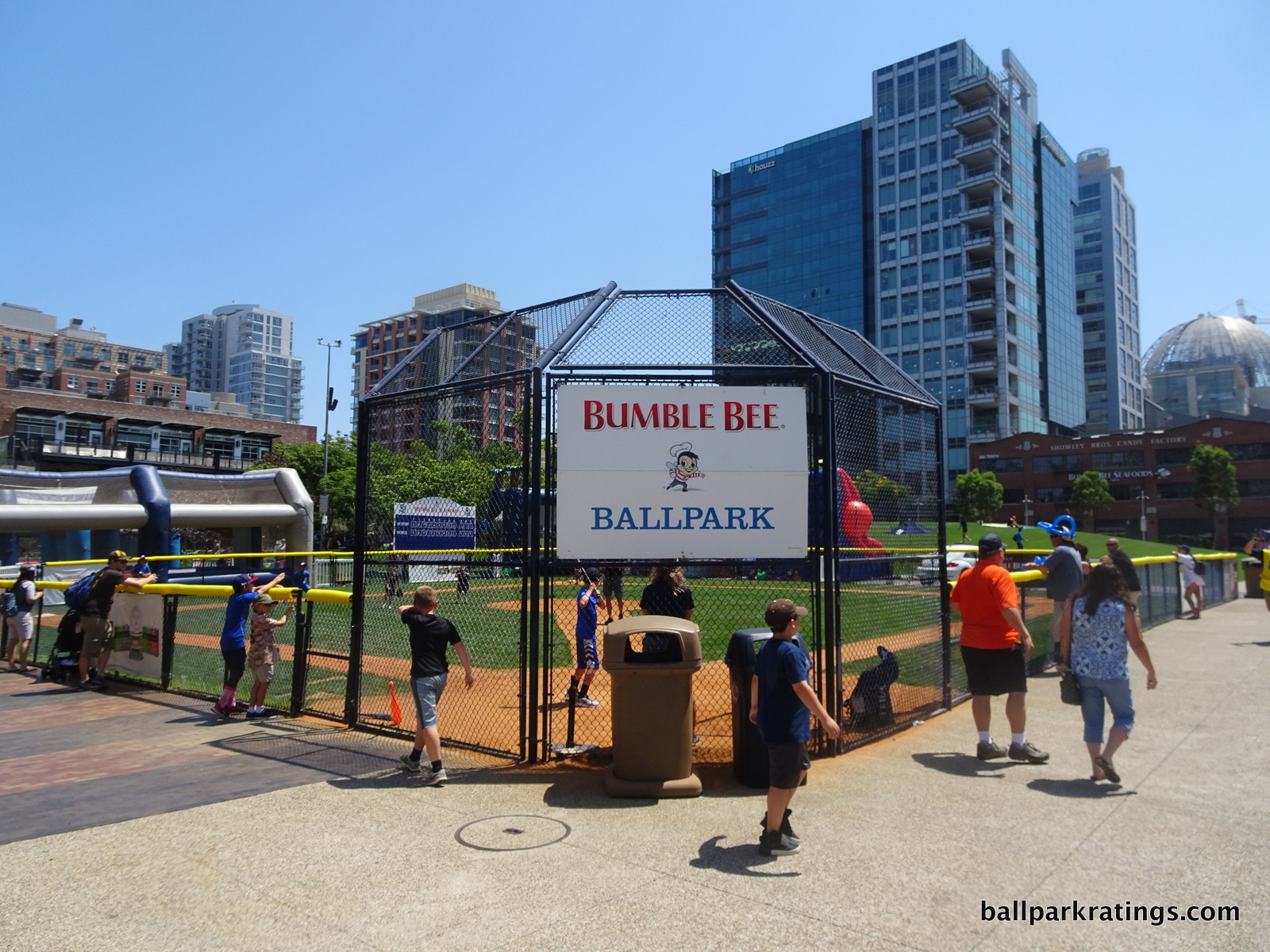
In this category, Petco Park is most well known for its mini-baseball field. Known as “Bumble Bee Ballpark,” Petco Park’s wiffle ball field is well located and expansive. Other parks have similar mini-baseball fields for kids, but I think this is the best one.
“The Beach” has been wisely relocated to the outfield concourse from the right-center field wall. Widely derided as a gimmick in the park’s early years, it’s just a sandbox for little kids. This is a minor amenity, not something that should be part of the interior aesthetic design, so I’m glad they repositioned it to a less prominent place.
The sheer size of the “Park in the Park” is one of the most impressive factors of Petco Park. It’s bigger than you expect. Kids and families can run around and really do anything they please in this expansive space, from playing catch to lying down on a towel and playing cards.
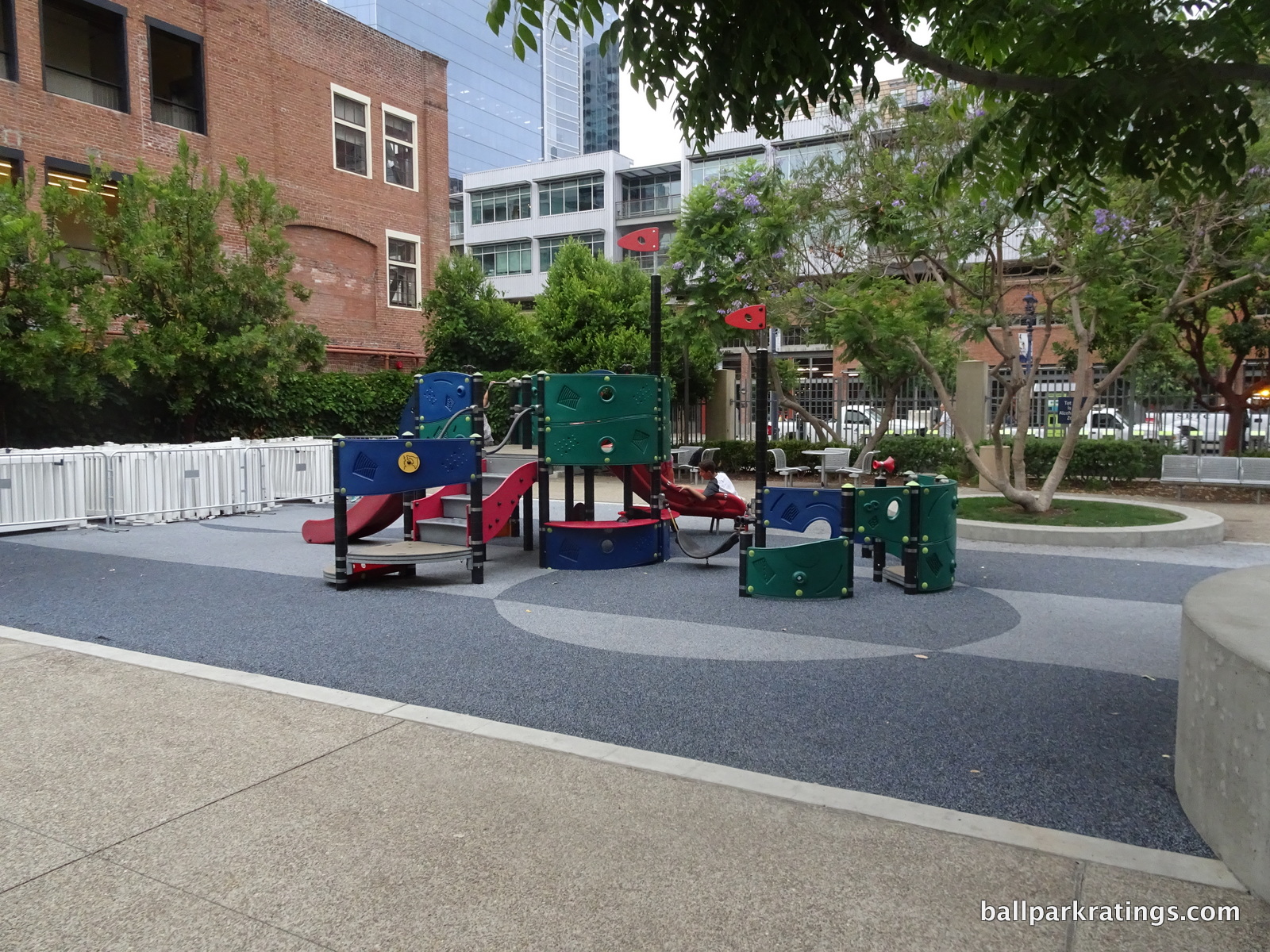
Take time to walk around the Park in the Park and appreciate its enormity compared to other such spaces in Major League Baseball. Like an actual park, you can spend significant time actually “taking a walk.” The hill in the middle of the park is positioned as such for watching the game, but I forgot there was much more space on the other side of the hill too. In this area, there is an obligatory kids’ playground and jungle gym.
Petco Park has a concert stage behind the center field batters’ eye. Speed pitch is located on the outfield concourse in right field. On Sundays, the Padres have bounce castles and other games in the Park in the Park.
Finally, the Padres seem to have plenty for adults to do as well. As previously mentioned, the Budweiser Beer Loft has pool tables, foosball, and shuffleboard.
Score: 3/3
Total: 23.5/25
Atmosphere, Vibe, & Policies
Atmosphere/Fan Support:
If baseball fans had to pick one MLB team that is most forgettable, the Padres might be at the top of the list. They haven’t been extremely bad as to get negative attention like the Houston Astros in the early 2010s, but they also have the third longest postseason drought in baseball. They’ve been mediocre for basically the entire century. Couple this with an isolated West Coast location, and you get the amount of national attention the Padres (or Petco Park!) have received.
So, we don’t really think about the Padres fans. For all of the mediocrity, the attendance has been remarkably stable.

For most years this decade, they have been right at an average of 26,000 per game, peaking at 30,000 in 2015. This isn’t bad compared to the attendance numbers for other teams perennially in the cellar. Most clubs dip below 25,000-20,000 during long steaks of losing, but this is probably a function of the Padres never being outright terrible.
The Padres’ attendance mirrors the Padres’ performance on the field: consistently pedestrian.
Padres’ fans are generally painted as your typical fair weather, trendy West Coast crowd. I’ve generally found them to be more passionate and boisterous than one might think, more similar to Los Angeles than Seattle.
Petco Park never really experienced that attendance boom in the early years like other parks. They peaked at 37,000 per game in their opening year, and have been consistently average to below average since then. Overall, it does seem that Padres’ fans are a bit more inelastic to bad team quality compared to other cities that experience years of averaging below 25,000 per game, perhaps because of the climate and the quality of the ballpark. Of course, it could just be loyalty!
Score: 3.5/5
Ballpark Policies/Customer Service:
Like most post-1991 ballparks, fans are allowed to go down to the lower bowl to get autographs before the game. The policies are similar to most teams in baseball, which is the requisite for getting a 2/2 here.
Experiences with ballpark ushers are too anecdotal to evaluate, so I usually avoid doing that. If I somehow had three straight games of bad customer service, I still wouldn’t deduct from the park’s grade. But I will say I consistently experienced some of the best ushers in baseball at Petco Park.
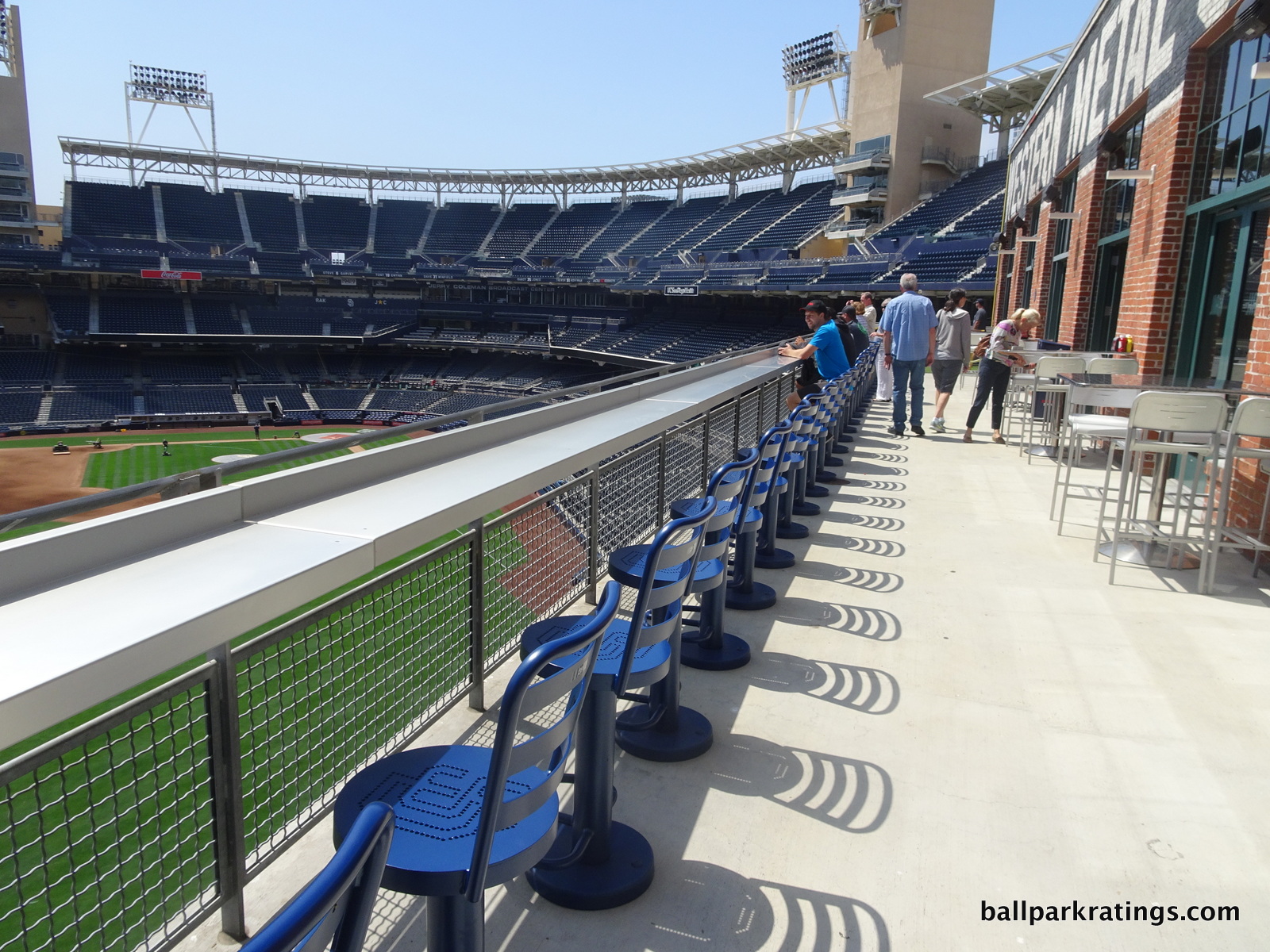
One thing I noticed: the entire ballpark staff is knowledgeable about areas of the park that may not involve their job. For example, at most other parks, if you ask an usher about ballpark food, they may say a “different company” runs the concessions and tell you to go ask them. A bartender may be clueless about seating policies. All of this is understandable, but everyone who works at Petco Park seems to be very knowledgeable about all areas of the park.
For example, I asked a bartender an obscure question about entry policies, and she knew the answer and proactively made sure to verify that the answer was correct.
Anyway, I typically don’t get into staff anecdotes (because I could still easily be way off), but I have always been very impressed with the team at Petco Park.
Score: 2/2
Bonus:
Regardless of subjective opinions, Petco Park is arguably the only post-1991 ballpark that constitutes “capital A” architecture, as most of the beautiful aesthetic design was done by Antoine Predock, characterized by the gold sandstone exterior and especially the innovative garden-like concourse design +2
For presenting the boldest, most innovative design concepts of all the post-1991 ballparks +1
For having the best local scene in baseball with the Gaslamp District +1
For having the best concessions in baseball +1
For having the best system of restaurants/bars/social spaces in baseball, most of which are now open to all fans. This so outdoes every other ballpark it may warrant two points, but Petco Park is beginning to lap the field. +1
For arguably having the best sightlines in baseball, with the most cantilevered upper decks and excellent seating geometry +1
For the Park in the Park and the successful integration and adaptive reuse of the Western Metal Supply Co. building. Both are worth half a point because they are fairly well done but have flaws that I pointed out earlier. +1
Score: 8
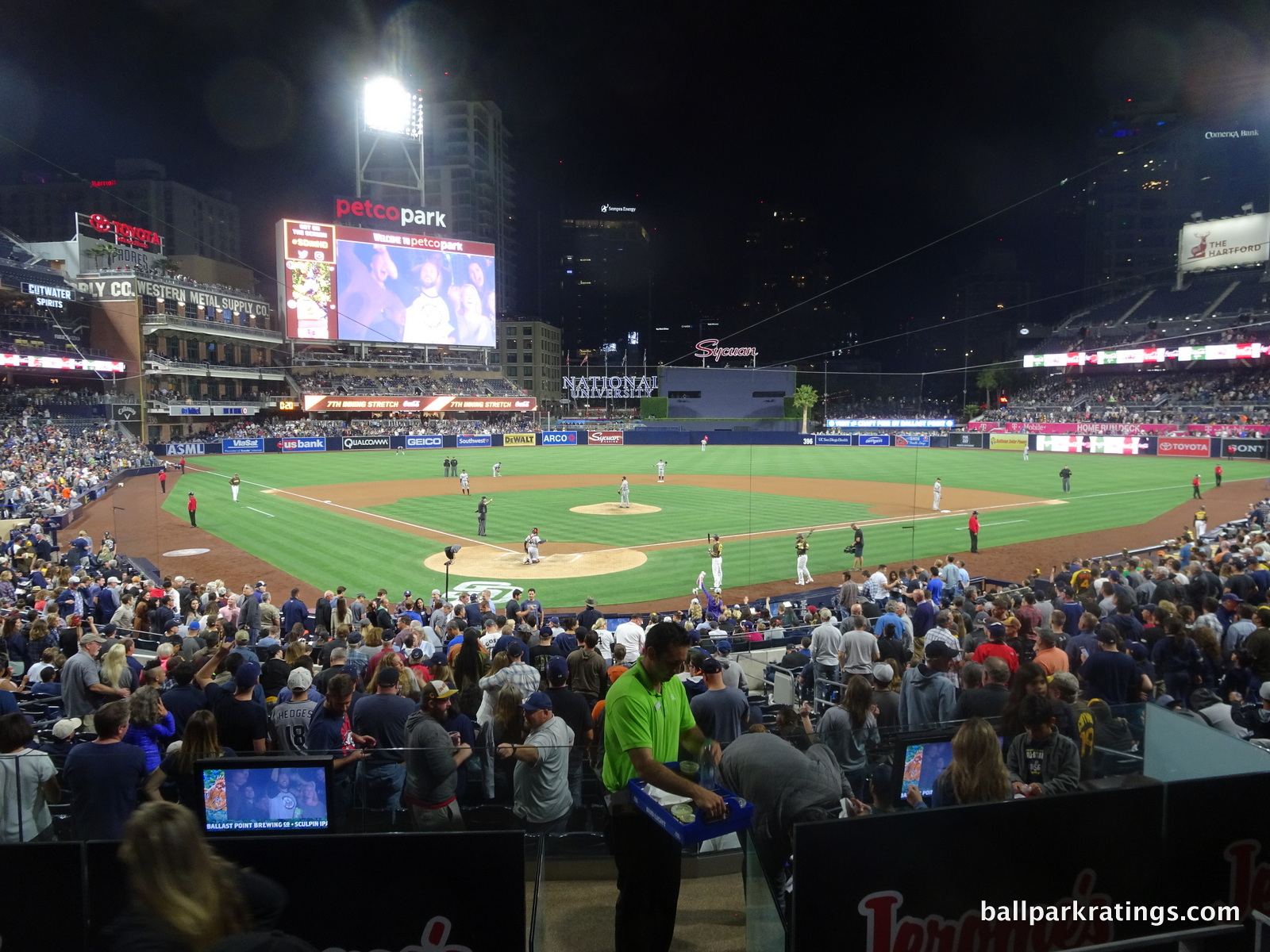
Total: 13.5
Conclusion
For all of its raw appeal, Petco Park looked unfinished when it opened in 2004.
The Padres had a rather barren outfield scene, not much development beyond the outfield scene, a notably Spartan batters’ eye that needed to be spruced up, absurdly cavernous dimensions that needed to be altered, questionable concessions criticized by the local press, a distinct lack of team history featured inside the ballpark, and a much maligned gimmicky “beach” sandbox beyond right-center field.
All of these issues have been rectified, transforming a great park into the best ballpark in baseball.
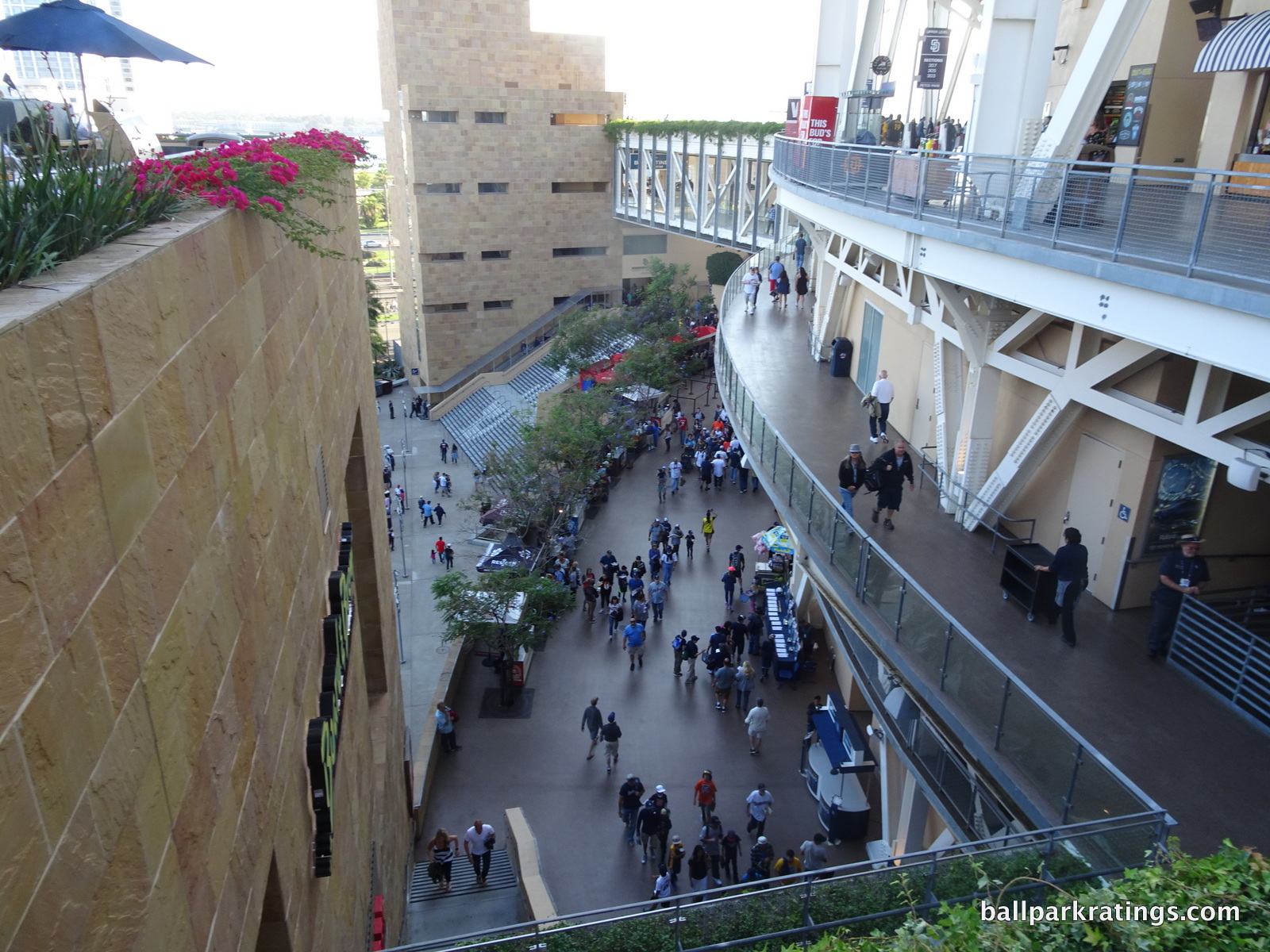
While Camden Yards always gets a mention, there seems to be a wide consensus on what the two best post-1991 ballparks are: PNC Park in Pittsburgh and AT&T Park in San Francisco. Not counting Wrigley Field or Fenway Park, you’re extremely likely to see one of those two parks in the number one spot of any “ballpark ranking.”
While both parks are actually even more impressive than what pictures indicate, this is largely just because of the views. Most ballpark blogs and national publications are mostly concerned with a ballpark’s aesthetic scene, and most people just look at the pictures.
While the headline of my AT&T Park (ranked 4th) review is “More Than a Ballpark by The Bay” because of its great amenities, some severe functional flaws hamper the overall ballpark experience. The concourses are almost irredeemably narrow, and there are some sightline issues down the left field line.
PNC Park (ranked 2nd) is far and above all other ballparks in aesthetics, in my opinion, but generally lacks the amenities of the best ballparks in baseball.
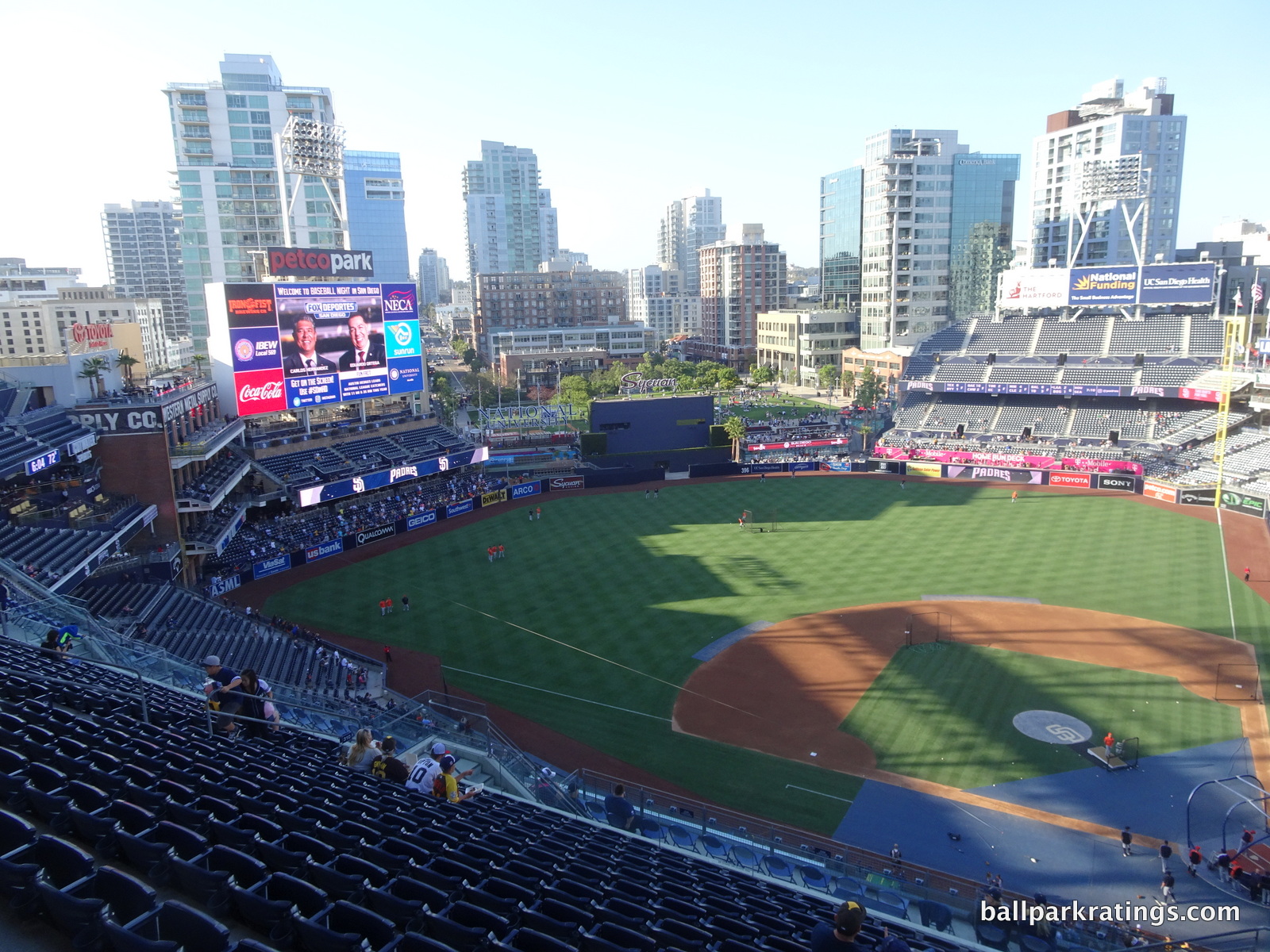
As I do, you can argue these two parks eclipse Petco Park in sheer aesthetic appeal, but unlike those two, Petco Park doesn’t suffer from any of these objective problems. While not matching those two in aesthetics, Petco Park is great in that department, while almost being objectively flawless in all others.
Parks in Detroit (ranked 3rd) and Minneapolis (ranked 5th) are in the conversation, but they also don’t come close to matching both the superlatives and well roundedness of Petco Park. There isn’t one iota of doubt in my mind that Petco is the best ballpark in baseball.
San Diego has the best ballpark to watch an actual baseball game (sightlines) and the best ballpark to not watch a baseball game (amenities). Petco Park has the best local scene, the best concessions, the best restaurants, bars, and social spaces, the most attractive concourses, and is one of the few parks to possess actual architectural merits on the outside.
It isn’t close: Petco Park is baseball’s grandest cathedral.
FINAL SCORE: 97
RANKING: #1/30
Summary
TL;DR? Here’s the long-form piece in a nutshell:
Even considering the “landmark ballparks” in Chicago and Boston, Petco Park is comfortably my favorite MLB venue.
PNC in Pittsburgh and Oracle in San Francisco may get more attention by virtue of their postcard views, but San Diego’s pad has sufficiently beautiful outfield visuals, while being filled with superlatives in all other categories and mostly lacking major flaws.
Petco Park’s exterior architecture is truly outstanding. The adaptive reuse of the left field warehouse and innovative concourse design exposed to the sky are brilliant. Aggressive cantilevers push the upper levels closer to the action than just about any MLB park, and the seating geometry is perfect.
The bevy of fan-friendly amenities—think baseball’s #1 concession stand food and craft beer, the numerous destination eateries, bars, and social spaces throughout the concourses, the Padres Museum, the fun in The Park in the Park, etc.—are cumulatively tied for #1 in baseball.
Combine all of that with its location in perhaps baseball’s premier neighborhood, the Gaslamp Quarter, and Petco Park almost hits the trifecta of perfection: 1) best ballpark to watch the game (sightlines), 2) best ballpark to not watch the game (amenities), and 3) top-5 ballpark for aesthetics.
It all adds up to the finest fan experience in the Majors by a relatively significant margin in my book.
Defining Features
Western Metal Supply Co. Building (left field warehouse)
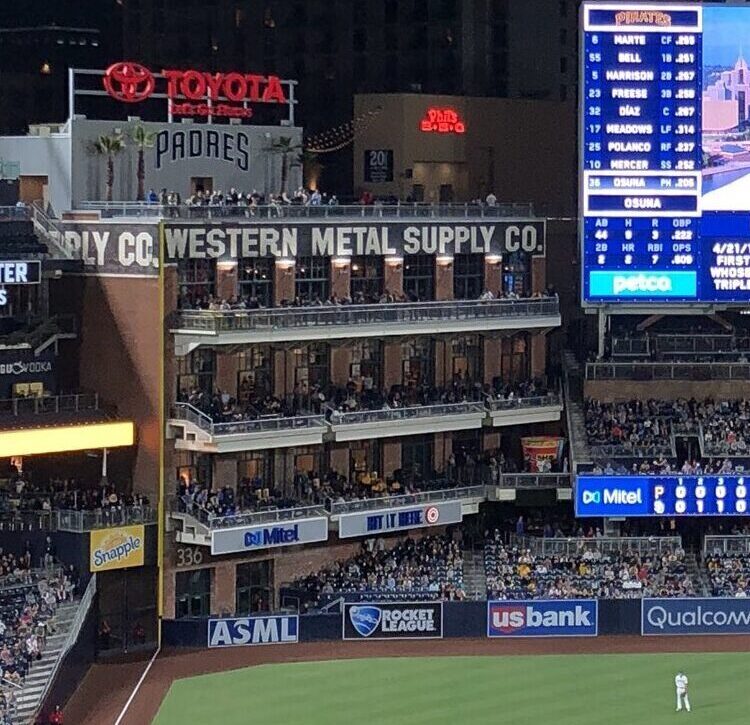
"Park in the Park" (aka Gallagher Square)

Biggest Hit
"Park in the Park" (aka Gallagher Square)
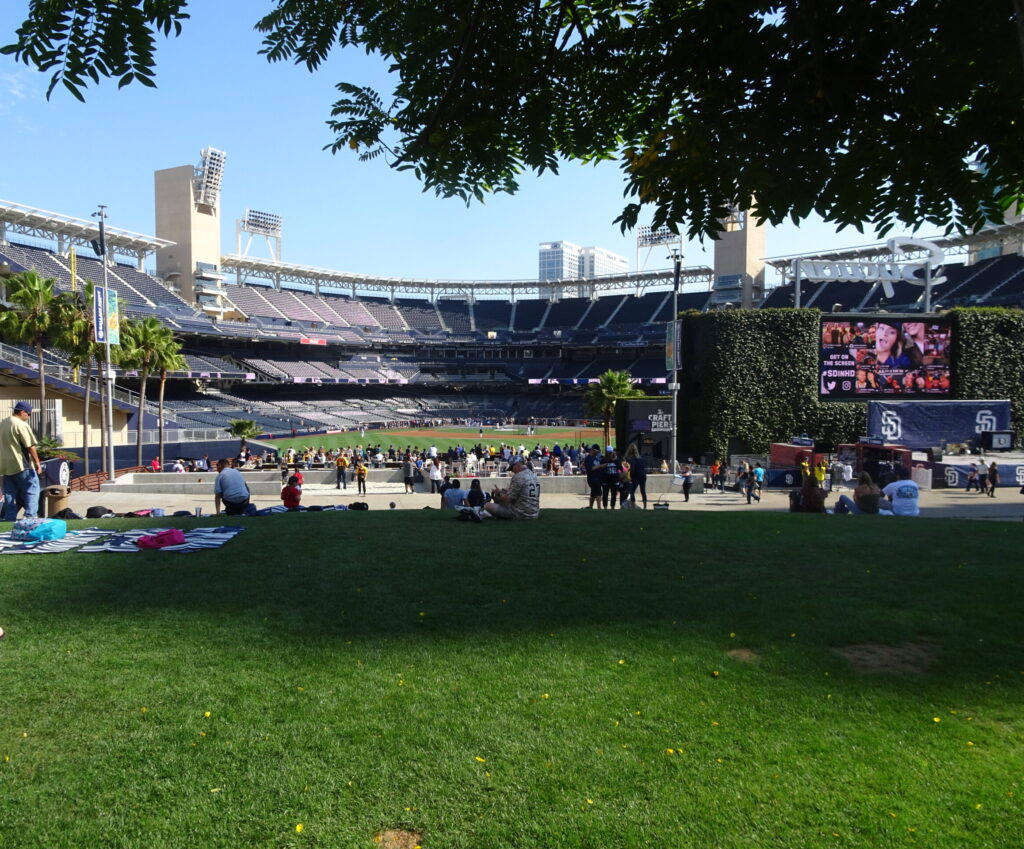
Petco Park is filled with superlatives, so it’s hard to pick one best feature. But since it’s always been such a conceptually innovative place, I’ll go with Petco’s best concept of all: The Park in the Park. Envisioned as a green space in an urban village, the Park in the Park is not some cleverly branded piece of grass, but rather an actual park. Take time to walk around the Park in the Park and appreciate its enormity compared to other such spaces in Major League Baseball. The hill in the middle of the park is positioned for watching the game, but the park includes a kids’ wiffle ball field, a playground, a concert stage, a Tony Gwynn statue, and other frills. It’s only accessible to ticketed fans on game days, but it’s open to the public at all other times.
Biggest Miss
Navigating the Disjointed Concourses
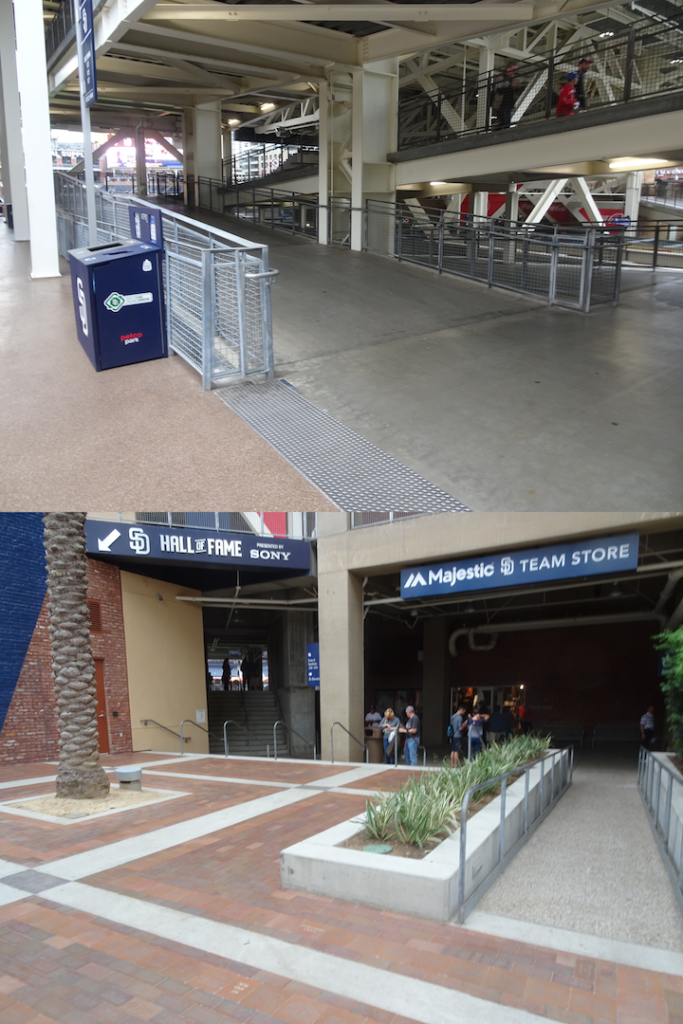
I’m always hoping my memories are exaggerated each time I return to Petco Park, but exploring the concourses is genuinely cumbersome. Along the main concourse, especially when you transition from the infield to the outfield, there are so many vertical changes in elevation and horizontal maze-like discontinuities you will literally get lost. It doesn’t even really qualify as a 360-degree system. There is no ease of circulation here, as moving from the outfield to the infield down the right field line even requires ramps . At every turn, you’ll encounter some encumbrance. Petco Park has baseball’s best amenities, but some may not have the patience to find them.
Other Hits
The Gaslamp Quarter, MLB's Best Ballpark Neighborhood
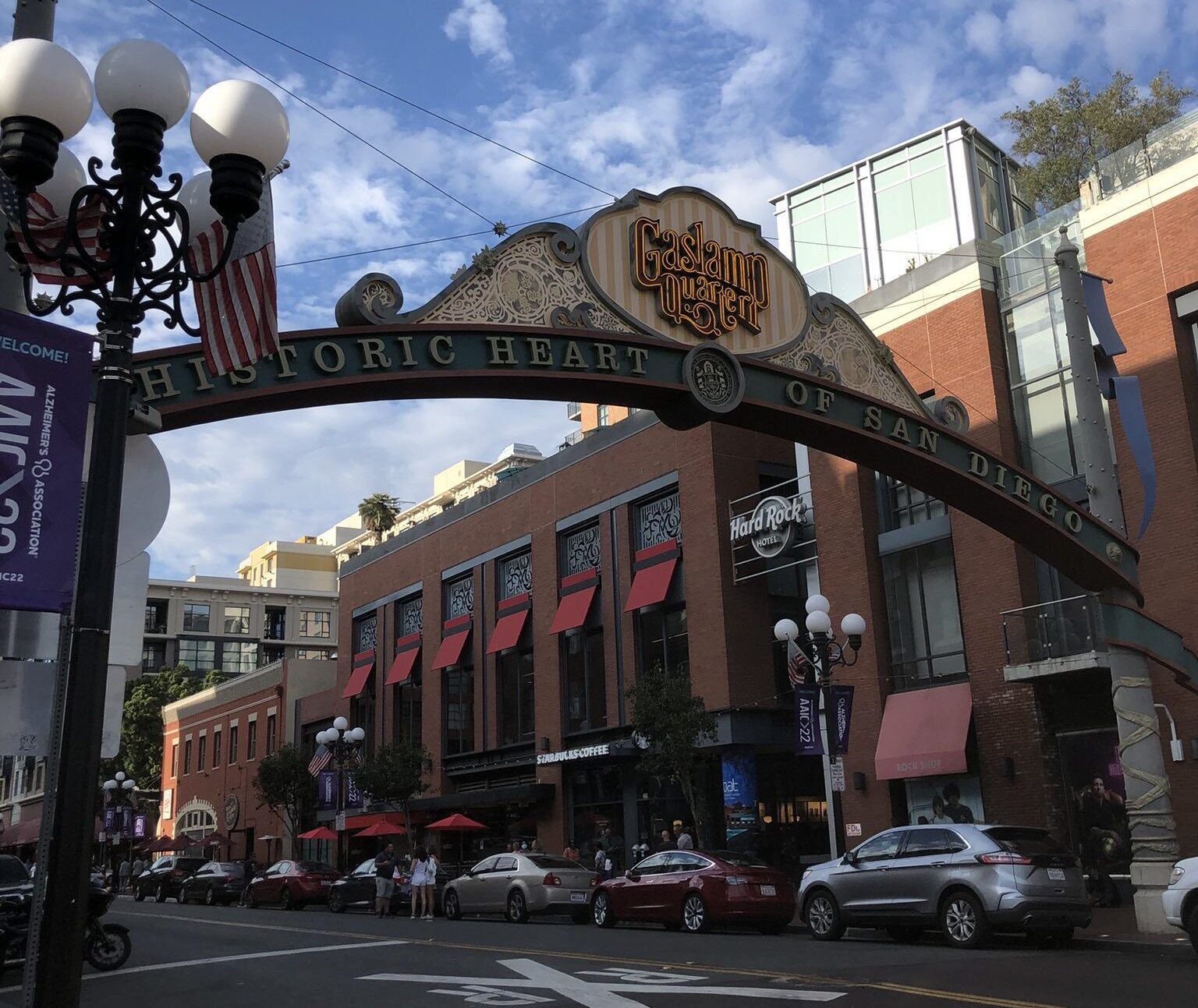
Sure, solid pre and post-game attractions surround many ballparks these days. But The Gaslamp has the highest density of quality restaurants, bars, and shops around an MLB ballpark in my book, with only Denver’s LoDo, Chicago’s Wrigleyville, and Boston’s Fenway-Kenmore even in the conversation. A true San Diego destination in its own right.
Innovative Exterior Architecture
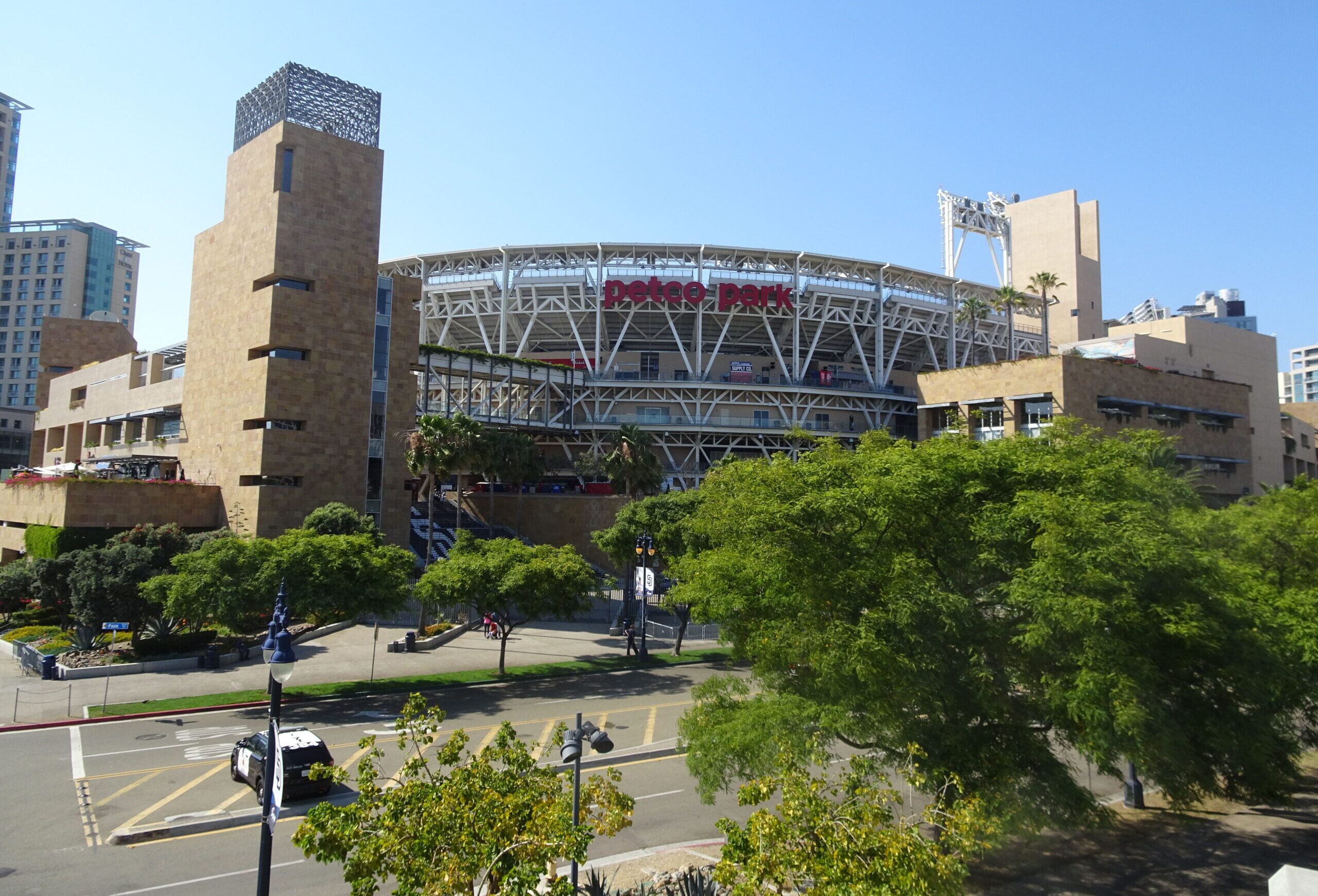
Petco Park features one of my favorite ballpark exterior designs. The sandstone and stucco evoke the cliffs of Torrey Pines in both color and texture, while the exposed white steel cultivates a nautical marine motif reminiscent of the ships in San Diego Bay. The slopes and edges of the garden buildings are reminiscent of the Mayan pyramids. Also note the plush greenery and flowers cascading down the sandstone.
Western Metal Supply Co. Building is Adaptive Reuse at its Best

Built in 1909, the Western Metal Supply Co. Building’s gorgeous red brick connects Petco Park to The Gaslamp’s past. Integrated into the ballpark’s interior, there is no foul pole in left field. The southeast corner of the building does the trick. The architects worked backwards, starting at that left field corner and building Petco Park around the warehouse. Today, the four-story warehouse houses (1) a team store on the first floor, (2-3) party suites cantilevered over the action on the second and third floors, (4) a restaurant and bar (Budweiser Beer Loft) on the fourth floor, and (5) a party deck and fast casual eatery on the rooftop.
Some of MLB's Best Skyline Views
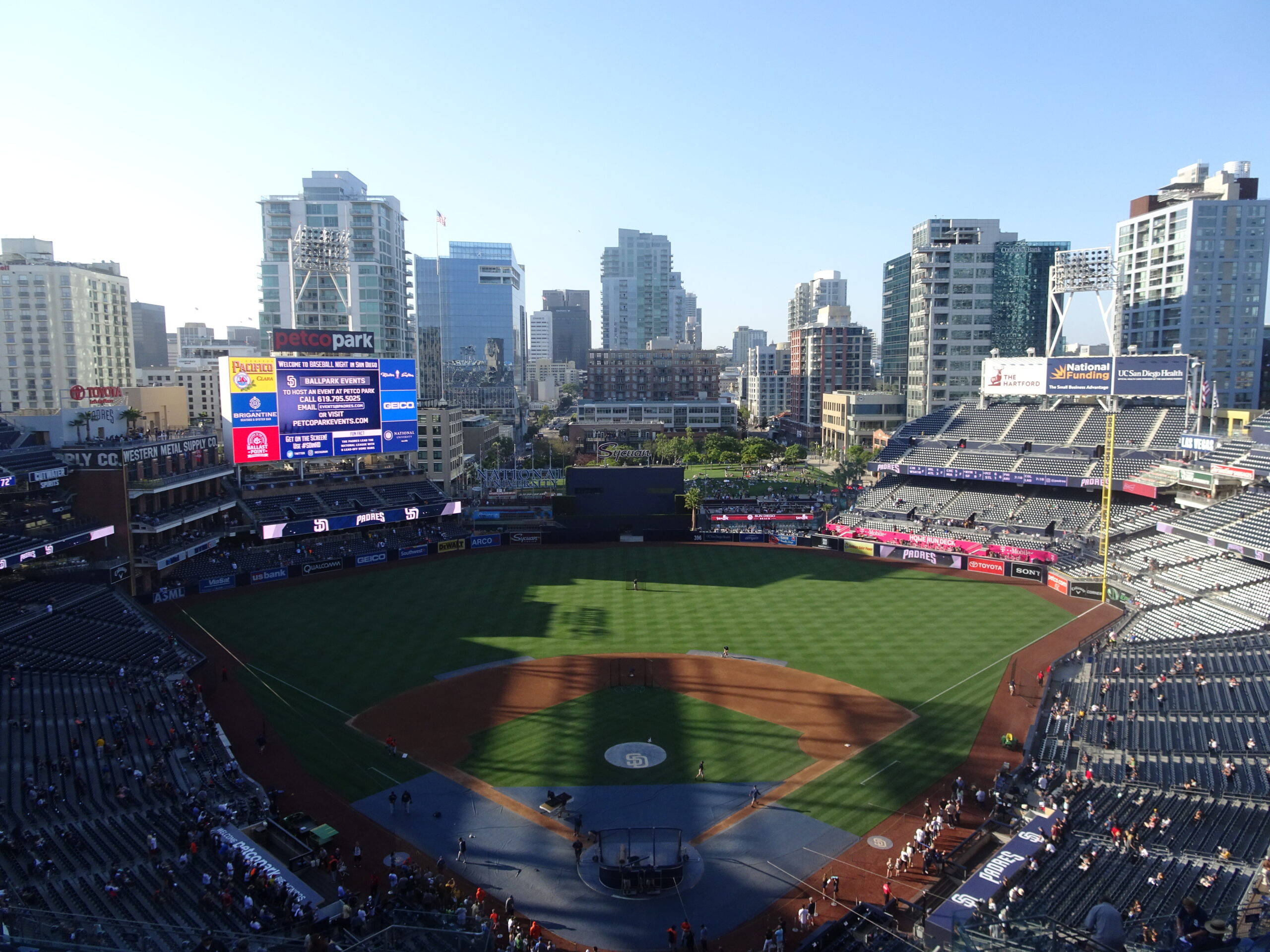
PNC Park in Pittsburgh, Busch Stadium in St. Louis, and Comerica Park in Detroit showcase baseball’s best downtown vistas, but no scene has improved as much as San Diego’s. While not technically sporting views of Downtown proper, the high rises sprouting out from the plots in between The Gaslamp and East Village make for an inviting backdrop.
MLB's Best Ballpark Food
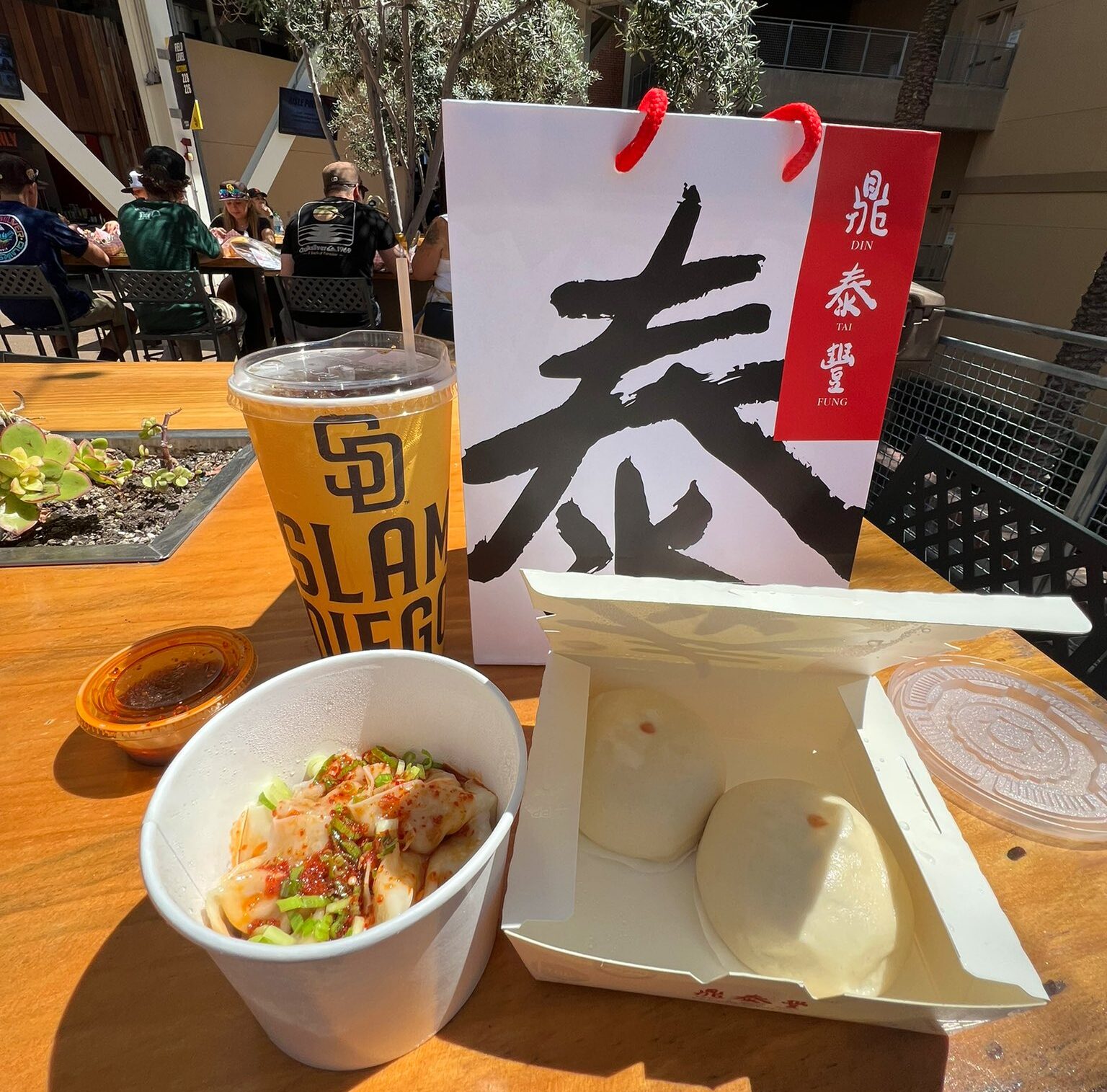
With a selection of food that is high quality, varied, and local, Petco Park represents the pinnacle of stadium cuisine in Major League Baseball. The best parks serve every conceivable cuisine from hamburgers and pizza to mahi-mahi and poke, and Petco does just that and more, but with nearly all concession stands run by local eateries. I could count the number of generically branded concession stands on one hand. Moreover, the varied food isn’t merely local, but quality local, with many of the best restaurants in San Diego setting up shop at Petco.
Top-3 Craft Beer Ballpark
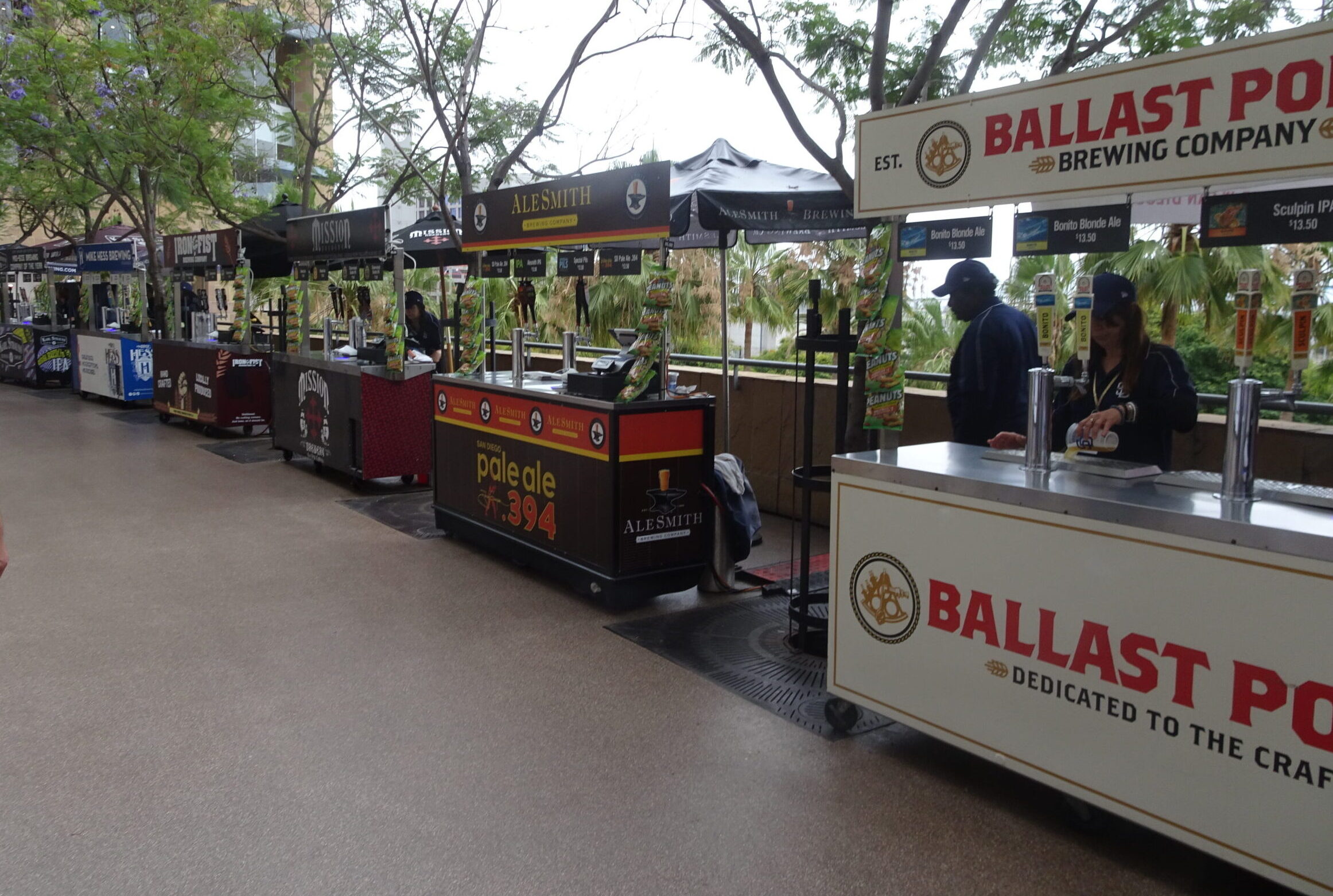
There’s stiff competition from Seattle, San Francisco, Chicago (Sox), and a few others, but Petco Park may have baseball’s best quality and selection of craft beer. It’s all local (AleSmith Brewing Company, Pizza Port Brewing Company, etc.) and of famous San Diego beer quality. The distribution around the park is excellent, with rows of craft beer kiosks peppered around the main concourse. You have the Craft Pier in the outfield and the bars on the mezzanine accessible to all fans. Finally, there’s beer made specific to the ballpark: .394 Pale Ale — named for Tony Gwynn’s 1994 batting average.
Outstanding series of sit-down restaurants, destination bars, and social spaces accessible to all fans, #1 in this cumulative category
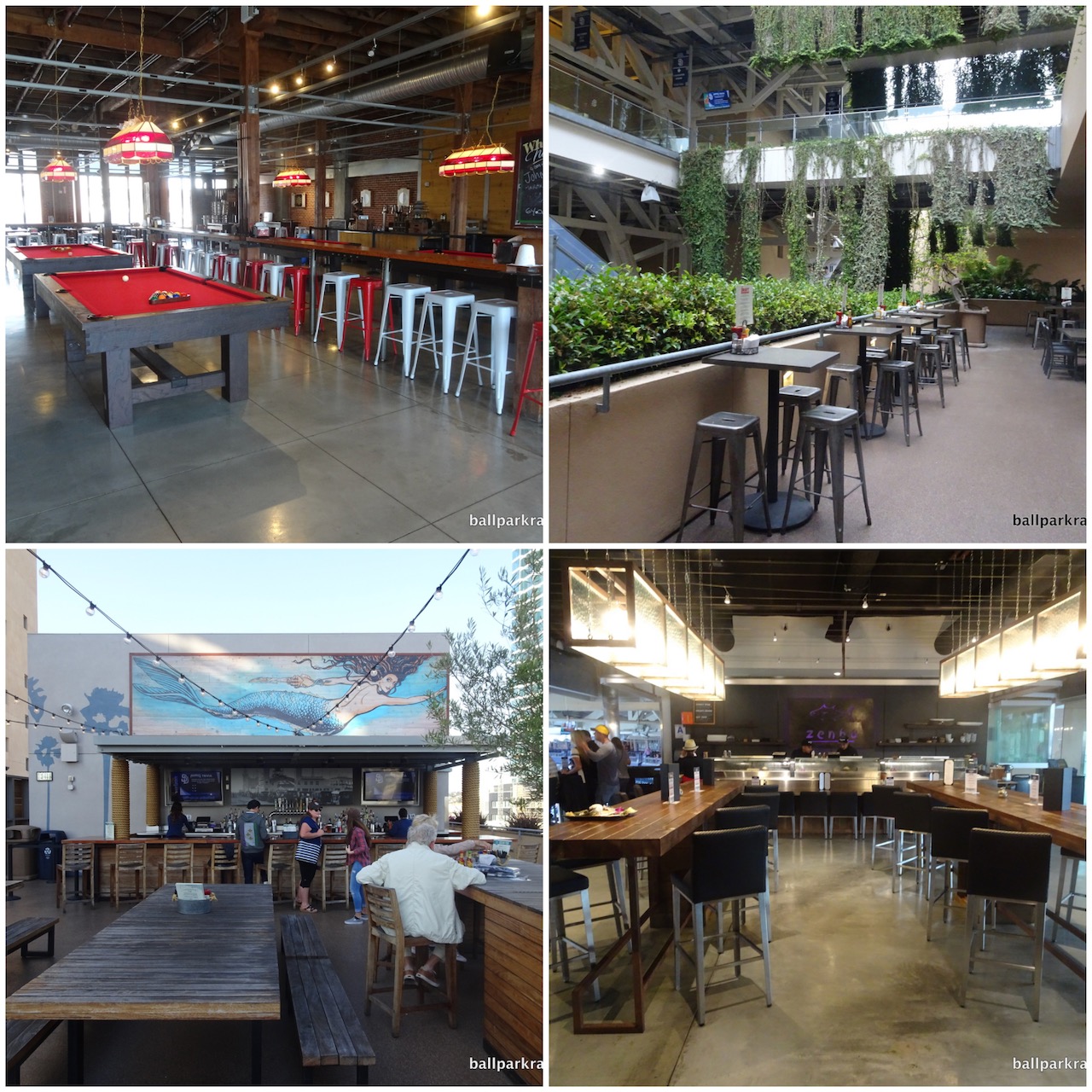
In terms of places to hang out before or during the game, Petco Park has it all. And it’s all accessible to any fan with a ticket. A full service restaurant behind home plate (Top Right). The Craft Pier in the outfield. A wine bar on the main concourse. The mercado overlooking the bay. A sushi bar (Bottom Right), a Tony Gwynn-monikered club, and a bistro on the mezzanine. Another full service restaurant in the warehouse (Top Left). Yet another full service bar and eatery in the upper deck (Bottom Left). And another fast casual concept on top of the warehouse. “Social Spaces” are all the rage in sports venues, but nothing tops Petco Park in terms of offering something for everyone.
The Craft Pier
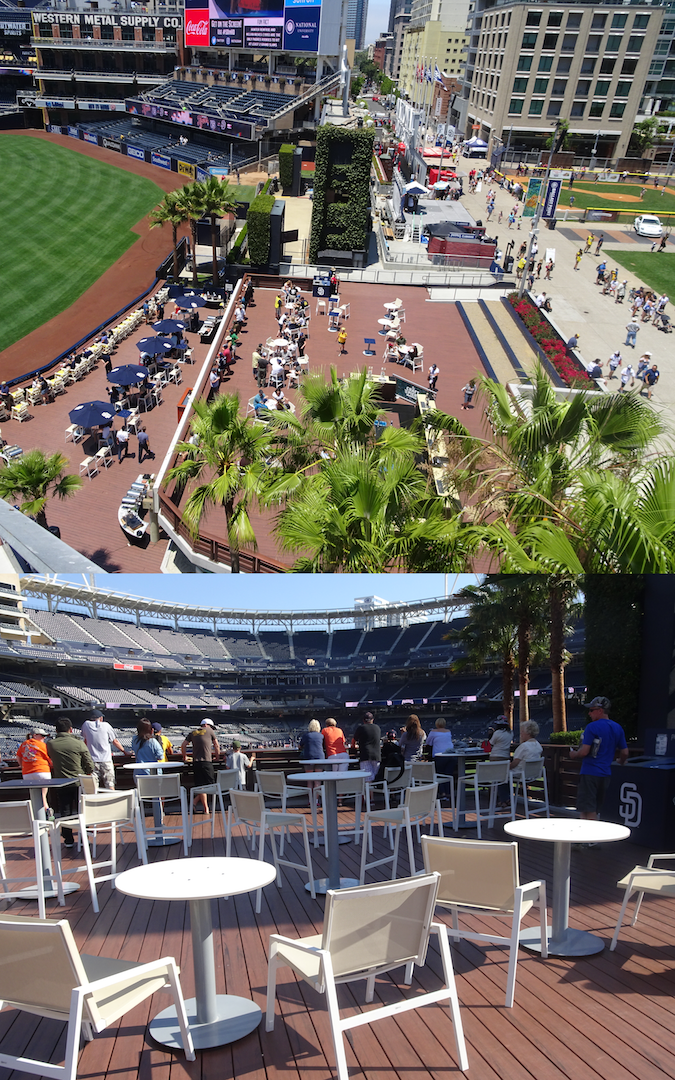
My favorite spot is the Craft Pier, which is a terrific perch to enjoy some of San Diego’s best suds and watch batting practice. Beer only here! The space itself is immaculate, with a drink rail overlooking the field, beach chair and table seating, and a sleek teak deck.
MLB's Most Aesthetically Pleasing Ballpark Concourses
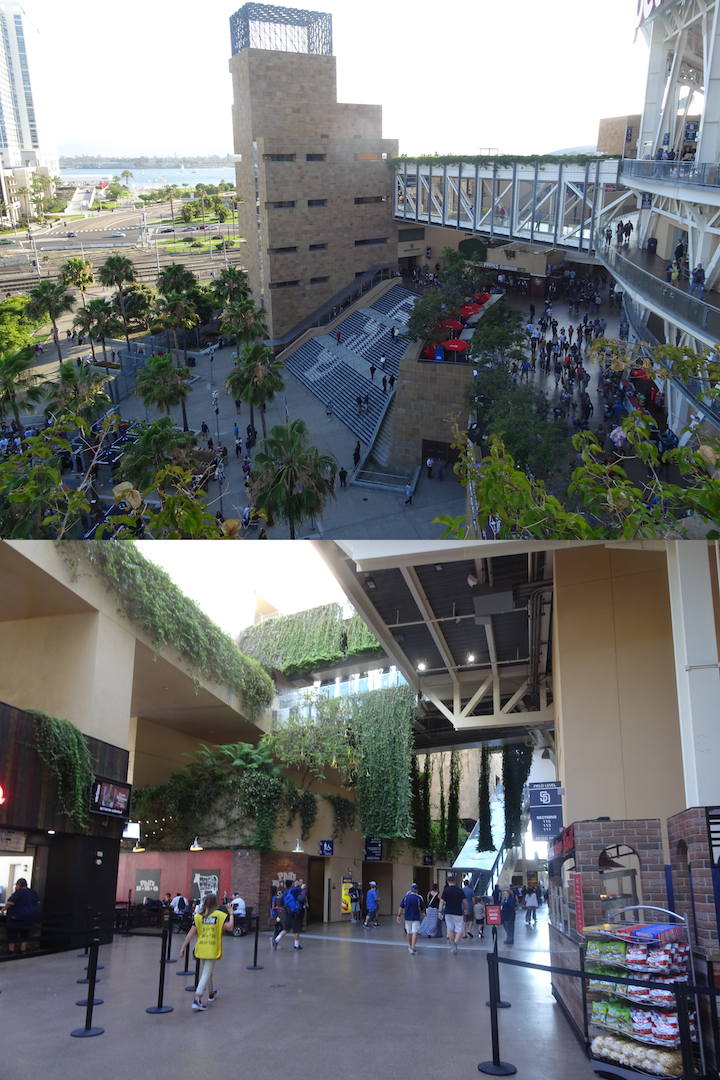
Adorned with hanging ivy and cascading Bougainville and jasmine plants, Petco Park’s concourses are by far the most beautiful in baseball. Plus, they sport views of the San Diego Bay.
Superior Field Proximity From Upper Levels Due to Aggressive Cantilevers and No Separate Suite Level
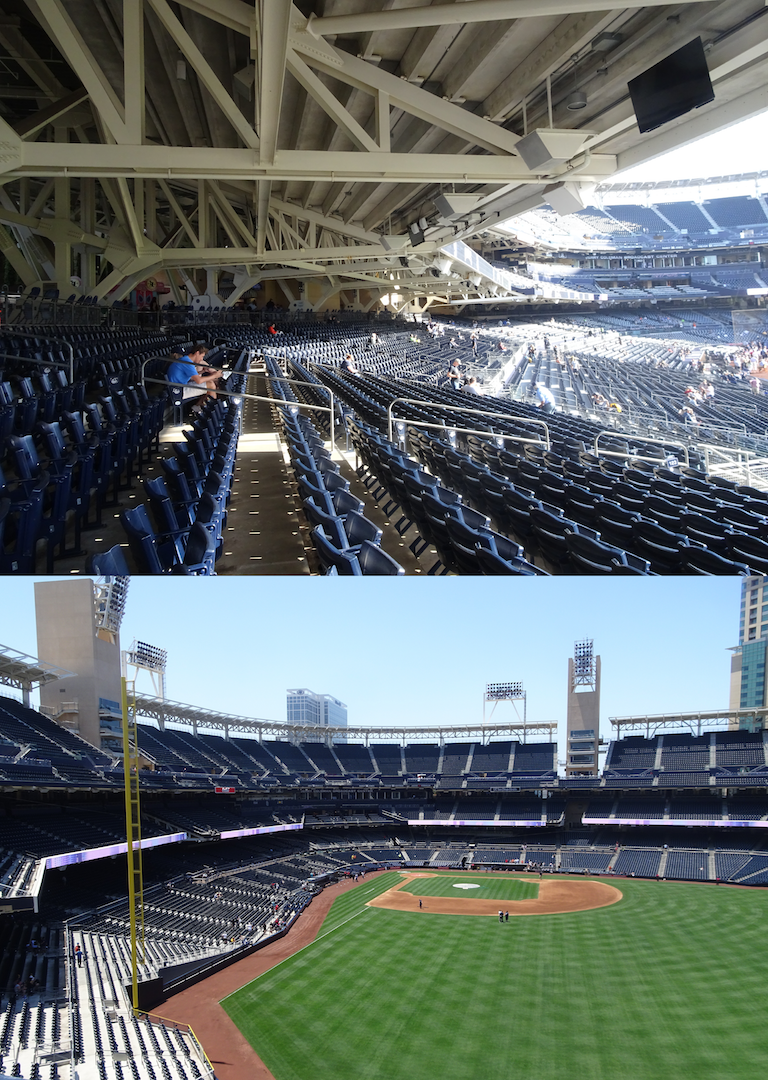
Petco Park’s upper levels are very close to the action for a post-1990 ballpark. Compare here. Baseball’s most aggressive cantilevers thrust the mezzanine around 15 rows above the lower bowl seating, while the upper deck extends similarly above the mezzanine. So, you feel closer to the action horizontally here compared to Petco’s contemporaries. Moreover, there’s no separate suite level ring in between the mezzanine and the upper deck like at other parks of the era, so you’re not prohibitively high in the nosebleeds either. At least in terms of the fundamental decking structures, Petco Park nailed the sightlines.
Excellent Seating Geometry

In addition, Petco Park’s seats are aggressively angled toward the infield. The OG retro parks in Baltimore and Cleveland botched this, and surprisingly, not every successor got it right, either. Petco, like only a handful of others, nails the seating geometry too.
Padres Museum and Hall of Fame

Before the 2016 All-Star Game, the Padres added a museum and hall of fame behind the left field stands. It’s one of the more modest museums in MLB, but hey, just having a museum is impressive, especially for the Padres! The exhibit honors Padres in Cooperstown and the greatest Padres in team history with assorted memorabilia, video displays, and plaques.
Wiffle Ball Field in the Park in the Park
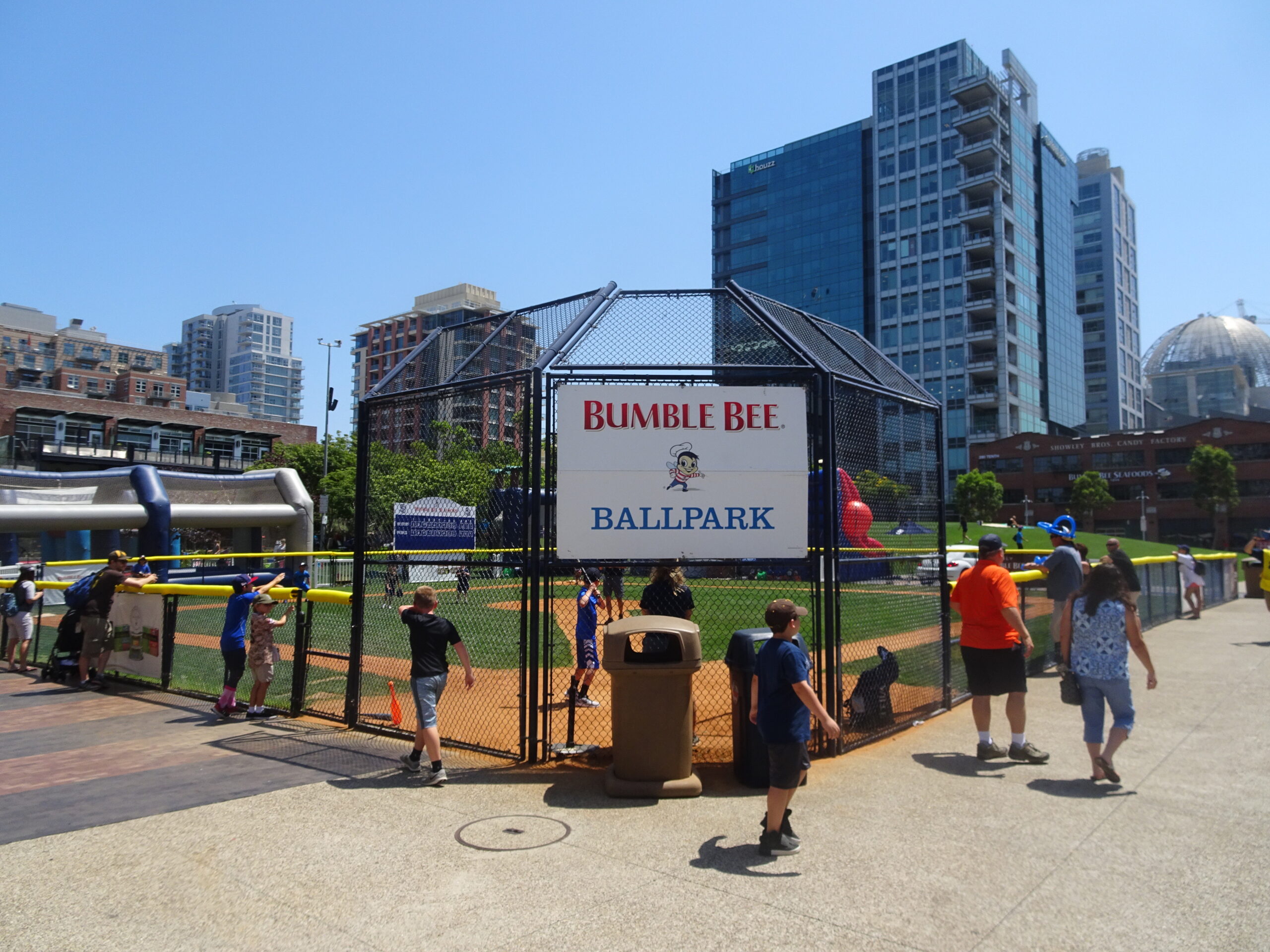
Petco Park is one of 10 MLB ballparks with wiffle ball fields for the kids – something I hadn’t thought to count until now ? – but some are so small to stretch the definition “field.” Petco Park’s version is legit, an expansive space to play within the Park in the Park.
Opening the Toyota Terrace Spaces to All Ticketed Fans
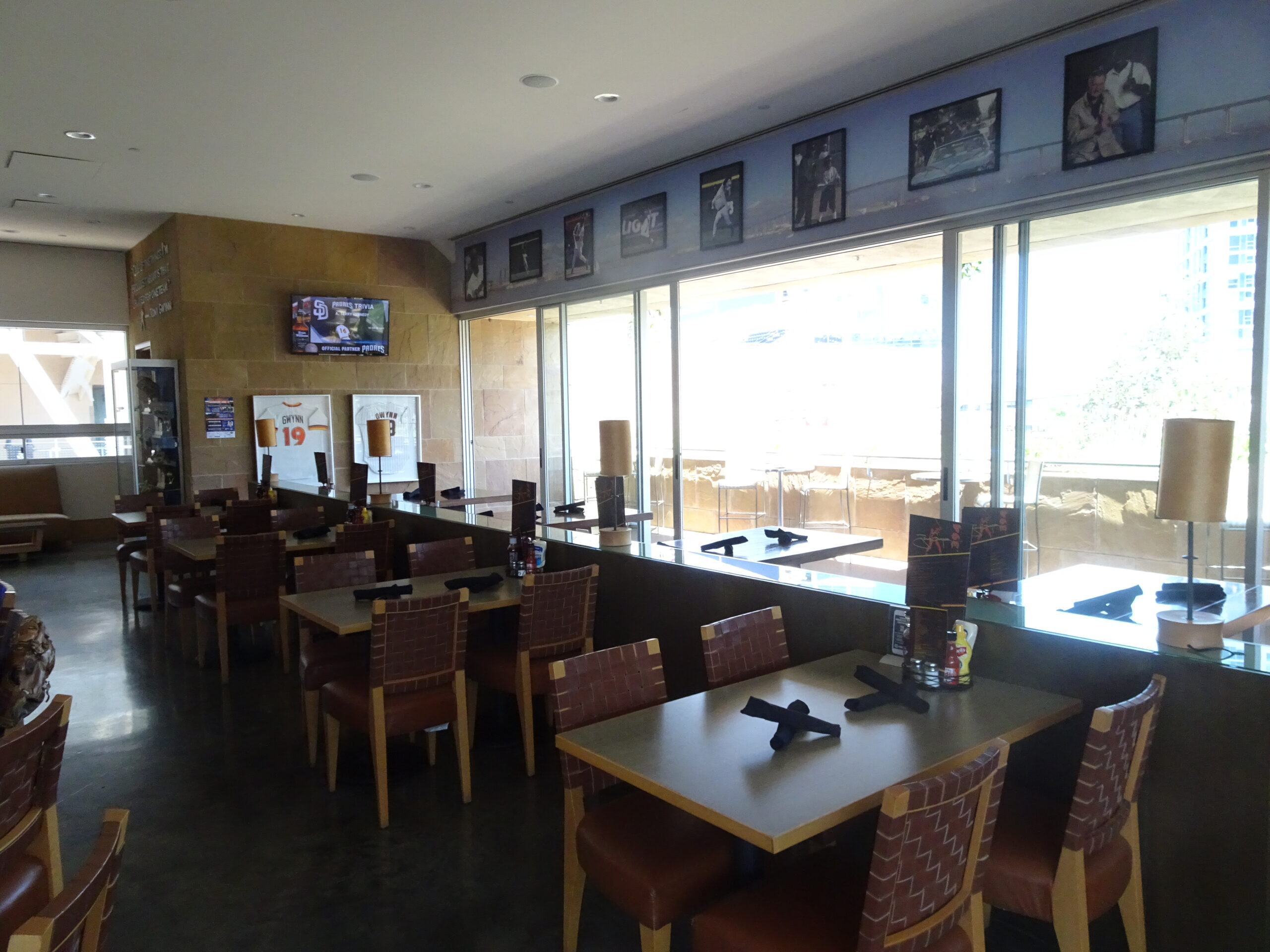
This is a low-key reason to love Petco Park. It’s the Anti-Yankee Stadium. Mezzanine “club levels” are a staple of ballparks that opened from 1991 to 2012, and Petco Park’s version was the exclusive Toyota Terrace Level. In the early 2010s, the Padres opened it up to all ticketed fans. The new Coronados Club is premium, but the sushi bar, Broad and Brew bistro, and Club 19 (pictured above) are great spaces for all fans to hang out.
State-of-the-Art Videoboards

Petco Park added a state-of-the-art videoboard in left field in 2015, replacing the Padres’ horribly outdated “Friar Vision.” The team also added an ancillary board in right field in 2018.
Seating Bowl Aesthetics Are Uniquely Defined by Vertical Beige "Suite Towers"
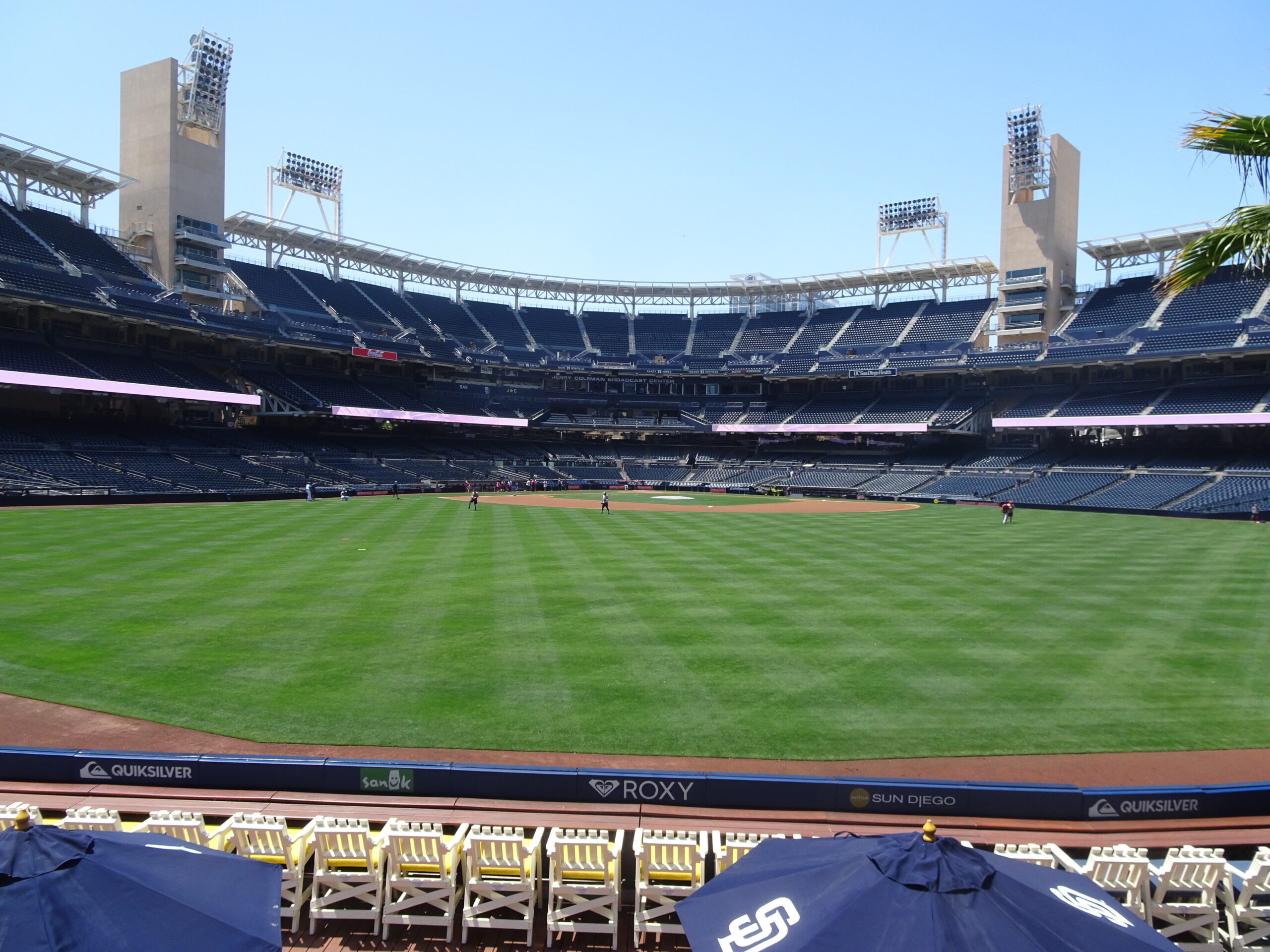
Seating bowls are pretty indistinguishable from ballpark to ballpark, but Petco is different. Beige towers holding suites split the seating bowl down the lines and import some of the exterior architectural sensibility inside.
Home Plate Club Renovated for 2023 is One of Baseball's Best and Most Exclusive Spaces
Almost every MLB ballpark houses “home plate clubs” in the first rows behind the dish. With only 222 seats and a completely remodeled restaurants, bar, and lounge, Petco Park’s Blue Shield Home Plate Club is one of baseball’s very best. On the short list of “best ballpark seats.”
Home to One of the Most Exciting Teams in Baseball, the Fans Are Back!

Throughout the 21st century, the San Diego Padres were one of baseball’s most forgettable teams. Unless Dodger fans made it their southern timeshare, Petco Park was a snooze fest. Fast forward to 2023, the San Diego Padres are MLB’s most exciting teams, with young stars from Fernando Tatis Jr. and Xander Bogaerts to Juan Soto and Manny Machado. And that comes with all the vibrancy in a park you would expect – in 2022, the Pads ranked 5th in attendance averaging 36,931 a game.
Other Misses
Disjointed Interior Aesthetics
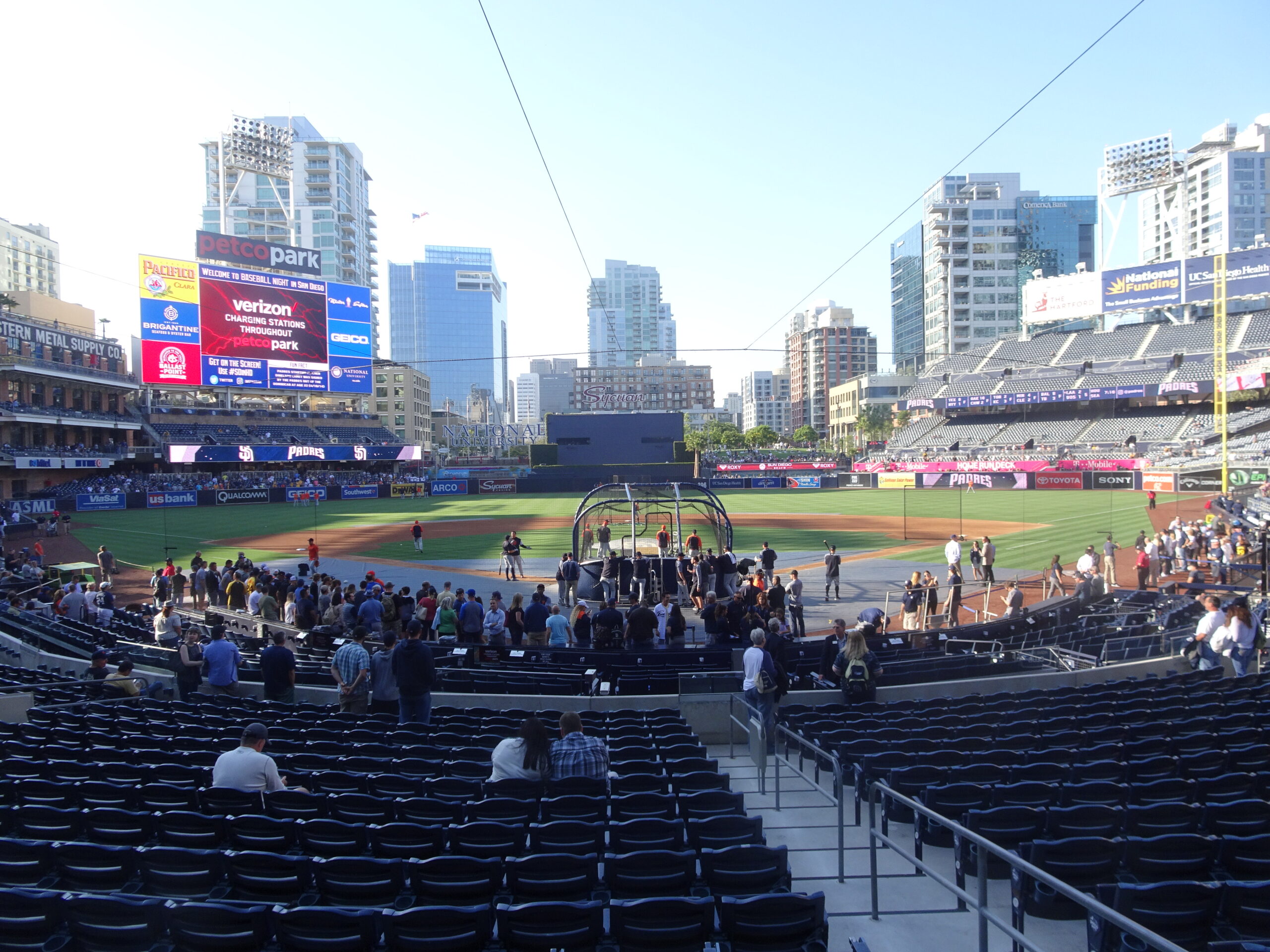
Petco Park’s final product is no doubt beautiful, so this is more of a conceptual misgiving. As a general theme, Petco Park is disjointed. Why build the park around the venerable left field warehouse from 1909, then reframe the ballpark’s overall aesthetic in stucco, sandstone, and a white steel nautical motif? That just doesn’t make sense on the drawing bored. In practice, Petco’s interior aesthetics also just feel a bit too choppy for my taste.
Many Parts of Main Concourse Closed From the Field
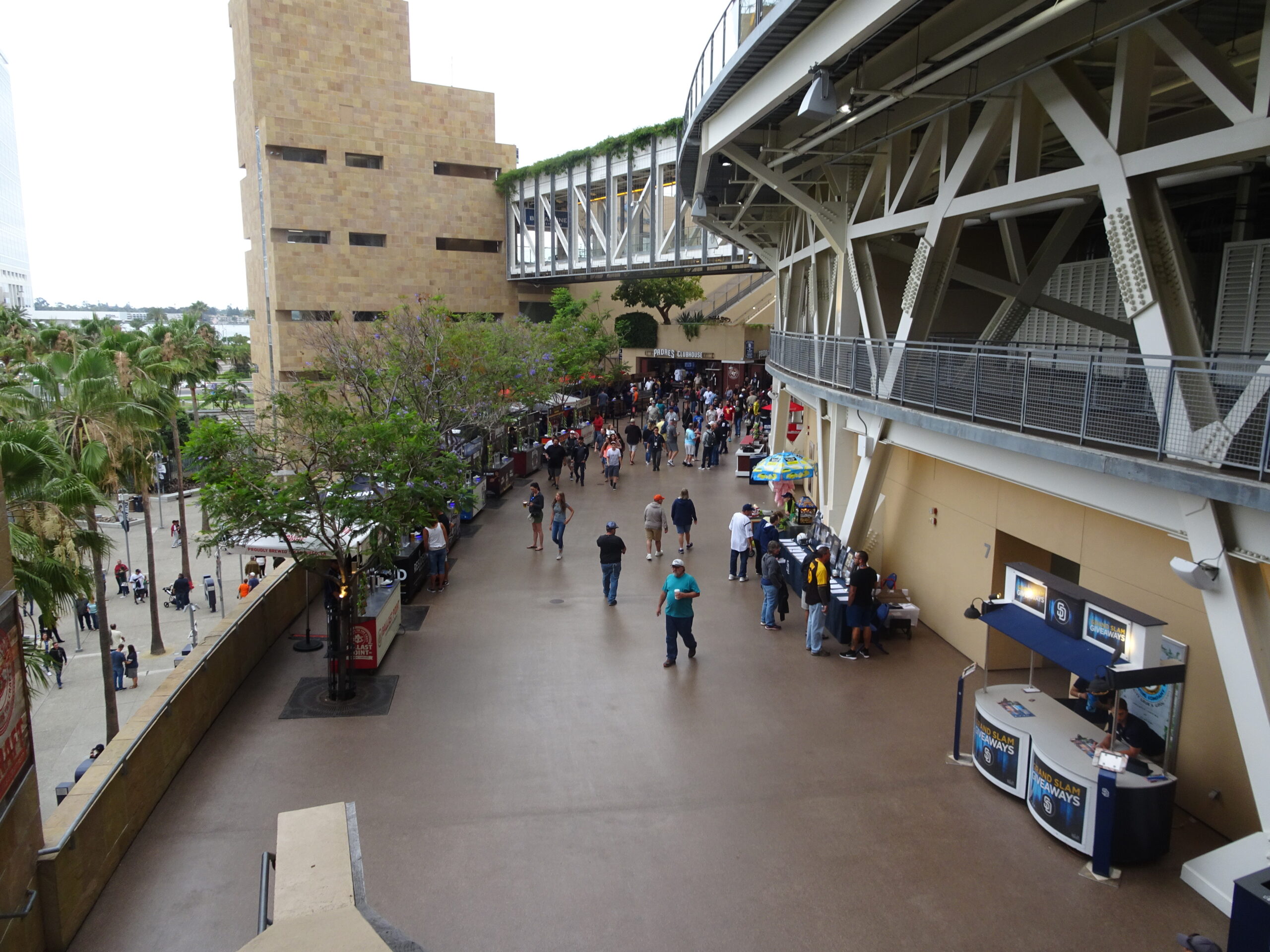
Some of Petco Park’s many innovative design elements sacrifice functionality. “Open” concourses with views of the field are a hallmark of modern-day ballparks, and Petco Park’s main concourse doesn’t sport field views throughout much of the lower bowl, notably down the first base line. The concourse is open down the third base line.
A Couple of Sections with Seats where Left Field is Obstructed by the Warehouse
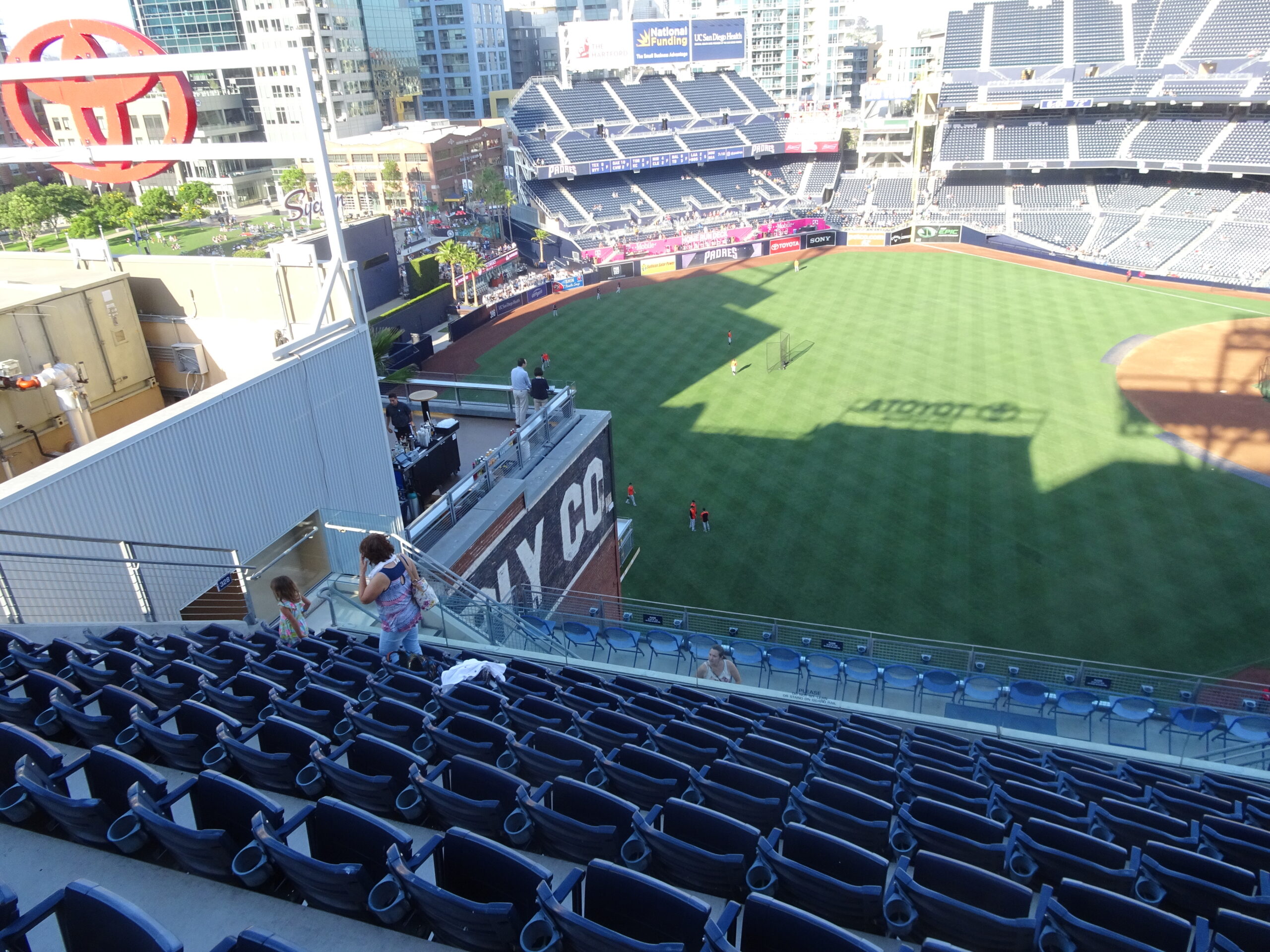
I think other ballpark enthusiasts give Petco too much flack for this, but it’s worth noting. In only a couple of sections down the left field line, part of the outfield is cut off by the warehouse.
Best of
Best Neighborhood Restaurant/Bar: Altitude Sky Lounge
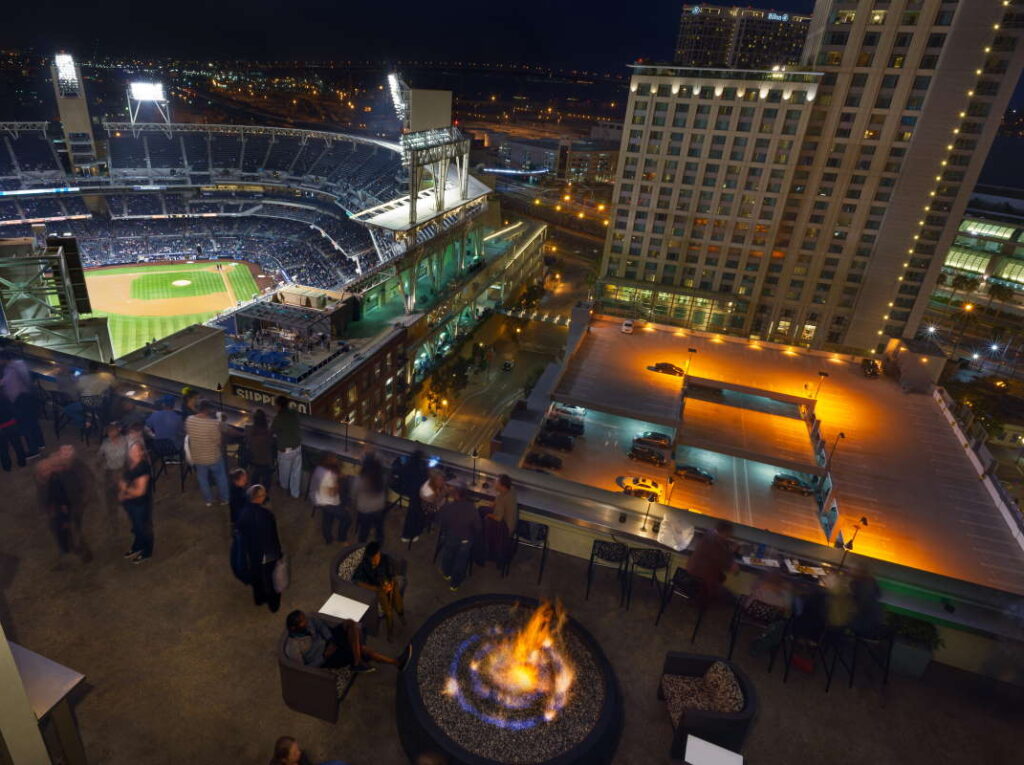
So much to choose from here. Not exactly a baseball vibe, but I’m going with the Altitude Sky Lounge atop the Marriott hotel for its bird’s-eye view of Petco Park 22 stories up. You can see the infield and are within earshot of the roar of the crowd. Just a spectacular perch with fire pits and a relaxing vibe that represents San Diego.
Best Seats: Blue Shield Home Plate Club

Objectively, the best seats are situated in the first 5 rows behind home plate in the now-sponsored Blue Shield Home Plate Club. The fully padded seats are closer to the field than the dugouts, and the fold out tables reminiscent of a domestic first class airplane seat are unique in MLB. Inside, lucky fans have access to one of baseball’s best clubs with all inclusive gourmet food and beer, wine, and liquor. The bi-level club includes two bars and two dining areas, all for 222 fans. Other perks include views into the Padres batting cages in the dining room.
Favorite Seats: Toyota Terrace Infield, sections 201-207 on first base side
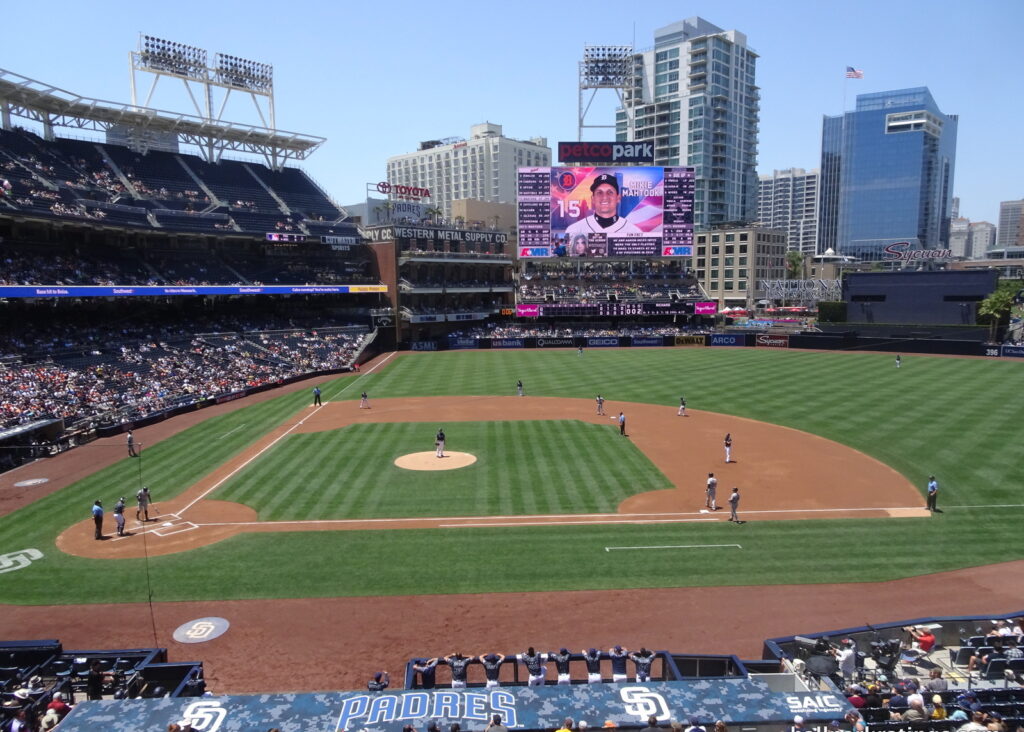
I prefer to be a tad elevated in the mezzanine, and with its superior use of cantilevers, there may be no better mezzanine seats in baseball than Petco Park’s. You feel right on top of the action from the first row. Unfortunately, there aren’t regular mezzanine seats behind home plate on the Toyota Terrace Level, so you’re best option is slightly to the first base side. This perch provides a perfect backdrop of the Western Metal Supply Co. Building. Toyota Terrace Level amenities are easily accessible from these seats.
Signature Food: Grilled Fish Tacos - Blue Water Seafood
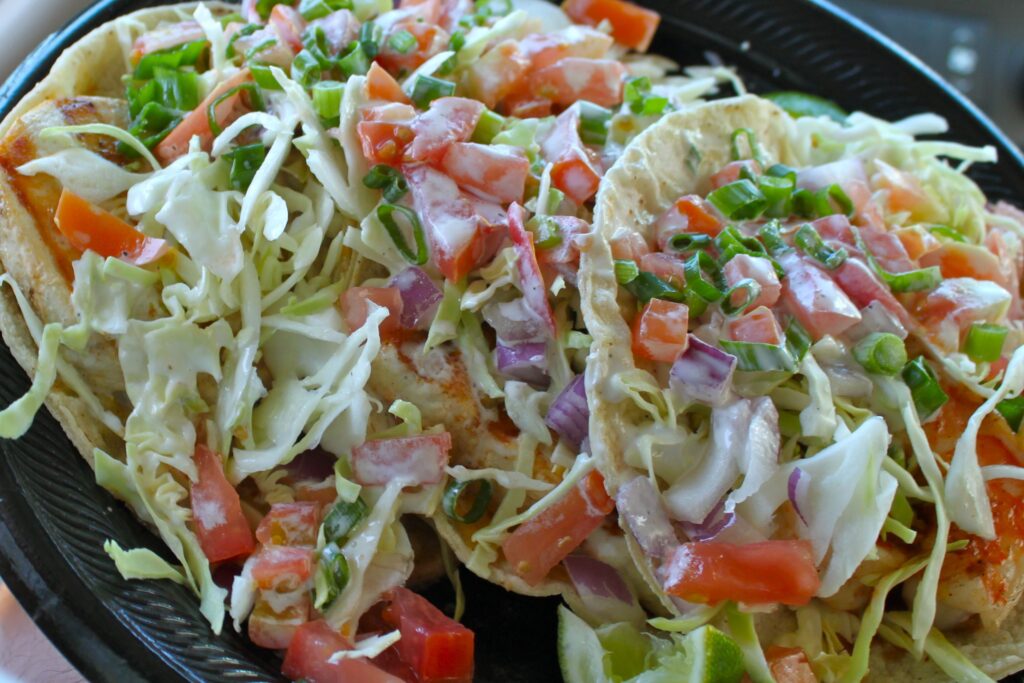
You can’t go wrong with almost anything here, including fish tacos at three other joints. But the fish tacos at Blue Water Seafood are my favorite.
Best In-Park Pregame Spot: Craft Pier
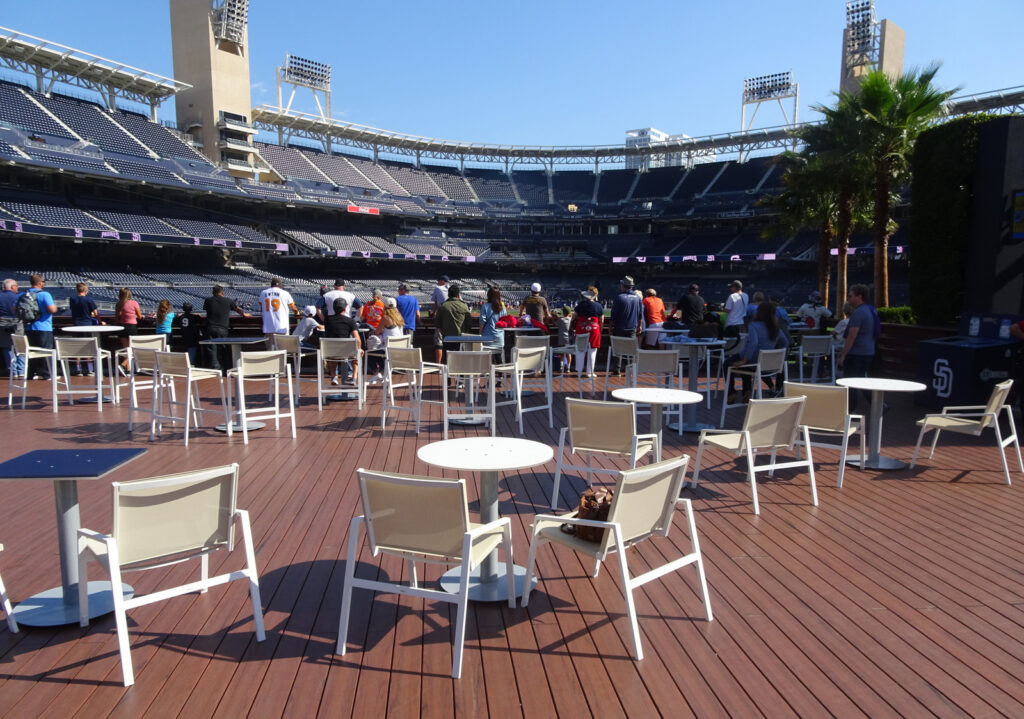
See above.
Pro Tips
COMING BEFORE OPENING DAY 2023
Bet You Didn't Know
COMING BEFORE OPENING DAY 2023